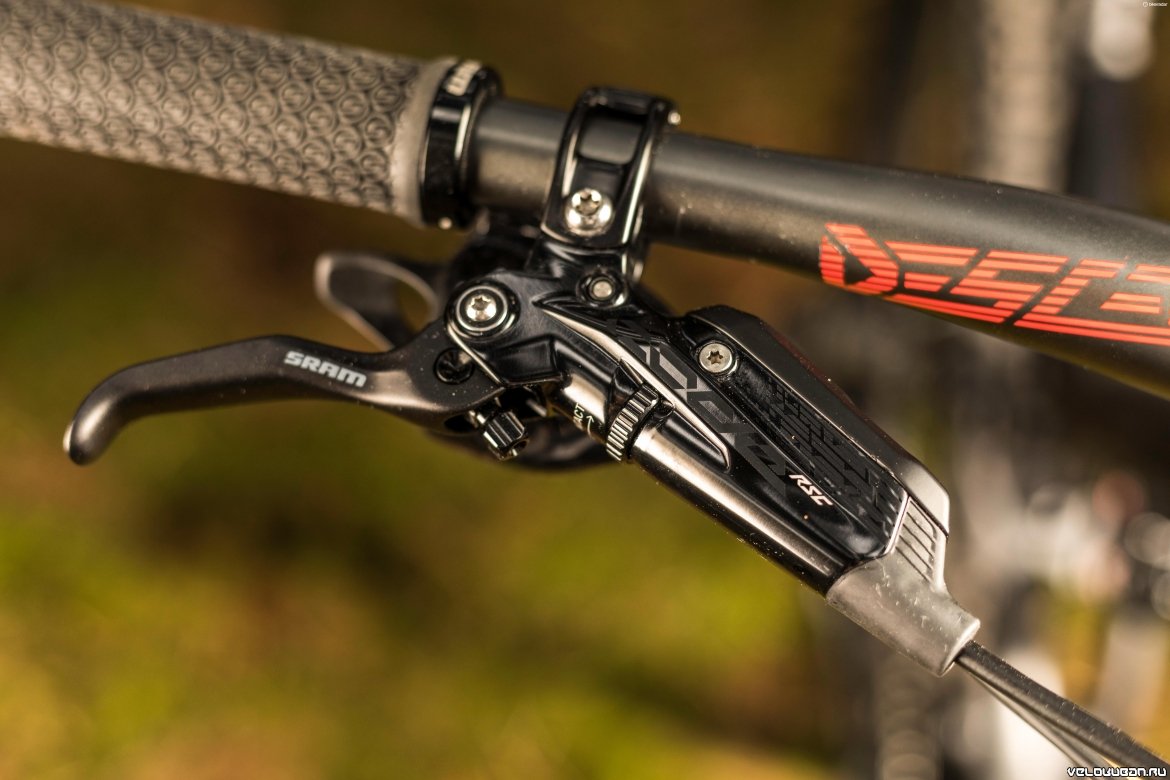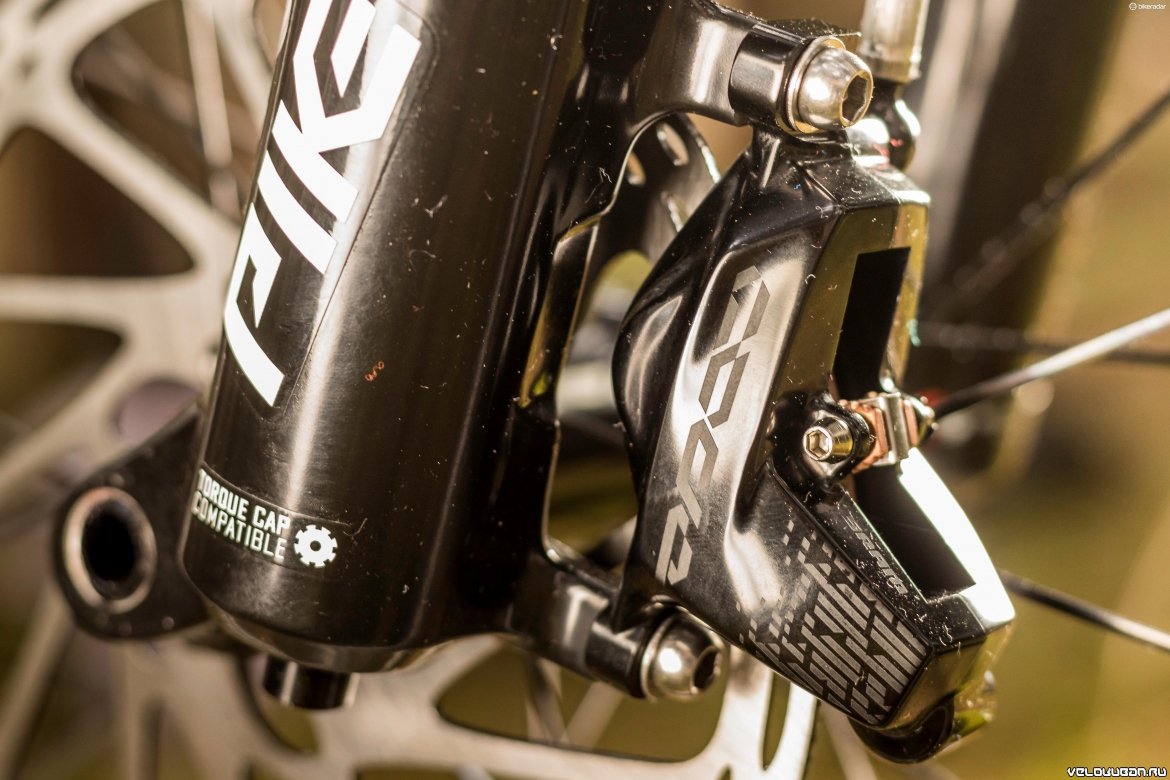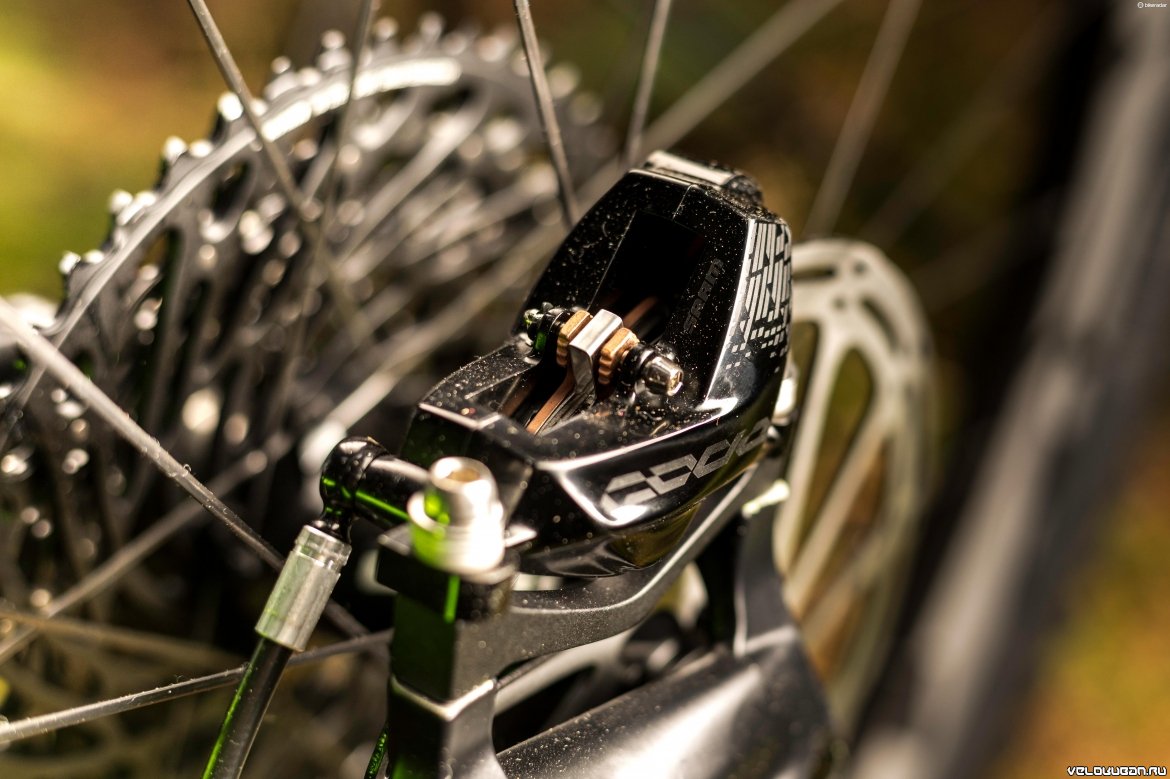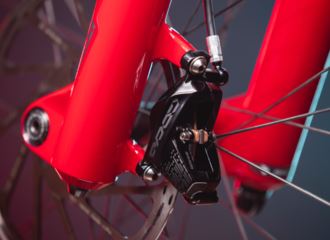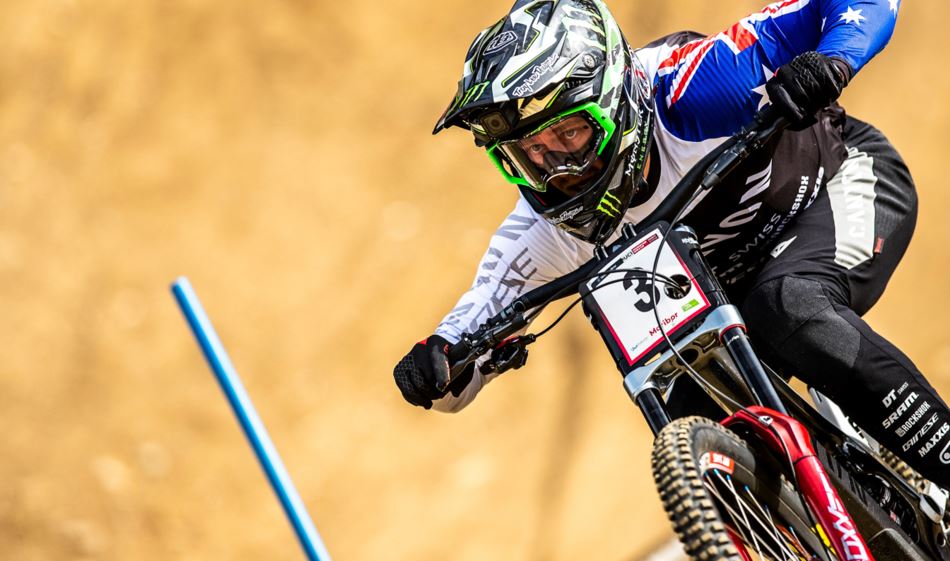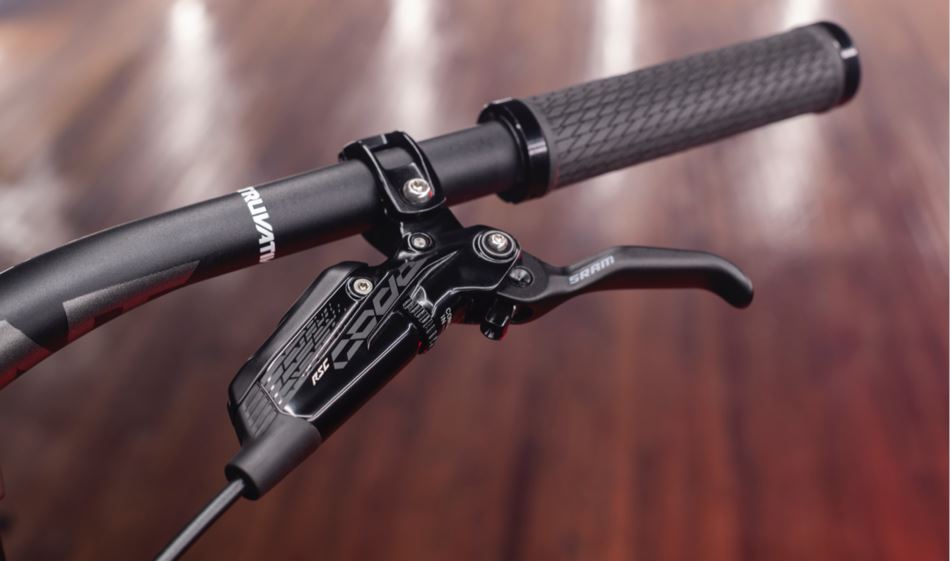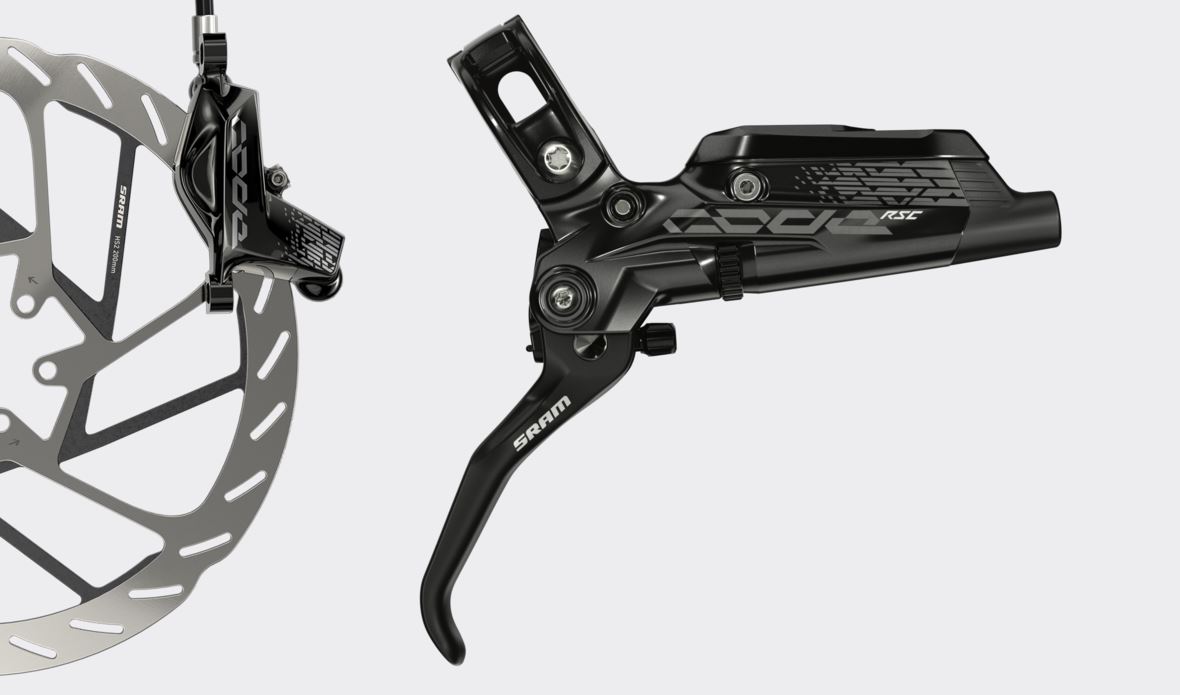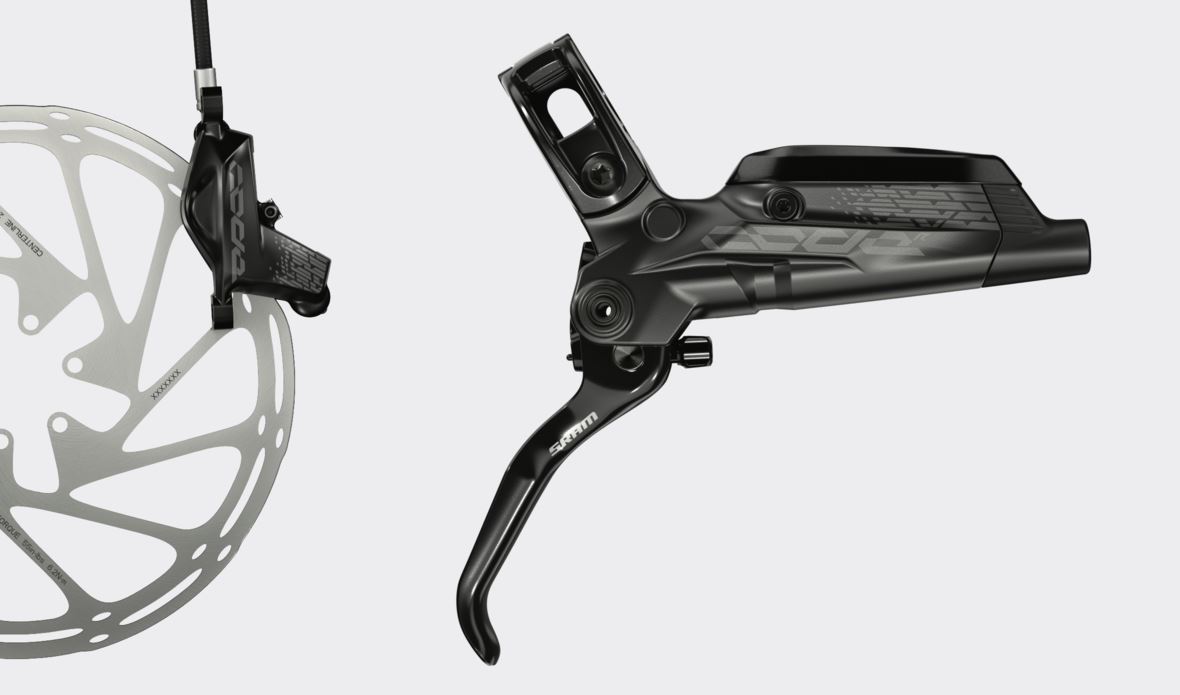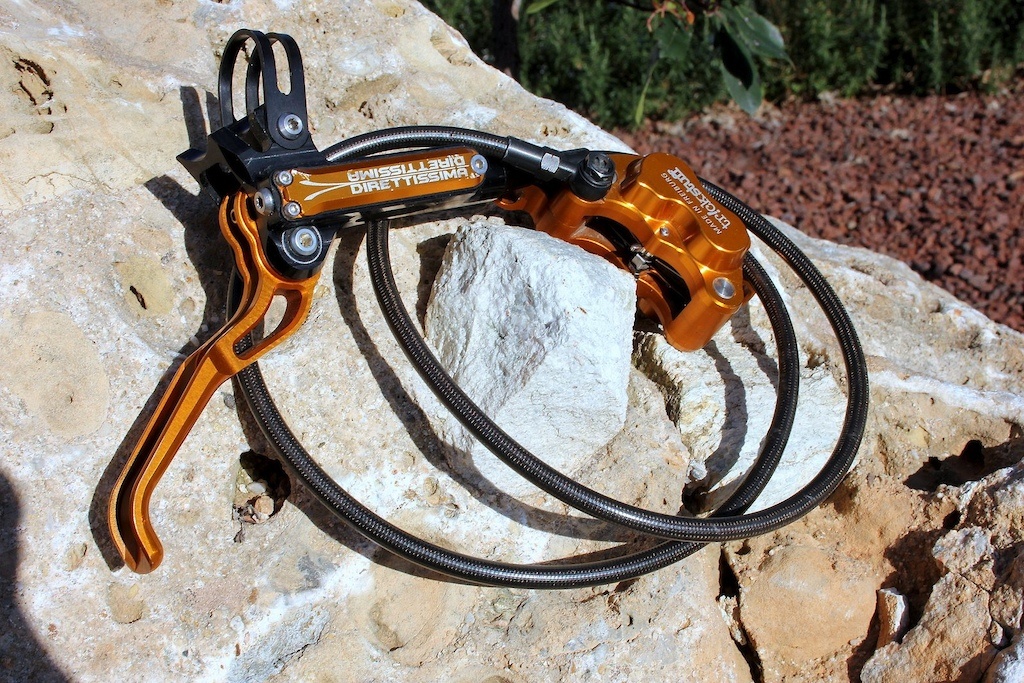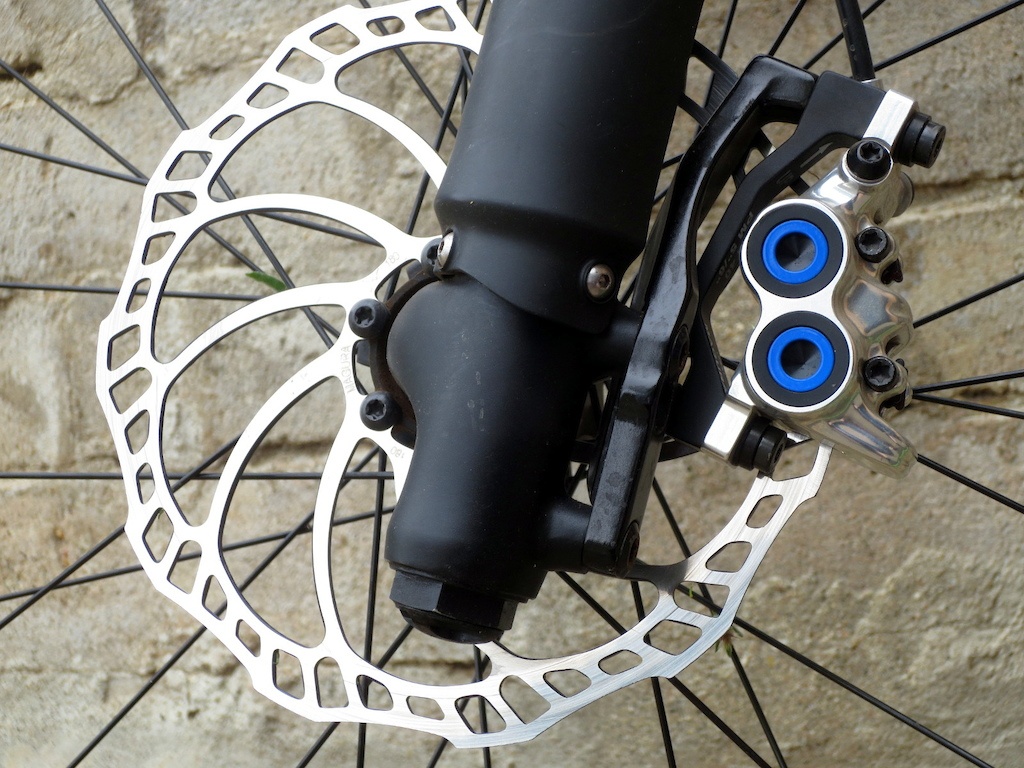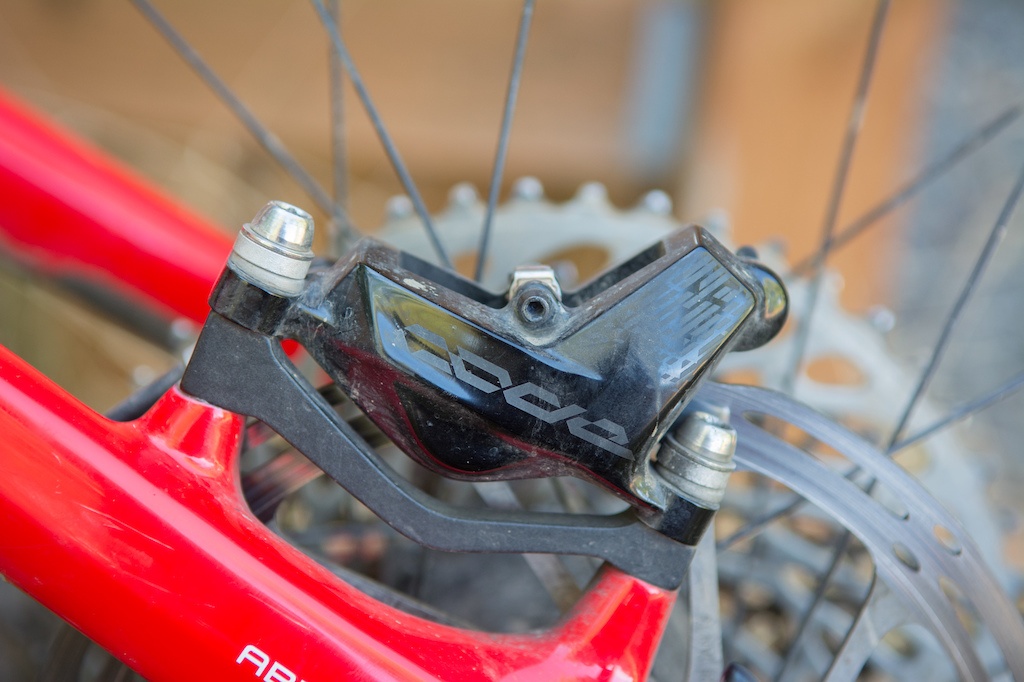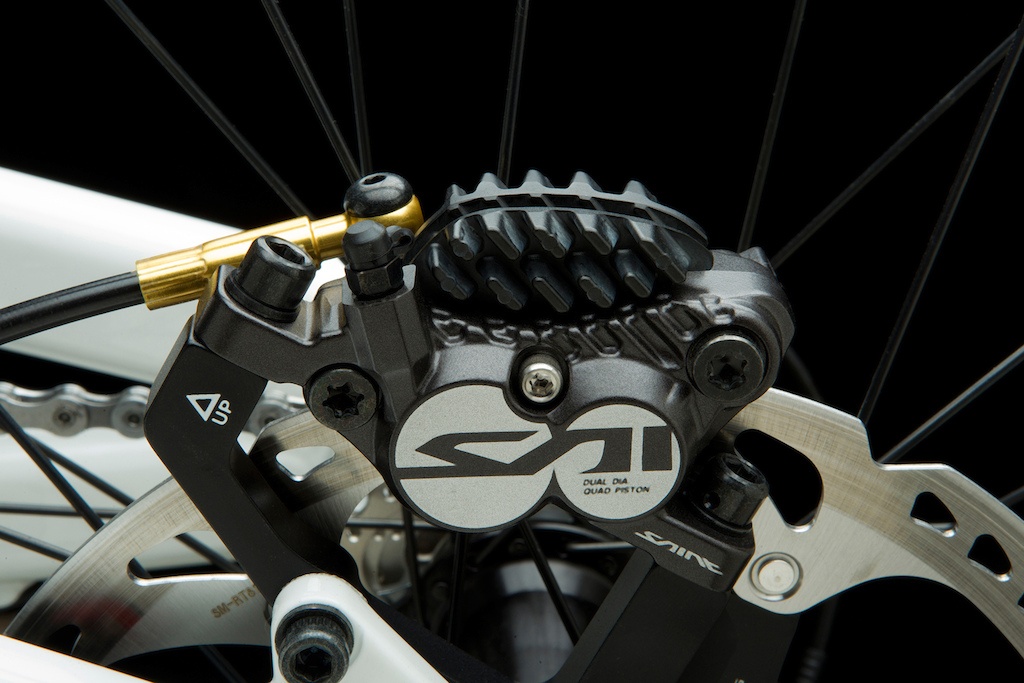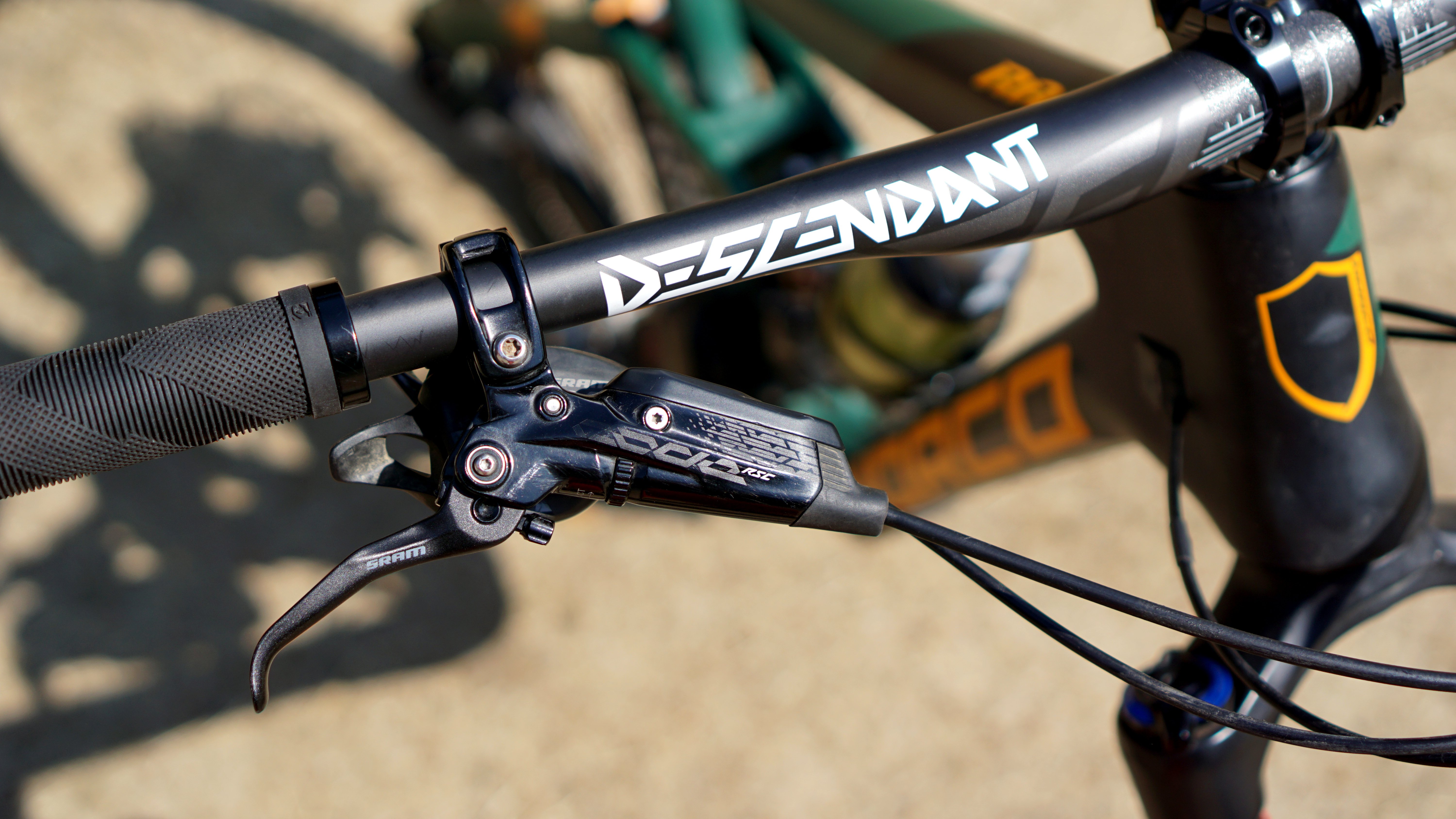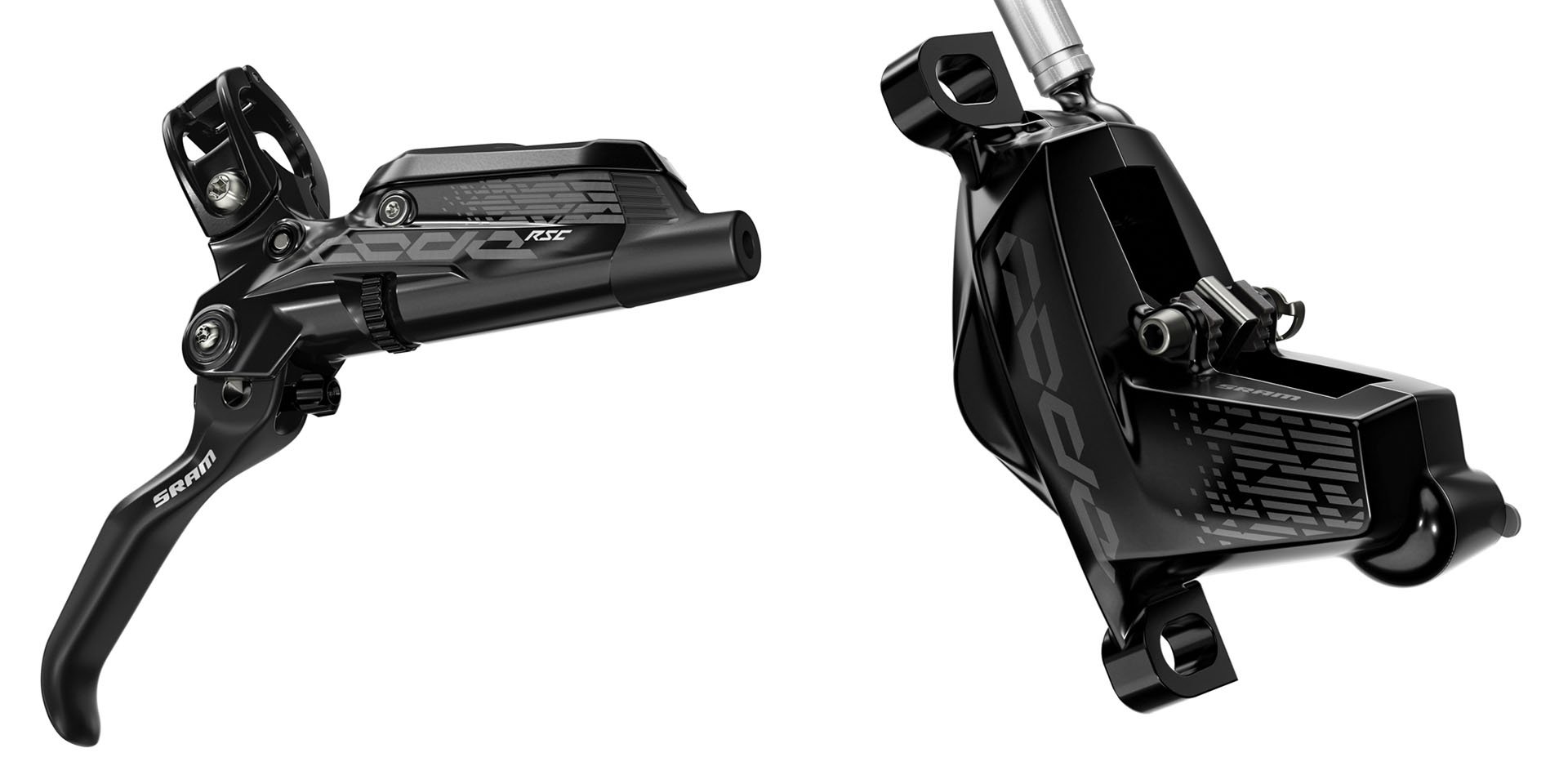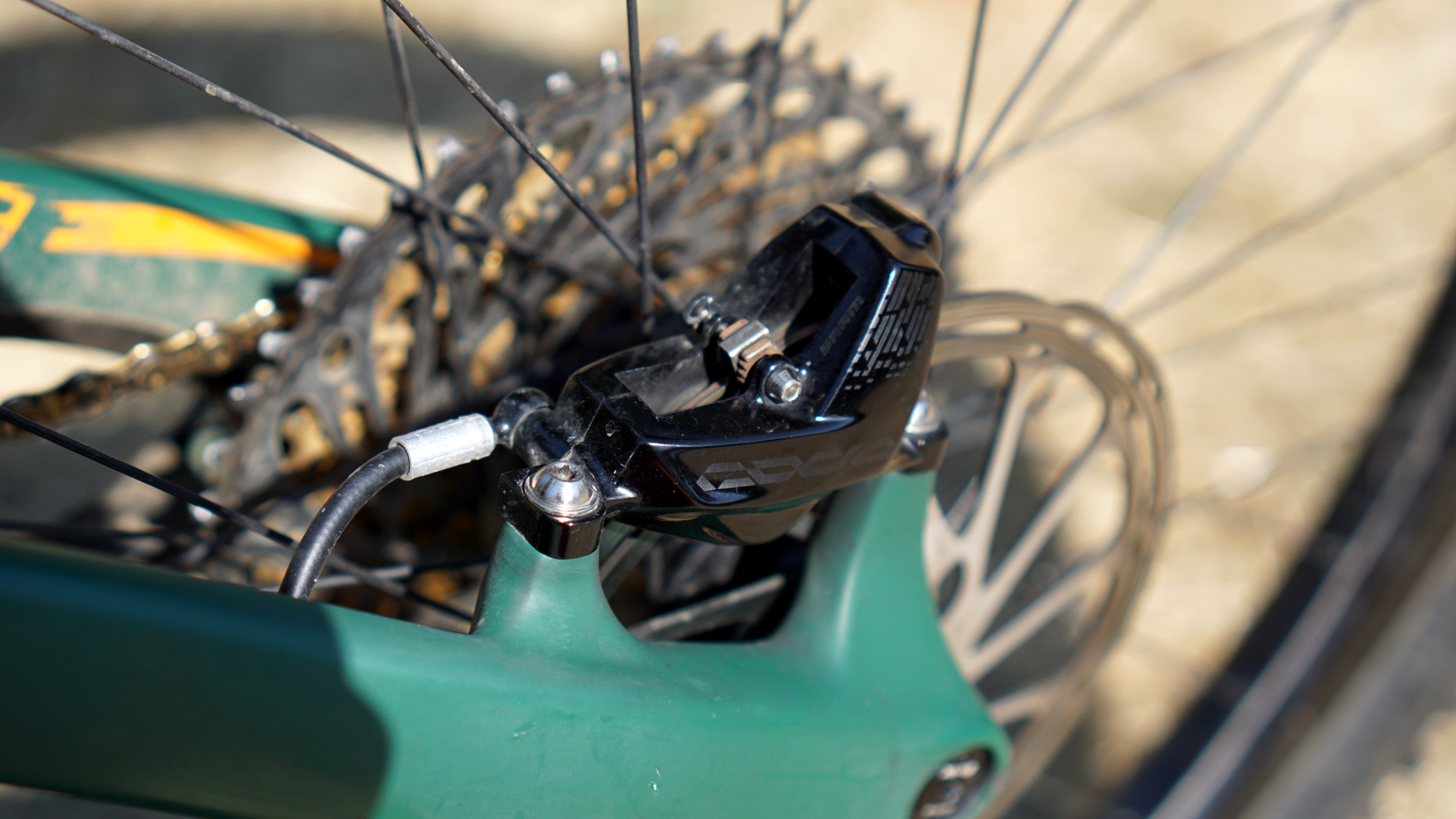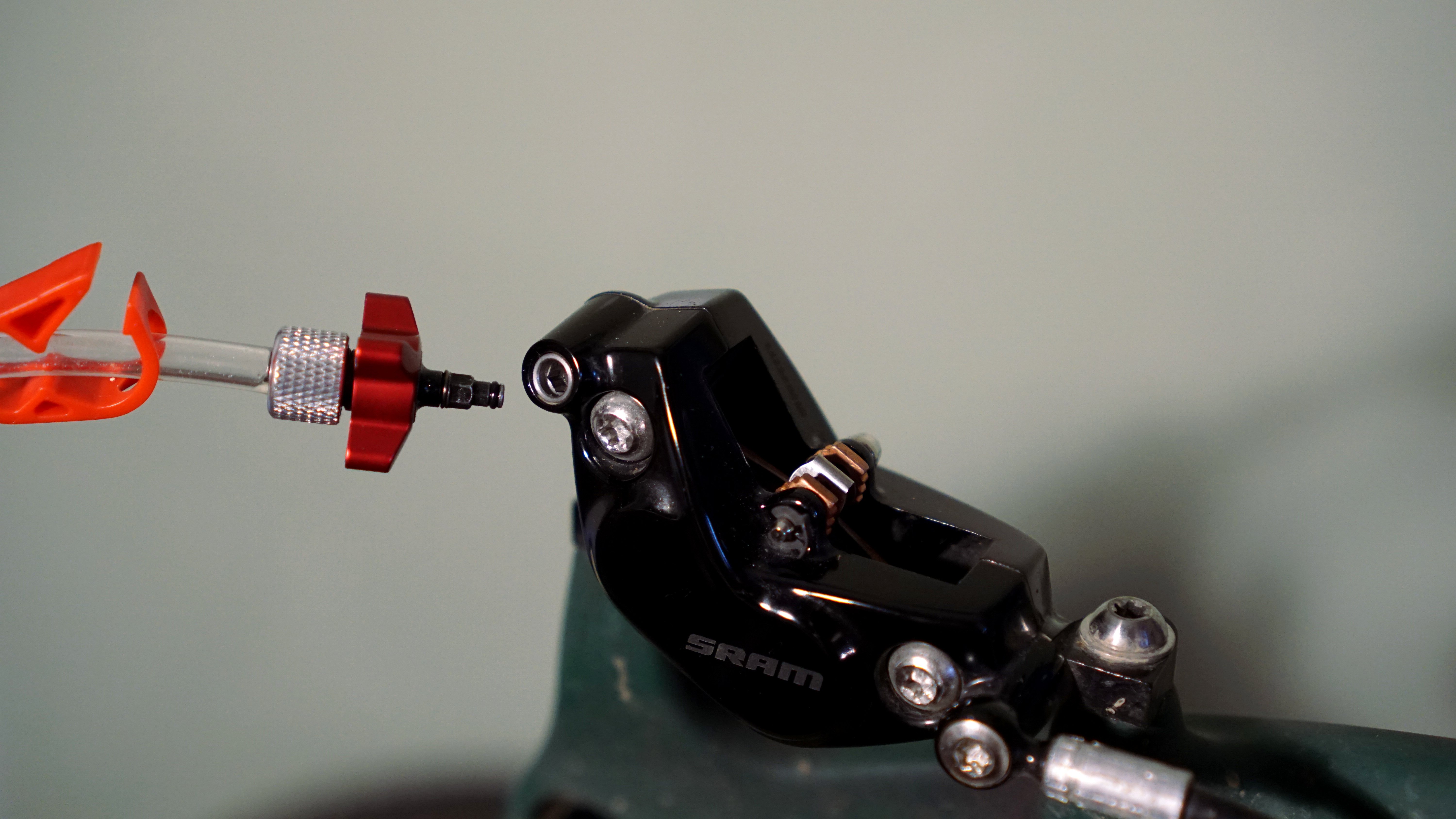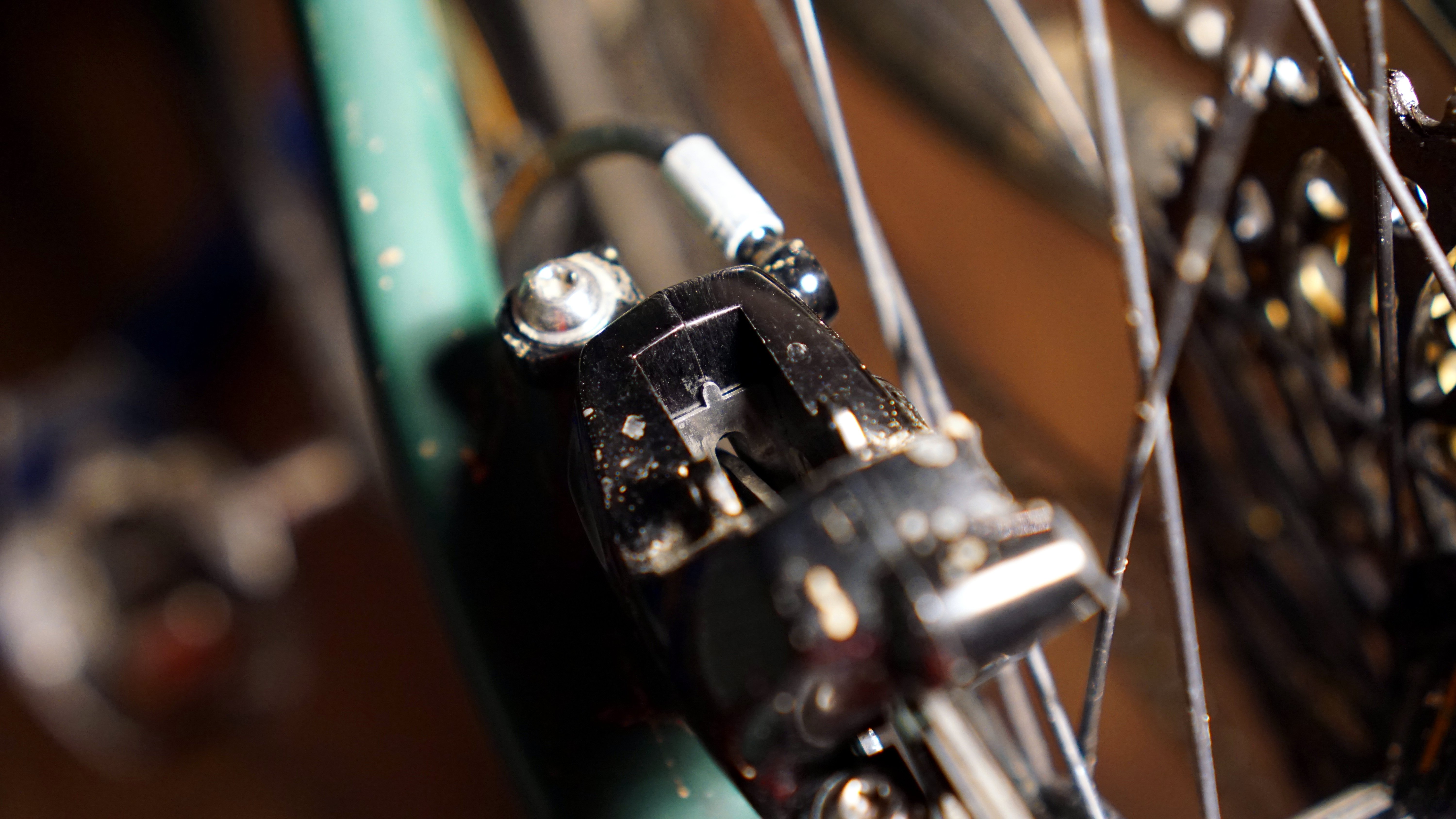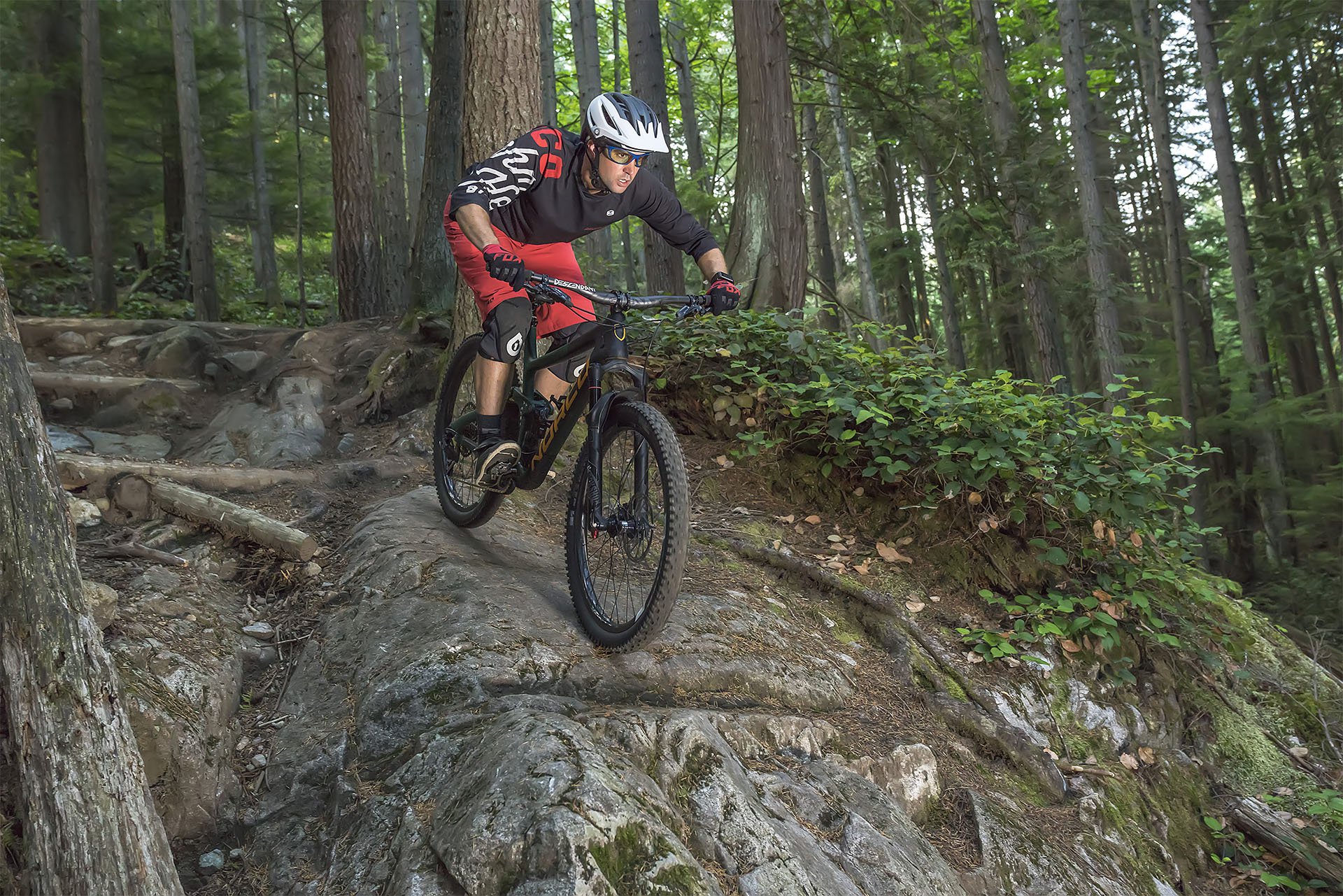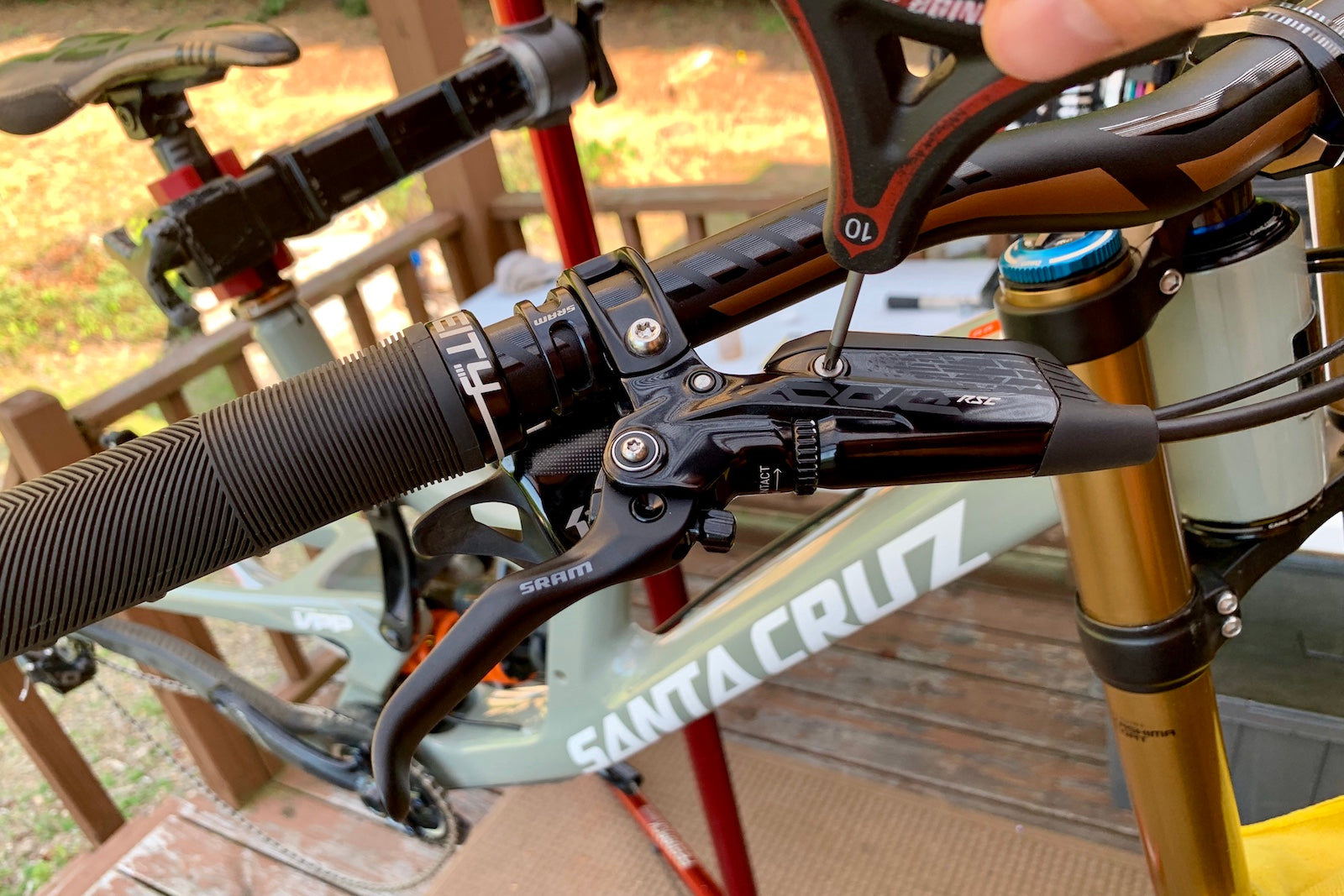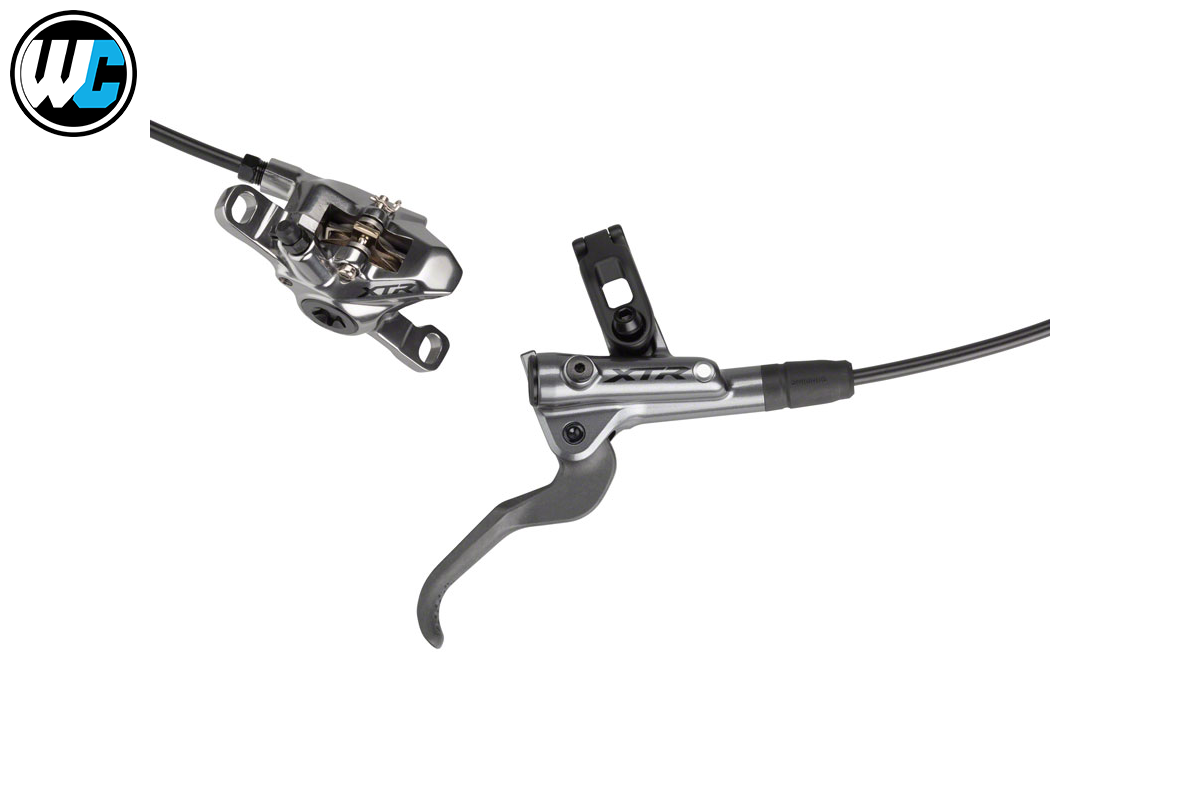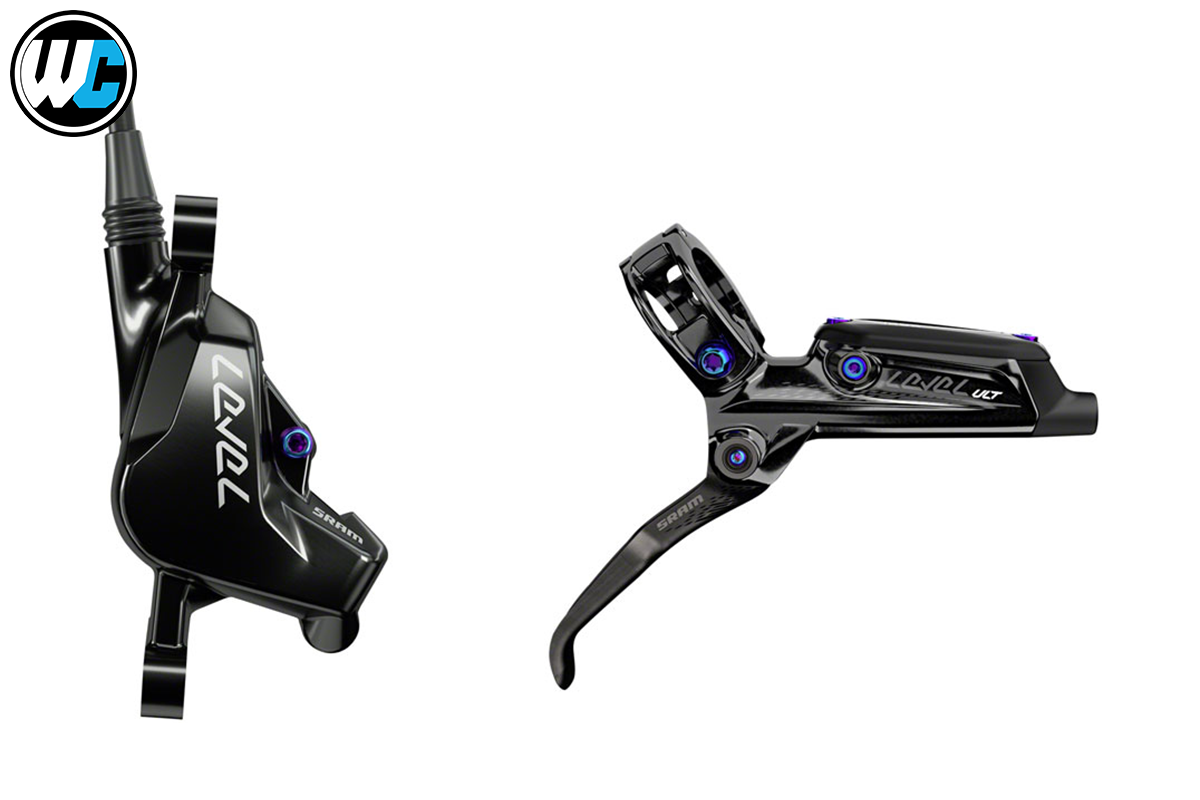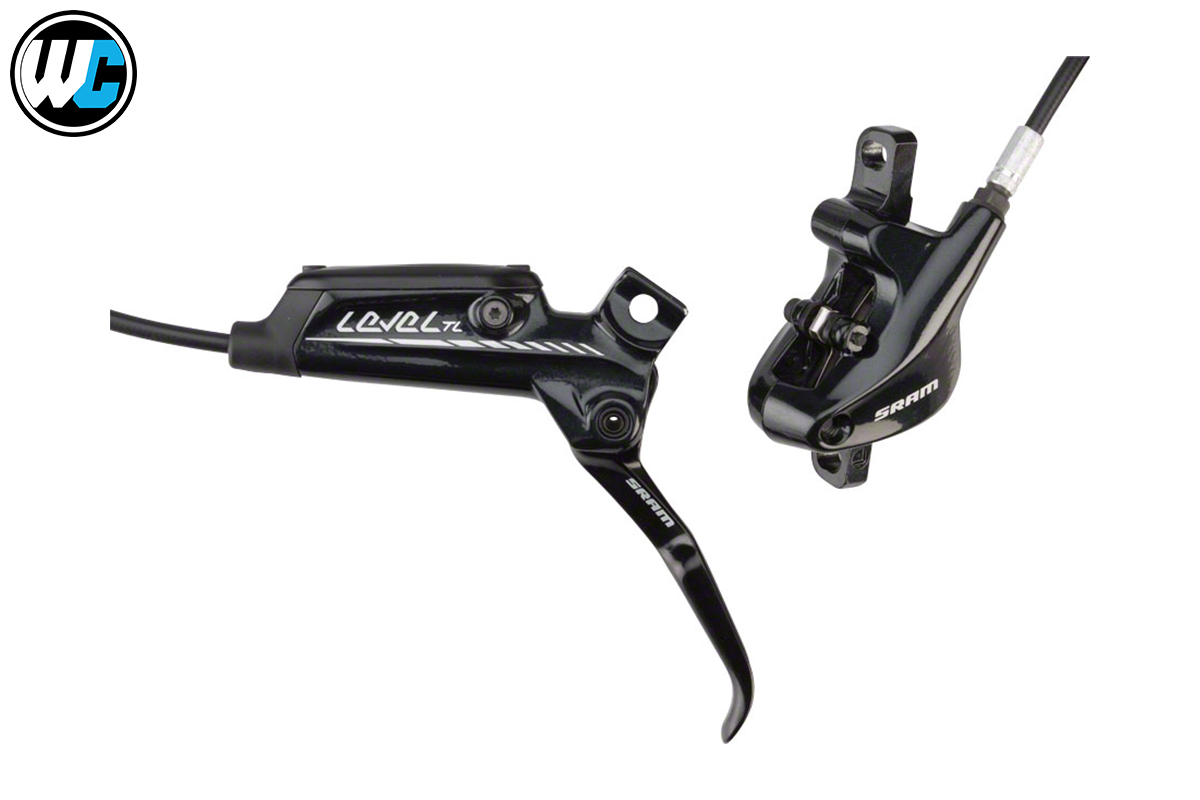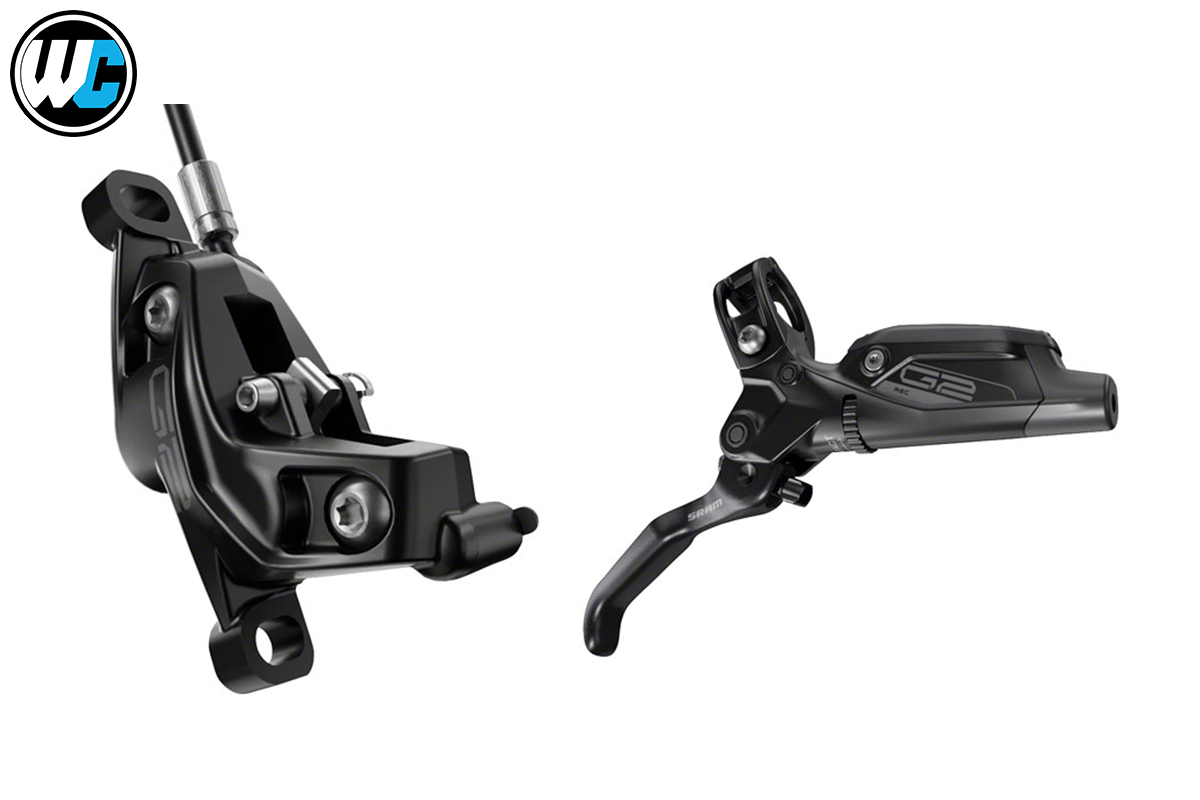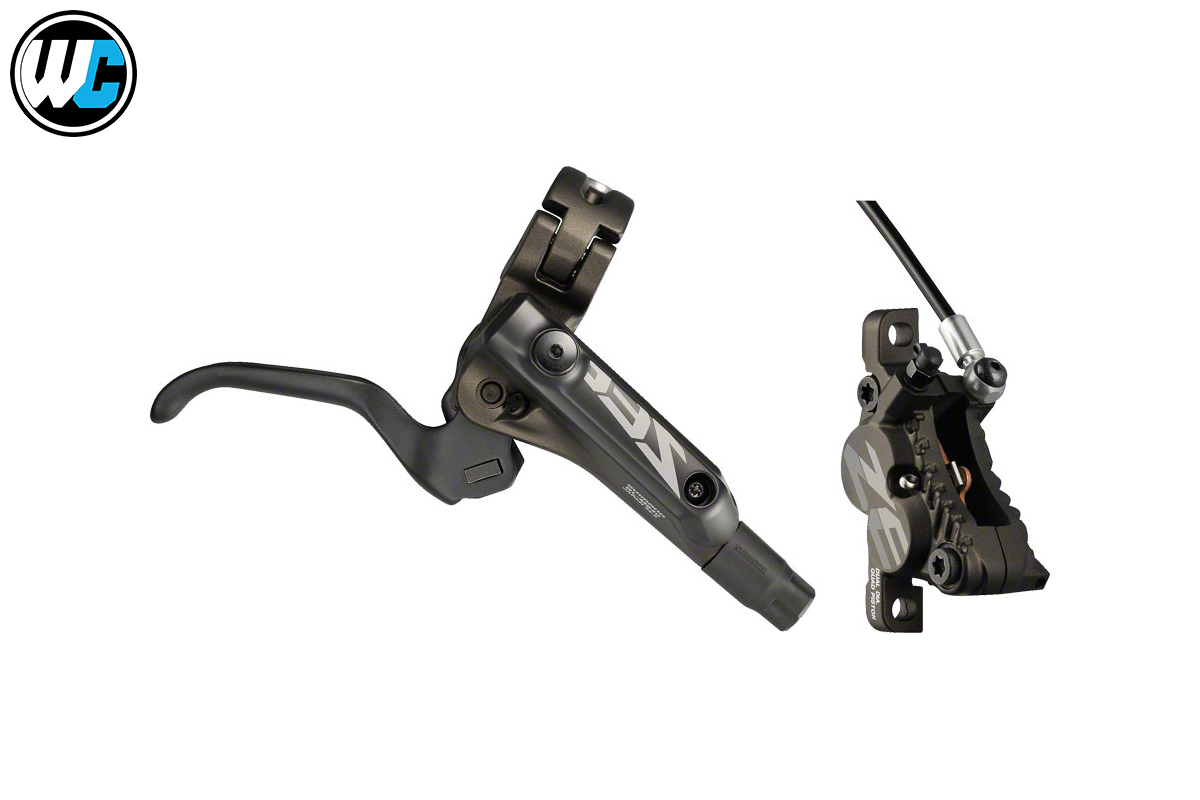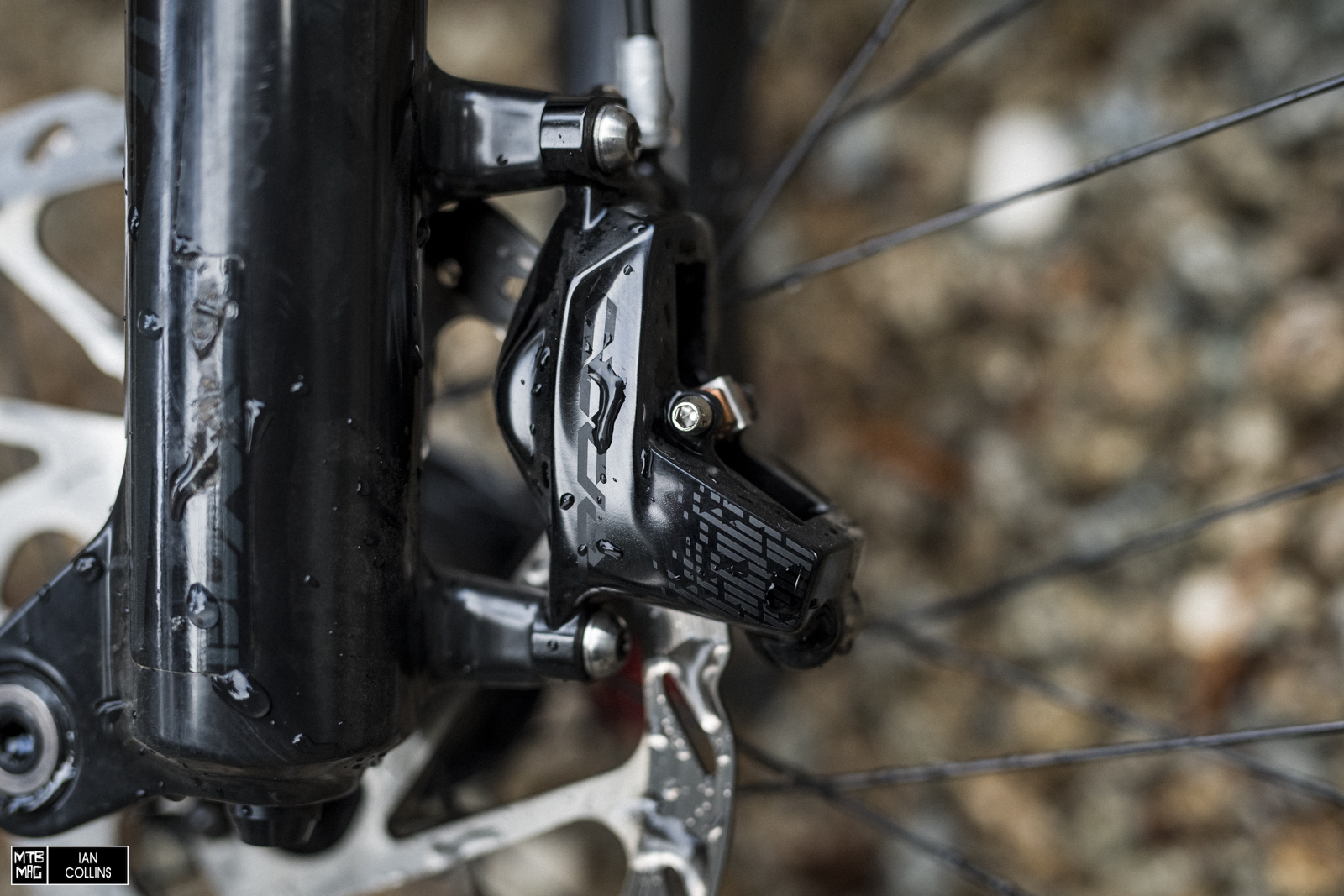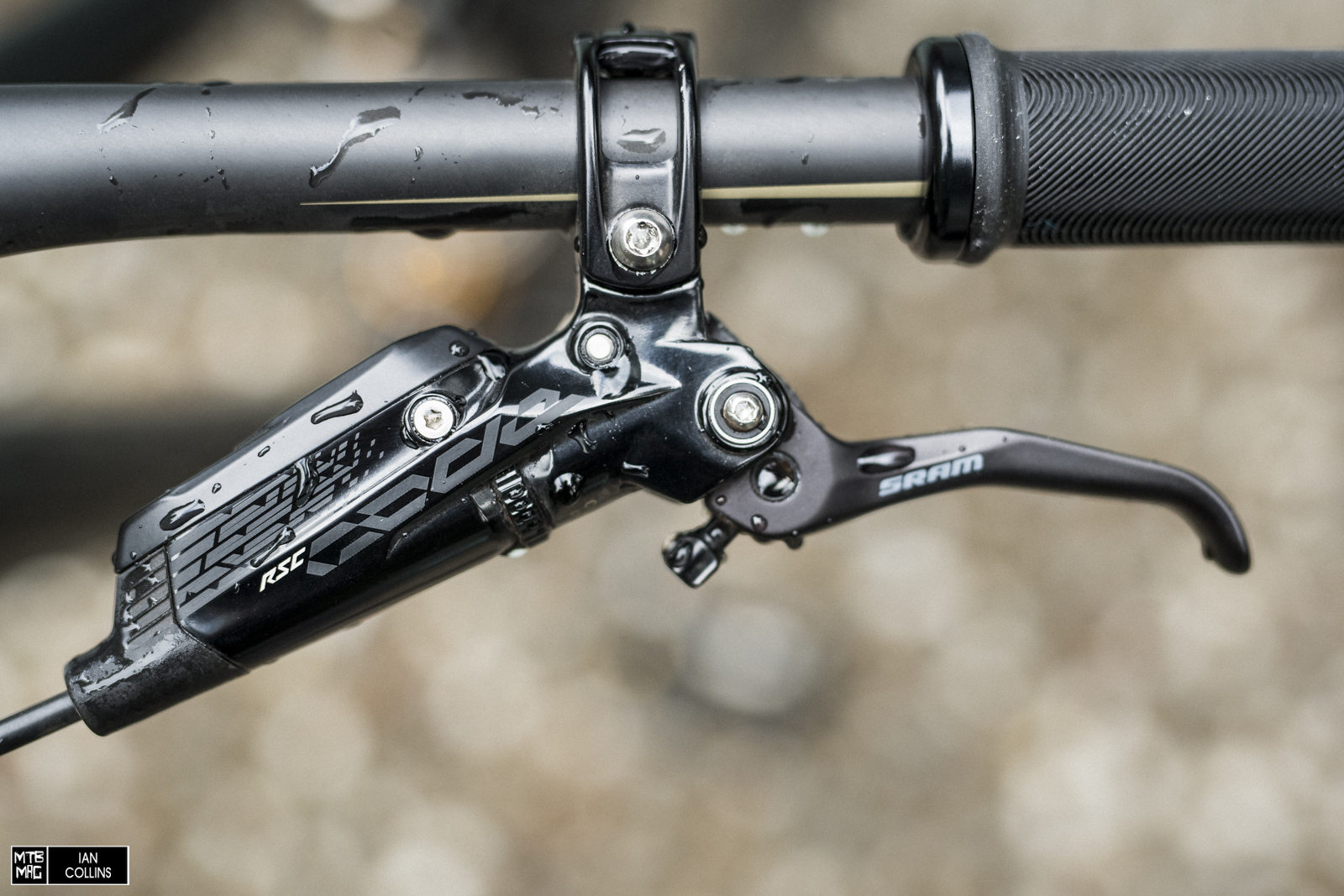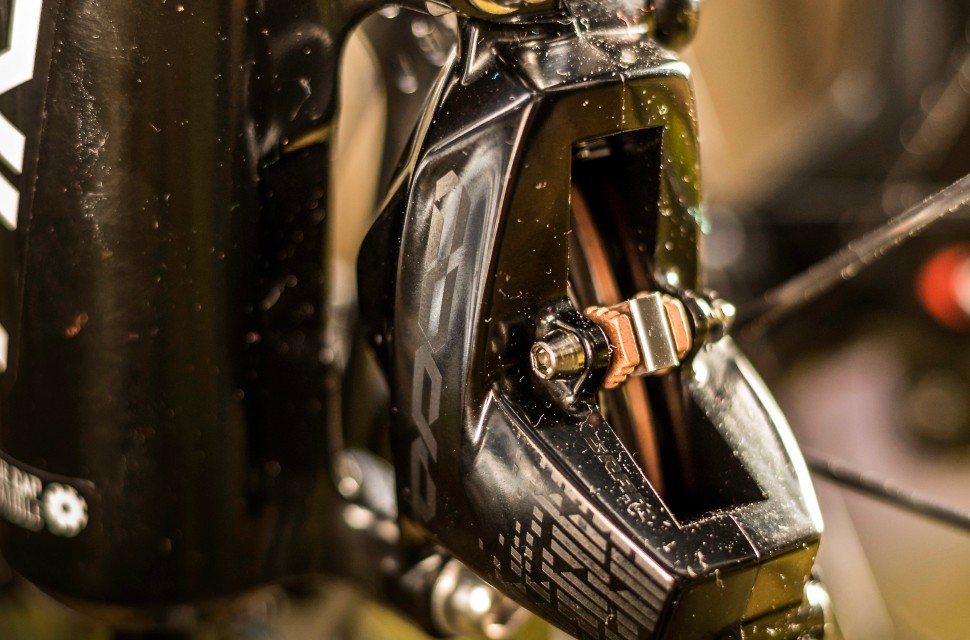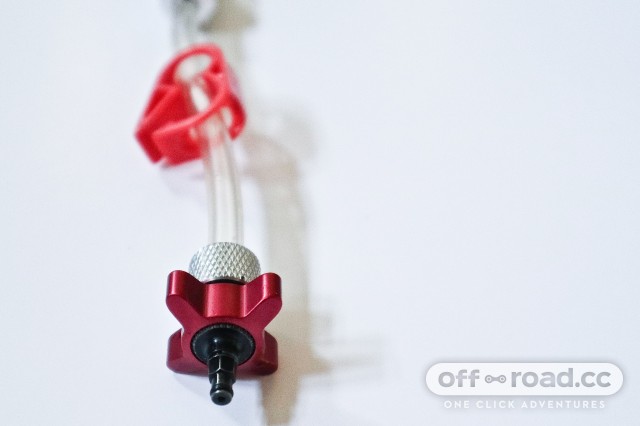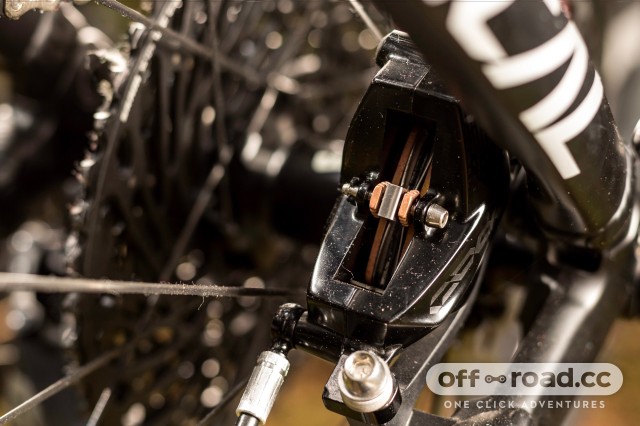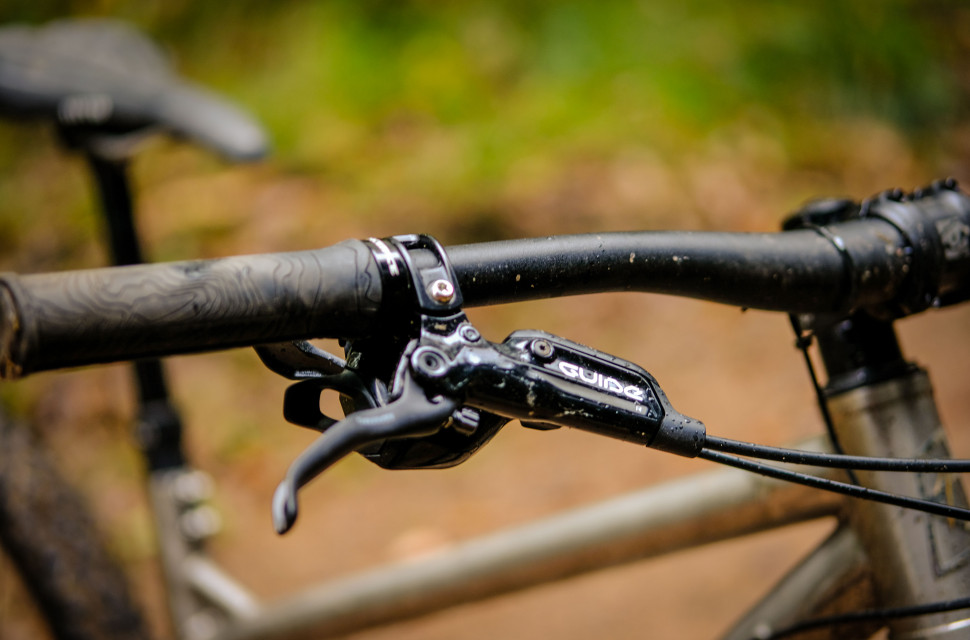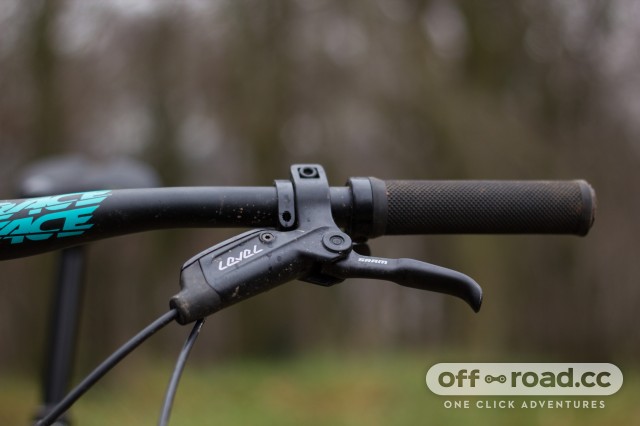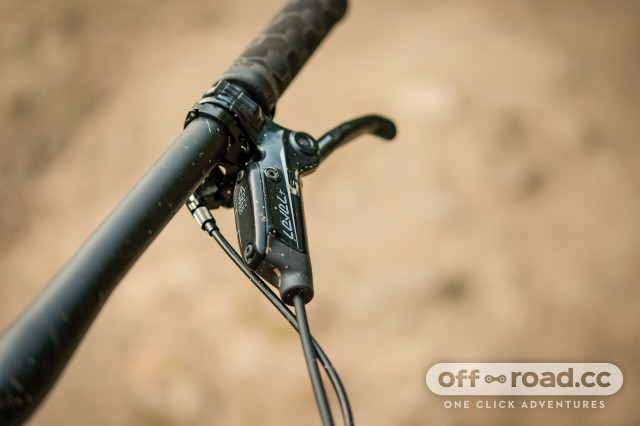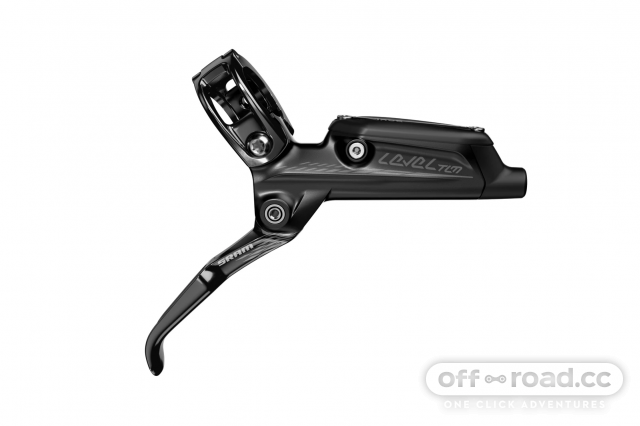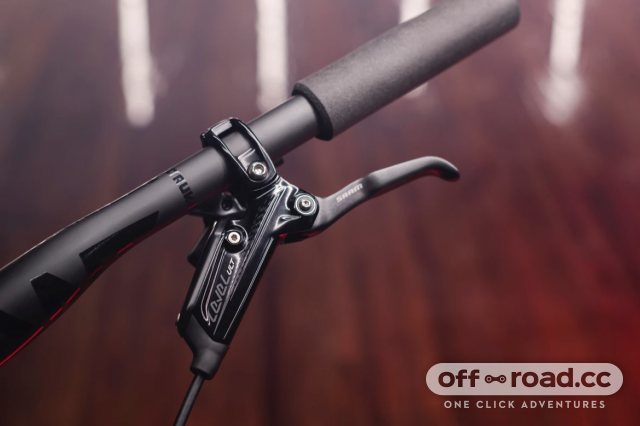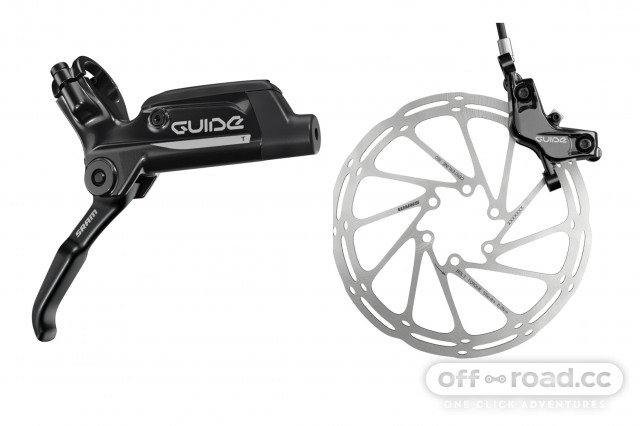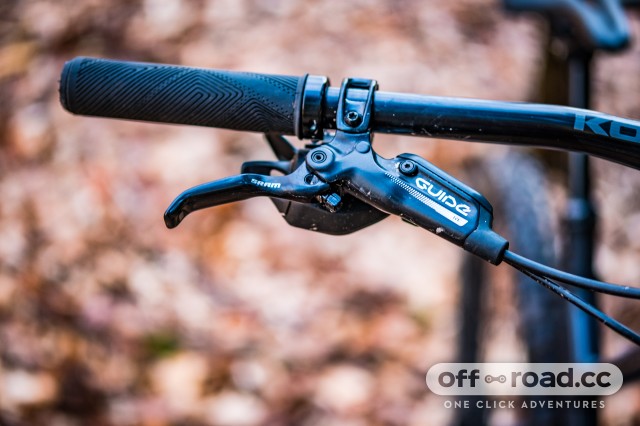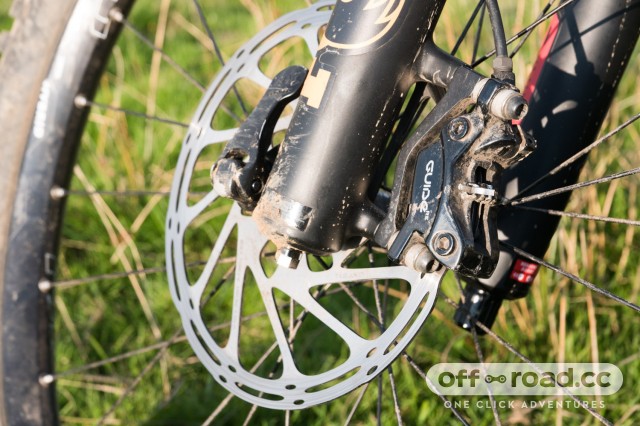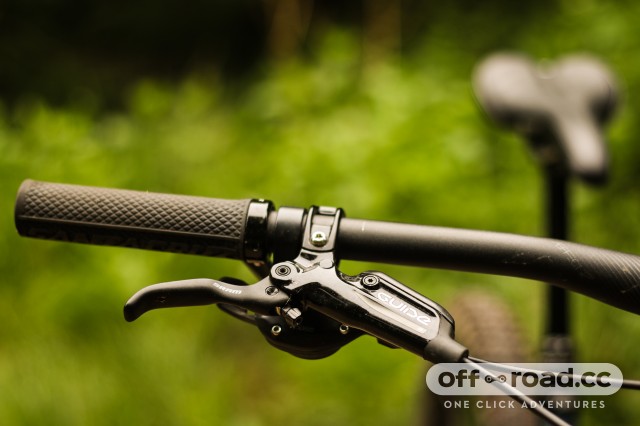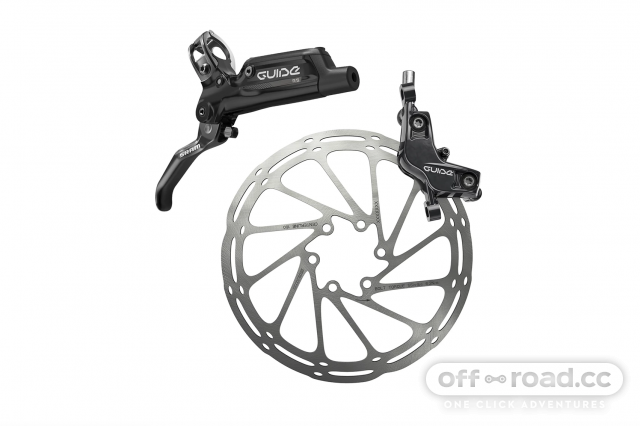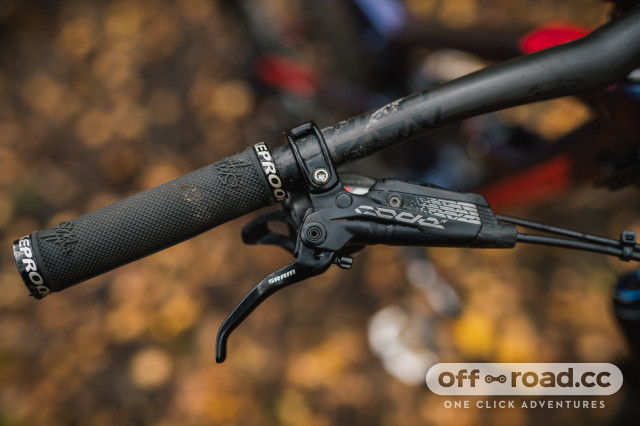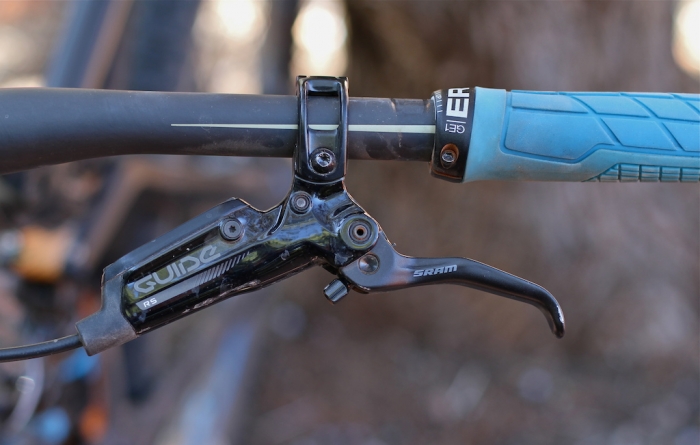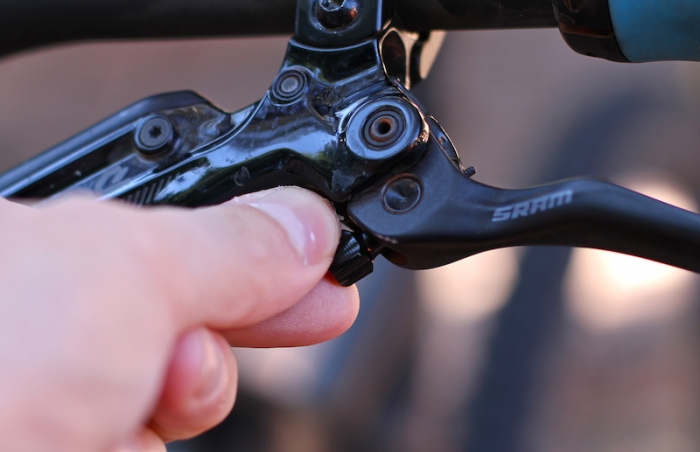Sram code rsc
Sram code rsc
Обзор тормозов SRAM Code RSC.
SRAM выпустили серьёзный якорь для гравити байков в 2017 году, в виде тормозов для е-байков Guide RE, которые были составлены из ручки Guide и старого калипера Code. Они и сейчас остаются отличным вариантом за свои деньги, но новые Code RSC — это абсолют торможения для даунхилла.
С учётом того, как хорошо принимает общественность тормоза Guide, не удивительно, что новые Code разделяют с ними много общего, в частности касаемо ощущений при их использовании. Ручка имеет аналогичную форму, ось вращения осталась близко к рулю, что делает движение рычага более естественным.
Шарнирный хомут, который отлично дружит с манетками SRAM, тоже остался на месте для надёжного удержания тормозной ручки на руле.
Также остался знакомый по Guide барашек подвода ручки на внешней стороне рычага и встроенная настройка подвода колодок, хотя форма последней была немного переработана для большего удобства. Если вы пользовались ранее тормозами SRAM или Avid, вам будет всё привычно и знакомо, если нет, то разобраться с настройками будет очень легко, и они дают ощутимые изменения.
Эксцентриковый механизм SwingLink и ручка тормоза на подшипнике даёт непревзойдённую лёгкость контроля касания и модуляции, что делает Guide лучшими тормозами для скользких поверхностей. В отличии от многих других мощных тормозов, новые Code не кусают слишком сильно, будто вам палку в колесо вставили. Это значит, что у вас будет меньше шансов уйти в занос и завалиться на скользких поверхностях.
Но полностью Code раскрываются, когда условия торможения становятся экстремальными. SRAM утверждают, что они на 15% более мощные, чем Guide. У меня нет дино, чтобы проверить, но со 180мм ротором кажется, что у вас стоит 200мм, а тормозная мощность кажется на уровне четырёхпоршневых Magura MT и Shimano Saint. С увеличенным на 30% объёмом резервуара, они отлично справятся с очень серьёзным нагревом без какого-либо изменения ощущений от работы.
Больший объём сказывается на весе — 45г лишних грамм на каждый тормоз по сравнению с Guide RSC (487г за полный набор переднего тормоза со 180мм диском). В отличии от Guide, из них может вытечь довольно много жидкости при отсоединении гидролинии, так что старайтесь перед этим снимать ручки с руля и направлять портом вверх, чтобы не давать доту вытекать.
Прокачка с новыми четырёхпоршневыми калиперами осуществляется очень легко, если вообще потребуется, так как все тормоза, которые через меня прошли, были отлично прокачены и остаются такими до сих пор.
Вердикт
Вердикт: Безупречная контролируемость делает их новым эталоном для хардкорных, тяжёлых или просто сумасшедших райдеров.
Плюсы: Исключительно понятные и дружелюбные тормоза с кучей мощности и великолепным контролем, независимо от длины и безумности спуска.
Минусы: Громоздкие и тяжёлые.
Покупайте, если: Вам нужно самое постоянное, чёткое и контролируемое торможение и вы не сильно паритесь за вес.
Дисковые тормоза для велосипеда Sram CODE RSC REAR
Серия Code является самой мощной из тормозов Sram/Avid, 4-x поршневые монстры разделены всего на два вида Code R и Code RCS. Верхняя модель Code RCS отличается возможностью более тонкой настройки под своего владельца, так-же отличается конструкция курка, благодаря чему чувство тормоза куда точнее. Помимо положения ручки присутствуют регулировка момента контакта колодок и диска, и для этого не нужен специальный инструмент и прокаченным механик.
Рычаг SwingLink™, из кованого алюминия, закреплен на подшипник.
Корпус ручки PiggiBack™, из кованого алюминия, к с технологией Expandable Bladder™, которая не дает воздуху скапливаться в резервуаре и гидролинии.
Корпус суппорта, из кованого алюминия, имеет стальные пластины Heat Shield™ между суппортом и колодками, которые уберегают жидкость от перегрева.
Четыре поршня (2х16мм, 2х15мм) произведенные из фенольного пластика высокого качества.
Тормозная жидкость: DOT 5.1
Регулировки: положения ручки (Reach), момент контакта колодок с диском (Contact)
Особенности: ручка поддерживает крепление типа MatchMaker™X; Bleeding Edge™ для простого и чистого обслуживания.
В комплекте с колодками Sintered Metal на стальной пластине.
Замена колодок без инструментов, верхняя загрузка.
Список технологий модели Code R: DirectLink™, Expandable Bladder, Timing Port Closure, Bleeding Edge™, Heat Shield, MatchMaker™X
| Бренд: | Sram |
| Сезон: | 2020 |
| Возраст: | нет |
| Вес, г: | 443 |
| Примечание: | Тормозной диск и переходник в комплект не входят |
Дисковые тормоза для велосипеда Sram CODE RSC REAR
Цена со скидкой 40%
| Извините, данный товар отсутствует в магазинах вашего города. |
Наличие товара в других городах
Серия Code является самой мощной из тормозов Sram/Avid, 4-x поршневые монстры разделены всего на два вида Code R и Code RCS. Верхняя модель Code RCS отличается возможностью более тонкой настройки под своего владельца, так-же отличается конструкция курка, благодаря чему чувство тормоза куда точнее. Помимо положения ручки присутствуют регулировка момента контакта колодок и диска, и для этого не нужен специальный инструмент и прокаченным механик.
Рычаг SwingLink™, из кованого алюминия, закреплен на подшипник.
Корпус ручки PiggiBack™, из кованого алюминия, к с технологией Expandable Bladder™, которая не дает воздуху скапливаться в резервуаре и гидролинии.
Корпус суппорта, из кованого алюминия, имеет стальные пластины Heat Shield™ между суппортом и колодками, которые уберегают жидкость от перегрева.
Четыре поршня (2х16мм, 2х15мм) произведенные из фенольного пластика высокого качества.
Тормозная жидкость: DOT 5.1
Регулировки: положения ручки (Reach), момент контакта колодок с диском (Contact)
Особенности: ручка поддерживает крепление типа MatchMaker™X; Bleeding Edge™ для простого и чистого обслуживания.
В комплекте с колодками Sintered Metal на стальной пластине.
Замена колодок без инструментов, верхняя загрузка.
Список технологий модели Code R: DirectLink™, Expandable Bladder, Timing Port Closure, Bleeding Edge™, Heat Shield, MatchMaker™X
Code RSC
Code RSC
Meet the new standard for hard-hitting, heavy-duty braking. We added 15% extra piston power and 30% more volume in the lever reservoir, ensuring peak performance for the full run. And with SwingLink™ and Lever Pivot Bearing technologies, lever feel remains smooth and progressive, no matter how hard the pull. Go deeper and grab more power.
Technology
Bleeding Edge
With this new caliper fluid circuitry, the bleed port has been moved to the bottom of the caliper, and all four piston bores can communicate. This way, during bleeding fluid naturally fills the caliper, resulting in an easier, more consistent bleed.
Contact Point Adjustment
Some people like the instantaneous power of a short lever throw. Others prefer the feel of a longer throw. With Contact Point Adjust, you can pick the position you want your fingers to be in when your brakes are engaged. It’s a quick and easy way to customize the feel of your brakes without having to move the pads. It’s also a way to balance both brake levers to feel exactly the same.
Lever Pivot Bearings
Precision sealed bearings at the lever pivot enhance the clean, crisp lever actuation and consistent, light, one-finger feel.
MatchMaker Compatible
Save weight and clutter on the bar with MatchMaker. This system holds SRAM levers, a number of SRAM triggers and RockShox PushLoc controls – all with one tidy, light clamp.
MatchMaker X Integrated
The MatchMaker X clamp is more than just a clamp. It’s like having Martha Stewart tidy up your cockpit. Since each clamp accepts up to three controls, you can put everything from your XLoc suspension lockout, your SRAM shifters, SRAM brake levers and AVID brake levers as well as your Reverb XLoc remote, all on two clamps. Short of genetically engineering longer thumbs, it’s the ideal way to put everything within easy reach. Just like Martha would.
PiggyBack Reservoir
The brake fluid reservoir on SRAM’s latest lever design is optimized for both performance and ease of use. The PiggyBack Reservoir offers a simple, failsafe way to manage brake fluid, and also allows for ambidextrous lever placement—so you can switch your levers on the handlebar and run them moto without hassle.
Reach Adjust
Brake lever fit and feel is a personal thing. Riders have individual positioning preferences, as well as unique hand sizes and finger lengths. Reach Adjust makes it easy to adjust your lever for maximum one-finger control for everyone.
SwingLink
Squeeze a SRAM brake lever and you notice it immediately. Less deadband. More positive engagement. A new cam system requires less lever throw to push the pads toward the rotor. That’s great, but there’s more to perfect braking performance than just power. You need control. Many brake systems minimize deadband—but at the cost of modulation. SwingLink solves that with its special cam shape. When the pads contact the rotor, the leverage rate curve is flat and smooth, avoiding that “on/off” brake feel. It’s the perfect balance of power and precision.
Timing Port Closure
A hydraulic brake’s timing port is the connection between the reservoir and the lever cylinder bore. When the lever is squeezed, a cup seal passes this area and closes the port, which pressurizes the system. SRAM’s timing port closure system features durable seals and an ultra-smooth cylinder bore finish producing dependable braking power and consistency.
Expandable Bladder
SRAM’s new brake lever design includes a reshaped bladder that helps regulate and reduce air bubbles. The bladder is specifically shaped to evacuate air from the lever and push the fluid exactly where it’s needed. The result is improved back-pressure relief, which produces dependable braking power and consistency.
Heat Shield
The stainless steel heat shield breaks the thermal connection between the pad and caliper body, reducing caliper fluid temperature by about 20°C even in the most extreme testing conditions.
Sram code rsc
With Code, we tackled the problem of all-or-nothing, on/off braking. We built an authoritative 4-piston caliper and expanded the PiggyBack reservoir, giving Code fistfuls of power. Then, we added a range of contact adjustments and pads, allowing you to determine how and when you dispense of that power. They’re your brakes. Tune them just right.
CONFIDENCE
Code dominates the World Cup — and every downhill trail worth its salt. In the gravity world, this is the pinnacle of performance, power and control.
HEAVY DUTY BRAKING
From e-MTB to Enduro and every downhill in-between, Code is the standard for nuanced modulation and confident stopping power.
MORE BRAKE
We increased our lever’s fluid reservoir by 30%, meaning braking power will feel the same at the start and end of every run — no matter how long and steep.
PISTON SIZE
The new Code uses 15mm and 16mm pistons — bumping up stopping power by 15% from previous models. It’s a small change, with a big difference.
Code RSC
Aluminum brake levers built specifically from the feedback of test riders and athletes around the world. Time tested. Podium proven.
Sealed bearings at the lever pivot offer crisp, clean lever actuation while reducing finger fatigue over the duration of the ride.
An oversized, authoritative four-piston caliper with power to spare, built to handle steep trails and aggressive braking.
Code R
Aluminum brake levers built specifically from the feedback of test riders and athletes around the world.
With an out front, tool-free reach adjust, personalization is simple. Code R hits the mark of pragmatic and refined.
All SRAM brakes are engineered for easy installation and maintenance — for both rider and mechanic.
Дисковые тормоза для велосипеда Sram CODE RSC FRONT
Серия Code является самой мощной из тормозов Sram/Avid, 4-x поршневые монстры разделены всего на два вида Code R и Code RCS. Верхняя модель Code RCS отличается возможностью более тонкой настройки под своего владельца, так-же отличается конструкция курка, благодаря чему чувство тормоза куда точнее. Помимо положения ручки присутствуют регулировка момента контакта колодок и диска, и для этого не нужен специальный инструмент и прокаченным механик.
Рычаг SwingLink™ с курком из кованого алюминия, закреплен на подшипник.
Корпус ручки PiggiBack™, из кованого алюминия, к с технологией Expandable Bladder™, которая не дает воздуху скапливаться в резервуаре и гидролинии.
Корпус суппорта, из кованого алюминия, имеет стальные пластины Heat Shield™ между суппортом и колодками, которые уберегают жидкость от перегрева.
Четыре поршня (2х16 мм, 2х15 мм) произведенные из фенольного пластика высокого качества.
Тормозная жидкость: DOT 5.1
Регулировки: положения ручки (Reach), момент контакта колодок с диском (Contact)
Особенности: ручка поддерживает крепление типа MatchMaker™X; Bleeding Edge™ для простого и чистого обслуживания.
В комплекте с колодками Sintered Metal на стальной пластине.
Замена колодок без инструментов, верхняя загрузка.
Список технологий модели Code R: DirectLink™, Expandable Bladder, Timing Port Closure, Bleeding Edge™, Heat Shield, MatchMaker™X
| Бренд: | Sram |
| Сезон: | 2021 |
| Возраст: | нет |
| Тип: | передний |
| Тип поршня: | гидравлический |
| Примечание: | Тормозной диск и переходник в комплект не входят |
Дисковые тормоза для велосипеда Sram CODE RSC FRONT
Цена со скидкой 40%
| Извините, данный товар отсутствует в магазинах вашего города. |
Наличие товара в других городах
Серия Code является самой мощной из тормозов Sram/Avid, 4-x поршневые монстры разделены всего на два вида Code R и Code RCS. Верхняя модель Code RCS отличается возможностью более тонкой настройки под своего владельца, так-же отличается конструкция курка, благодаря чему чувство тормоза куда точнее. Помимо положения ручки присутствуют регулировка момента контакта колодок и диска, и для этого не нужен специальный инструмент и прокаченным механик.
Рычаг SwingLink™ с курком из кованого алюминия, закреплен на подшипник.
Корпус ручки PiggiBack™, из кованого алюминия, к с технологией Expandable Bladder™, которая не дает воздуху скапливаться в резервуаре и гидролинии.
Корпус суппорта, из кованого алюминия, имеет стальные пластины Heat Shield™ между суппортом и колодками, которые уберегают жидкость от перегрева.
Четыре поршня (2х16 мм, 2х15 мм) произведенные из фенольного пластика высокого качества.
Тормозная жидкость: DOT 5.1
Регулировки: положения ручки (Reach), момент контакта колодок с диском (Contact)
Особенности: ручка поддерживает крепление типа MatchMaker™X; Bleeding Edge™ для простого и чистого обслуживания.
В комплекте с колодками Sintered Metal на стальной пластине.
Замена колодок без инструментов, верхняя загрузка.
Список технологий модели Code R: DirectLink™, Expandable Bladder, Timing Port Closure, Bleeding Edge™, Heat Shield, MatchMaker™X
Дисковые тормоза для велосипеда Sram CODE RSC REAR
Серия Code является самой мощной из тормозов Sram/Avid, 4-x поршневые монстры разделены всего на два вида Code R и Code RCS. Верхняя модель Code RCS отличается возможностью более тонкой настройки под своего владельца, так-же отличается конструкция курка, благодаря чему чувство тормоза куда точнее. Помимо положения ручки присутствуют регулировка момента контакта колодок и диска, и для этого не нужен специальный инструмент и прокаченным механик.
Рычаг SwingLink™ с курком из кованого алюминия, закреплен на подшипник.
Корпус ручки PiggiBack™, из кованого алюминия, к с технологией Expandable Bladder™, которая не дает воздуху скапливаться в резервуаре и гидролинии.
Корпус суппорта, из кованого алюминия, имеет стальные пластины Heat Shield™ между суппортом и колодками, которые уберегают жидкость от перегрева.
Четыре поршня (2х16 мм, 2х15 мм) произведенные из фенольного пластика высокого качества.
Тормозная жидкость: DOT 5.1
Регулировки: положения ручки (Reach), момент контакта колодок с диском (Contact)
Особенности: ручка поддерживает крепление типа MatchMaker™X; Bleeding Edge™ для простого и чистого обслуживания.
В комплекте с колодками Sintered Metal на стальной пластине.
Замена колодок без инструментов, верхняя загрузка.
Список технологий модели Code R: DirectLink™, Expandable Bladder, Timing Port Closure, Bleeding Edge™, Heat Shield, MatchMaker™X
| Бренд: | Sram |
| Сезон: | 2021 |
| Возраст: | нет |
| Тип: | задний |
| Тип поршня: | гидравлический |
| Примечание: | Тормозной диск и переходник в комплект не входят |
Дисковые тормоза для велосипеда Sram CODE RSC REAR
Цена со скидкой 40%
| Извините, данный товар отсутствует в магазинах вашего города. |
Наличие товара в других городах
Серия Code является самой мощной из тормозов Sram/Avid, 4-x поршневые монстры разделены всего на два вида Code R и Code RCS. Верхняя модель Code RCS отличается возможностью более тонкой настройки под своего владельца, так-же отличается конструкция курка, благодаря чему чувство тормоза куда точнее. Помимо положения ручки присутствуют регулировка момента контакта колодок и диска, и для этого не нужен специальный инструмент и прокаченным механик.
Рычаг SwingLink™ с курком из кованого алюминия, закреплен на подшипник.
Корпус ручки PiggiBack™, из кованого алюминия, к с технологией Expandable Bladder™, которая не дает воздуху скапливаться в резервуаре и гидролинии.
Корпус суппорта, из кованого алюминия, имеет стальные пластины Heat Shield™ между суппортом и колодками, которые уберегают жидкость от перегрева.
Четыре поршня (2х16 мм, 2х15 мм) произведенные из фенольного пластика высокого качества.
Тормозная жидкость: DOT 5.1
Регулировки: положения ручки (Reach), момент контакта колодок с диском (Contact)
Особенности: ручка поддерживает крепление типа MatchMaker™X; Bleeding Edge™ для простого и чистого обслуживания.
В комплекте с колодками Sintered Metal на стальной пластине.
Замена колодок без инструментов, верхняя загрузка.
Список технологий модели Code R: DirectLink™, Expandable Bladder, Timing Port Closure, Bleeding Edge™, Heat Shield, MatchMaker™X
Дисковые тормоза для велосипеда Sram CODE RSC FRONT
Серия Code является самой мощной из тормозов Sram/Avid, 4-x поршневые монстры разделены всего на два вида Code R и Code RCS. Верхняя модель Code RCS отличается возможностью более тонкой настройки под своего владельца, так-же отличается конструкция курка, благодаря чему чувство тормоза куда точнее. Помимо положения ручки присутствуют регулировка момента контакта колодок и диска, и для этого не нужен специальный инструмент и прокаченным механик.
Рычаг SwingLink™, из кованого алюминия, закреплен на подшипник.
Корпус ручки PiggiBack™, из кованого алюминия, к с технологией Expandable Bladder™, которая не дает воздуху скапливаться в резервуаре и гидролинии.
Корпус суппорта, из кованого алюминия, имеет стальные пластины Heat Shield™ между суппортом и колодками, которые уберегают жидкость от перегрева.
Четыре поршня (2х16мм, 2х15мм) произведенные из фенольного пластика высокого качества.
Тормозная жидкость: DOT 5.1
Регулировки: положения ручки (Reach), момент контакта колодок с диском (Contact)
Особенности: ручка поддерживает крепление типа MatchMaker™X; Bleeding Edge™ для простого и чистого обслуживания.
В комплекте с колодками Sintered Metal на стальной пластине.
Замена колодок без инструментов, верхняя загрузка.
Список технологий модели Code R: DirectLink™, Expandable Bladder, Timing Port Closure, Bleeding Edge™, Heat Shield, MatchMaker™X
| Бренд: | Sram |
| Сезон: | 2020 |
| Возраст: | нет |
| Вес, г: | 443 |
| Примечание: | Тормозной диск и переходник в комплект не входят |
Дисковые тормоза для велосипеда Sram CODE RSC FRONT
Цена со скидкой 40%
| Извините, данный товар отсутствует в магазинах вашего города. |
Наличие товара в других городах
Серия Code является самой мощной из тормозов Sram/Avid, 4-x поршневые монстры разделены всего на два вида Code R и Code RCS. Верхняя модель Code RCS отличается возможностью более тонкой настройки под своего владельца, так-же отличается конструкция курка, благодаря чему чувство тормоза куда точнее. Помимо положения ручки присутствуют регулировка момента контакта колодок и диска, и для этого не нужен специальный инструмент и прокаченным механик.
Рычаг SwingLink™, из кованого алюминия, закреплен на подшипник.
Корпус ручки PiggiBack™, из кованого алюминия, к с технологией Expandable Bladder™, которая не дает воздуху скапливаться в резервуаре и гидролинии.
Корпус суппорта, из кованого алюминия, имеет стальные пластины Heat Shield™ между суппортом и колодками, которые уберегают жидкость от перегрева.
Четыре поршня (2х16мм, 2х15мм) произведенные из фенольного пластика высокого качества.
Тормозная жидкость: DOT 5.1
Регулировки: положения ручки (Reach), момент контакта колодок с диском (Contact)
Особенности: ручка поддерживает крепление типа MatchMaker™X; Bleeding Edge™ для простого и чистого обслуживания.
В комплекте с колодками Sintered Metal на стальной пластине.
Замена колодок без инструментов, верхняя загрузка.
Список технологий модели Code R: DirectLink™, Expandable Bladder, Timing Port Closure, Bleeding Edge™, Heat Shield, MatchMaker™X
AlienBike.ru
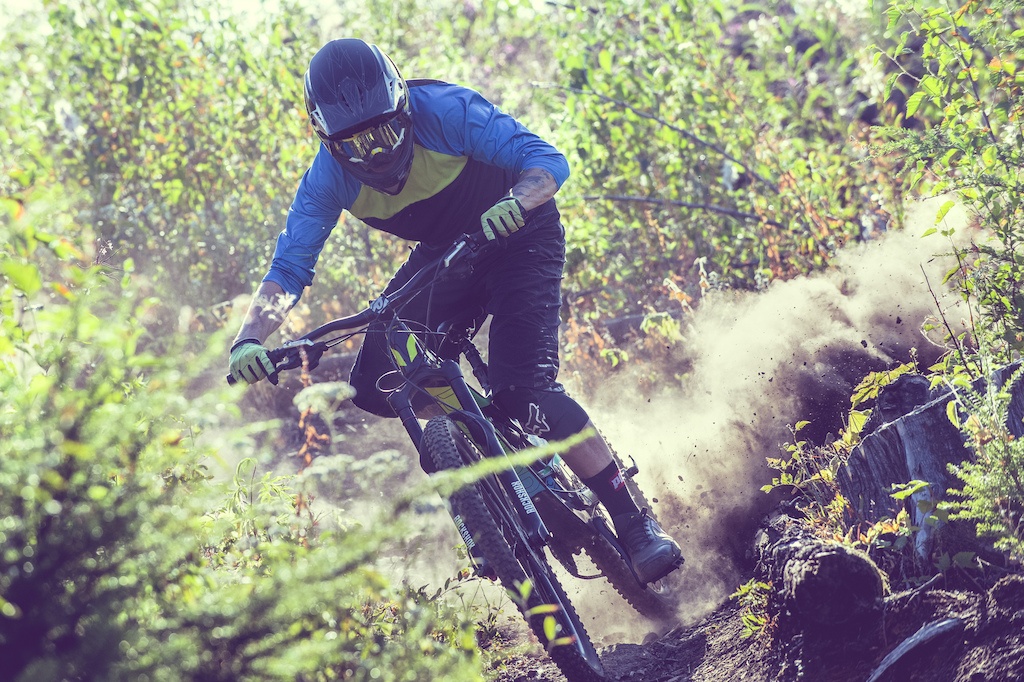
Оригинал: https://www.pinkbike.com/news/ridden-and-rated-5-four-piston-brakes.html
У тебя может быть самая крутая подвеска, которую можно купить за деньги, самые накатистые покрышки в мире, самая продвинутая и продуманная геометрия, но ты не уедешь далеко и не получишь много удовольствия от катания, если твои тормоза не могут остановить даже 45-ти килограммового кантрийщика. Тормоза, без сомнения, одна из самых интимных вещей на байке и то, что любит один всадник, дл ядругого будет, как криптонит для супермэна. Некоторые люди, как я, ставят контроль и модуляцию выше всего остального в тормозах, но есть люди, которых ничего не волнует кроме чувства, будто ты въехал в стройку после нажатия на рычаг. И если ты хочешь от каждого срабатывания тормозов ощущения, словно ты сбросил якорь, то тебе точно нужна парочка 4-поршневых тормозов.
Было время, когда 4-поршневые тормоза можно было увидеть только на длинноходных повдесах, но восход эндуро и олл-маунтина двигает производителей легких двухпоршневых тормозов добавить туда еще парочку поршней. Обычно больше мощи = лучше, особенно когда эта мощь поддается контролю, и в наше время мы имеем широкий выбор 4-поршневых тормозов, и 5 таких, представленных ниже, являются одними из самых привлекательных вариантов.
Да, есть много других тормозов, которые можно было выбрать, включая тормоза от Hope и целые каталоги от SRAM и Shimano, но мы собираемся придерживаться моделей, которые мы можем уверенно прокомментировать. Это тормоза, которые мы испытывали по всей строгости, и иногда мы тратили много времени на 2 или 3 версии одного и того же тормоза.
TRP G-Spec Quadiem
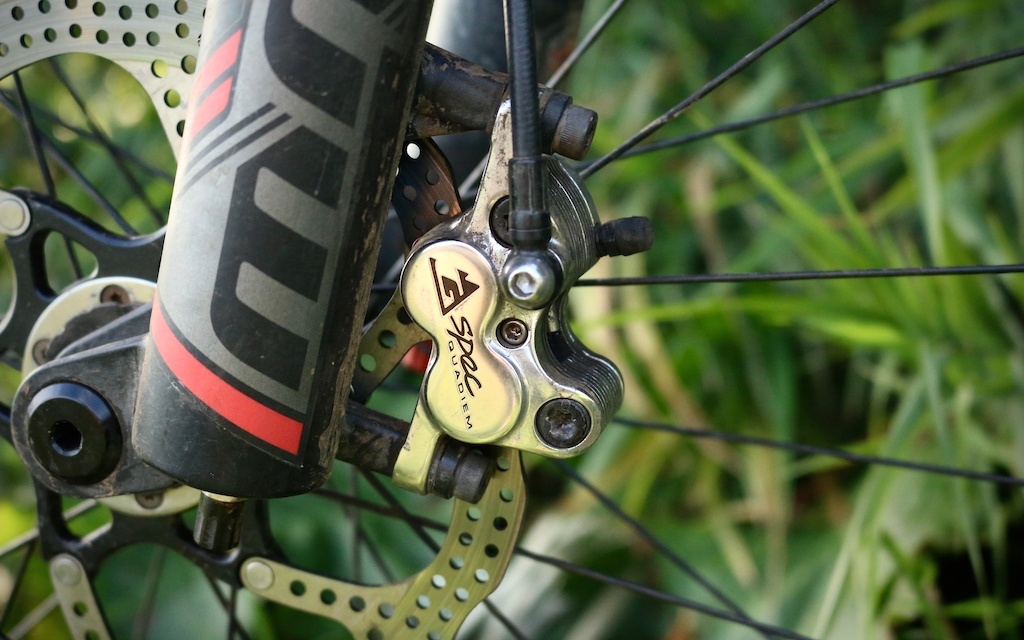
Характеристики:
Если вам нужно приличное количество мощности, но при этом вы знаете, что модуляция — это и есть контроль, то TRP Quadiem — ваш проходной билет, в котором больше чувственности к модуляции, чем в песнях Земфиры после трех бокалов вина. Модуляция у них впечатляет, и к тому же они оказались очень надежными — я поставил комплект себе более 6-и месяцвев назад и с тех пор у меня не было с ними абсолютно никаких проблем. Тем не менее, есть 2 недостатка. Во-первых, нет настройки точки контакта колодок, что может иметь для тебя значение, а может и не иметь. Во-вторых, в то время, как они имеют более, чем достаточную мощность, особенно если ты поставишь металлические колодки (в стоке они идут с полуметаллическими), они не очень соответствуют 4-поршневым предложениям от Shimano или SRAM.
Trickstuff Direttissima
Тормоза Direttissima можно описать в четырех словах: максимум Германии, максимум мощи. Также максимум цены, если ты хочешь добавить еще парочку слов. Trickstuff производят Direttissima в Германии вместо того, чтобы перенести производство куда-то еще, и поэтому они стоят €375 за сторону, но это позволяет Trickstuff создавать нереально круто выглядящий тормоз и предлагать очень разнообразную цветовую палитру.
Калипер — это двухсоставной дом для четырехпокрытых тефлоном поршней, и вы можете использовать собственные более толстые колодки Trickstuff либо пару от Shimano, в то время как сверху в каждой ручке работают четыре промышленных подшипника. Да-да, четыре прома.
Наш комплект Directissima проблемы не обошли стороной — у Астона потекло масло и он сломал ротор, но все равно у этих штук достаточно мощи, чтобы сделать любого счастливым, независимо от того, сколько ты весишь. Рычаг ощущается нереально легким, и эргономика тоже не особо хороша, но опять же, в противовес идет их чудовищная мощность, которая выделяет их из толпы. Модуляция приличная, но не прямо очень крутая, как это часто бывает, когда дело касается такой силы. Недостатки? Это, разумеется, их дикий ценник, и тот факт, что им нужен триллиард различных крошечных шестигранников, когда приходит время, что-то с ними сделать. Нет настройки точки контакта, и для регулировки положения ручки нужен шестигранник размером с пинту.
Trickstuff Direttissima ревью
Magura MT Trail
Это опять немцы, но ты уже знаешь это имя. Диапазон моделей тормозов Magura впечатляет, и они никогда не стеснялись смешивать и сопоставлять компоненты, чтобы получить что-то новое, и именно поэтому сейчас мы имеем дело с тормозами Magura MT Trail. Конечно, только спереди у MT Trail стоит 4 поршня, но магура говорит, что у этого есть своя причина: разница в мощности 4-поршневого калипера и более мягкое действие двухпоршневого калипера MT8 соответствует разнице в сцеплении между передним и задним колесом. Короче говоря, больше мощности там, где она нужна, и меньше там, где нет.
Передний и задний тормоз используют одинаковый мастер цилиндр, поэтому в четырехпоршневом калипере стоят меньшие поршни, чтобы сбалансировать ощущения от рычагов. Разные калиперы, в том числе требуют разных колодок; 4 маленьких колодки используются в переднем калипере MT7 в то время, как двухпоршневые MT8, как вы уже догадались, используют 2 большие колодки. Имеют ли верно подобранные калиперы важное значение на трейлах? RC говорит нет, но ответ очевиден.
Долгое время корона модуляции предлажала Magura, и в то время, как TRP уже положили одну руку на эту корону, немцы все равно называют ее своей. Независимо от того, как меняют погоду разные калиперы, MT Trail дают то самое знакомое ощущение от тормозов Magura. То есть, это не куча мощности в начале, а очень линейное нарастание мощности, которое легко контролировать вплоть до блокировки колеса. Здесь нет настройки точки контакта, и положение рычага настраивается шестигранником, но для настоящих фанатов контроля Magura это не имеет никакого значения. Еще одна вещь которую стоит отметить это эргономика Magura — форма рычага, положение ручки, и как меняется положение рычага на протяжении его хода — немного отличаются от дизайна SRAM или Shimano, и это требует немного времени, чтобы привыкнуть.
Самое большое различие в верхней части это резервуар Code’ов, который вмещает в себя на 30% больше жидкости, чем резервуар у гайдов, который разработан для того, чтобы Code чувствовались одинаково на протяжении всего заезда, не зависимо от того, насколько он крутой или длинный.
С другой стороны, в Code используются 15 и 16мм поршни — больший размер по сравнению с 14мм пистонами Guide’ов и 16мм способствуют увеличению мощности на 15%. В отличие от многих других тормозов, Code идут с уже установленными металлическими колодками, и дизайн колодок тот же, что и был в пердыдущем поколении.
Характеристики
Было время, когда ты смотрел на комплект тормозов Saint, если хотел 4 поршня в каждом калипере. Да, была еще пара вариантов, но все равно в то время большинсто райдеров выбирало Shimano. Хоть и сейчас вариантов для выбора стало намного больше, тормоза Shimano Saint все еще остаются самыми популярными и самыми мощными.
Shimano заполнили спек лист Saint’ов множеством разных аспектов, но главной фичей все еще остается Servo Wave который отвечает за чувство мощности тормоза.
Калипер выступает домом для четырех, разноразмерных керамических поршней, а большие колодки крепко сжимают трехслойный ротор Ice Tech, который создан для лучшего теплораспределения. У роторая есть выступающие ребристые вставки — все чтобы увеличить поверхность и улучшить рассеивание тепла.
Окей, мы не сделали отдельного теста тормозов Saint, но мы протестировали большое множество байков которые шли с 4-поршневыми тормозами Shimano и мы можем сказать, что мощность Saint’ов все так же на месте. Servo Wave дает ощущение падения на рычаге, где усилие пальца действительно уменьшается после преодоления первых милиметров хода рычага, но затем мощность приходит как лавина и вы замедляетесь будто влетели в гигантскую мармеладку. Модуляция у них немного хуже, чем у всего что представлено в этом обзоре кроме Trickstuff Direttissima, но этот жесткий первоначальный буст мощности именно то, что выбирают многие райдеры. В последнее время у Shimano была проблема с непараллельной работой поршней, это следует иметь ввиду.
Так что в итоге, можно ли выявить победителя после всех этих слов? И да и нет. Все они остановят тебя и твой велосипед, конечно, но каждый тормоз сделает это по своему, имеет разные фичи, и разные ценники. Но конечно цена — это субъективная вещь, давайте сфокусируемся на объективной: мощь и модуляция.
Мощность — все эти пять 4-поршневых тормозов обеспечивают достаточную мощность чтобы удовлетворить любые потребности, но есть только один вариант, который может остановить семейный седан с диким визком колес. К несчастью, они и стоят как этот седан. Direttissima от Trickstuff не идеальны, но это произведение искусства, и это так же самый мощный тормоз из протестированных. Хотя, возможно, мощности слишком много для тех, кто мало весит или не ездит на очень крутых спусках, но если вы выбираете самый крутой спуск из самых крутых, то это ваш выбор.
Модуляция — тормоза от SRAM всегда хорошо в этом себя показывали, но Magura и TRP получают зеленый свет, когда дело доходит до контроля. У обоих вариантов есть запасная мощность (Magura в этом немного лучше TRP), и это интуитивное чувство и управление этой силой, которая отличает эти два комплекта от остальных.
It’s no secret that the Avid name is slowly being replaced by SRAM. The latest brake to undergo the Avid to SRAM switch is the Code. The new SRAM Code RSC is a direct descendant of the older Avid Code, using the same brake pads. And that’s a good thing, because the original Code is still an excellent brake. The new Code RSC has rather big shoes to fill.
The SRAM RSC lever appears similar to the Guide, but the performance is worlds apart
Off the hop the new SRAM Code RSC comes in any colour you want, as long as that colour is black. The overall architecture remains the same:
The caliper is much larger than the Guide, or the old Code for that matter. Storing plenty of fluid to keep the brake more consistent through thermal loads
The Bleeding Edge fitting works great, eliminating the pesky small set screw you always lose when you’re bleeding the older brakes. The updated fitting and porting made bleeding these brakes really easy. After trimming the lines, one quick bleed and both brakes have been flawless since. Even though this means acquiring a new bleed fitting, I give this advancement thumbs up for ease of use.
While it’s a pain in the butt to get a new bleed fitting, the Bleeding Edge fitting works very well
The Heat Shield is a sheet of stainless steel between the caliper and the brake pads. This is claimed to reduce the thermal path from the brake pad to the caliper taking the edge load of the brake pad to the caliper. Stainless steel is a poor heat conductor, so from an engineering standpoint this addition makes sense. I’d be a liar however if I claimed I boiled the fluid in the older Codes. So while this advancement should perform as advertised, I can’t say if it’s an improvement but coupled with phenolic resin pistons, heat conduction to the fluid in the caliper should be substantially less than the existing Code.
You can see the Heat Shield on the leading edge of the pad pocket
The updated reach and contact adjusters seem to work well. On the old Code the reach adjuster was notorious for seizing in place, and the contact adjuster was delicately located in the event of unintended bike to tree interaction. The new reach adjuster worked flawlessly over the course of the review period. The contact adjuster worked as it should (although I always run my contact adjustments as close to the bar as possible for minimal free stroke) and it’s now in a more robust location on the lever.
The Code offers excellent modulation of the brake torque on tap, allowing for precise control of either brake. Picture by Cooper Quinn
Out on the trail Code RSC performance is excellent. The brakes provide ample power, excellent fade resistance, and consistent performance. It seems like all the qualities of the old Code remain. Whew! I found the power extremely easy to modulate, being able to choose the amount of brake torque, even in slippery and wet conditions. Thanks to the ample brake fluid on board I was able to run the brake pads almost to the backing plate without running out of fluid in the lever. One thing that drives me nuts are brakes with an inconsistent bite point. Through a taxing day of the Whistler EWS with 2°C at the top, 25° in the afternoon, rain, mud, dust, 1,300 m vertical stages, red hot rotors, and insane arm pump the Codes proved perfectly consistent. Engaging at the same point all day and offering consistent brake torque. I couldn’t imagine a harsher test, and the Codes were flawless.
I’ll gladly take the minor weight penalty for the Code RSC on my trail bike. Photo by Davor Baros
The only criticism of the SRAM Code RSC is that they’re a bit vocal. It might be a function of this set of brake pads but these are noisier than previous Codes I’ve used. It might be that I’ve got them extremely hot on a number of occasions, and maybe glazed the pads. Once the brakes get hot, if they cool a little, they get a bit noisy on reapplication. Get water on them, and they emit an alarming screech. It’s not pleasant for the short time it occurs, and doesn’t seem affect the brake performance. I’m not convinced this noise is due to the new brake design, but worth mentioning.
Sea to Sky. Photo by Cooper Quinn
From what I’ve ridden so far, I think the Code RSC is the best of the bunch.
For more on the SRAM Code RSC click here.
Обзор дисковых тормозов SRAM Code RSC. Самые мощные тормоза SRAM
Самые мощные тормоза SRAM обещают много регулировок и много мощности.
Тормоз Code является одним из самых популярных тормозов для эндуро и даунхилла – это флагманский мощный тормоз SRAM, так что это неудивительно.
Эта версия тормоза RSC не только имеет дополнительные регулировки по сравнению с Code R, но и поставляется с очень причудливо выглядящей фурнитурой с масляным покрытием.
Технические характеристики и детали дисковых тормозов SRAM Code RSC
Как и другие тормоза SRAM (SRAM G2 и Level), Code оснащен рычагом типа “флип-флоп”, что позволяет использовать его с любой стороны грипсы, без необходимости менять шланги местами.
Добавьте к этому съемный откидной зажим, и вы получите универсальный рычаг с точки зрения установки на руль. В хомут помещается переключатель SRAM MatchMaker и держатель Reverb, если вы используете этот переключатель. Очевидно, что официального держателя для шифтера Shimano не существует, но есть варианты на вторичном рынке.
Будучи одновременно шарнирным и съемным (сам рычаг тормоза зажимается между шарнирной частью зажима), установка на планку может быть немного сложной задачей, когда три отверстия и болт подобраны и зацеплены.
Предусмотрена регулировка как точки прикуса, так и досягаемости рычага.
Рычаг имеет безынструментальную регулировку как положения рычага, так и точки укуса. Колесо регулировки точки прикуса утоплено в корпус рычага, поэтому доступ к нему немного сложнее, чем к специальному внешнему циферблату, и, по моему опыту, оно не обеспечивает большого диапазона регулировки – хотя в некоторых случаях это может немного зависеть от тормоза.
Корпус рычага выполнен добротно, с приятной, премиальной отделкой – сглаженные углы, отсутствие острых краев, отсутствие дребезжания рычага и подшипники, а не втулки в шарнире рычага.
Рычаг оснащен механизмом SwingLink от SRAM, который обеспечивает более быстрое относительное движение поршней в начале хода, чтобы подвести колодки к ротору, а затем замедляет его, чтобы увеличить модуляцию при выжимании рычага.
Резервуар больше, чем в предыдущей версии Code, что означает больший объем жидкости и немного большую теплостойкость.
На конце суппорта, состоящего из двух частей, расположены четыре поршня и большая одинарная пара колодок, закрепленных ввинчивающимся штифтом и предохранительным зажимом. Поршни имеют немного разный диаметр, что влияет на то, как колодки ударяются о ротор, а также на ощущение торможения.
SRAM утверждает, что увеличенный диаметр колодок по сравнению с предыдущей версией увеличивает мощность на 15 процентов. Между колодками и корпусом суппорта находится теплозащитный экран, обеспечивающий дополнительную изоляцию между колодкой и жидкостью.
Шланги выходят из суппортов через регулируемый банджо, чтобы помочь правильно проложить кабель. Мой суппорт поставляется с 950-миллиметровым шлангом спереди и 1950-миллиметровым шлангом сзади – достаточно длинным для большинства сверхбольших мотоциклов.
Моя единственная претензия к конструкции суппортов заключается в том, что задняя часть корпуса поршня немного нависает над нижним болтом.
Поэтому я обнаружил, что проще всего использовать шестигранный ключ с шариком, но при установке тормоза в узких задних треугольниках на суппортах появились потертости краски – вам нужно убедиться, что ваш мультиинструмент имеет достаточно длинные насадки, чтобы пропустить корпус суппорта, если вам нужно произвести регулировку на трассе.
SRAM оснастила рычаг Code разъемным зажимом для удобства установки, хотя иногда это может быть сложно.
Продуть тормоза очень просто с помощью инструмента Bleeding Edge от SRAM. Эта пара шприцов включает в себя вставной ниппель на конце шприца суппорта. Процесс имеет больше шагов, чем большинство процессов продувки, но им легко следовать, и я добился приличной продувки с первого раза.
Полный профессиональный комплект SRAM Bleed Kit с инструментом Bleeding Edge Tool стоит довольно дорого, но детали можно приобрести по отдельности, также доступны версии для вторичного рынка.
Мне особенно нравится ввинчивающийся барб и ввинчивающаяся оливка, которые облегчают обрезку и повторную установку шлангов, особенно если у вас нет такого инструмента, как Park Tool Hydraulic Barb Tool.
Производительность дисковых тормозов SRAM Code RSC
Тормоза Code обладают огромной мощностью, что подтверждает тот факт, что они постоянно используются на эндуро, DH и электрических MTB.
Тормоз имеет привычное для SRAM модулированное ощущение, с плавной, линейной прогрессией мощности по мере того, как вы сжимаете рычаг. Начальное усилие присутствует, но слегка приглушено по сравнению с тормозами Shimano – поэтому вы не будете беспокоиться о мощности, предлагаемой при первом нажатии на тормоз, и не будете выброшены через переднюю часть велосипеда из-за слишком энергичного захвата ротора.
Это означает, что вы уверенно входите в техничные участки, будь то благодаря легкости набора скорости или потому, что вы знаете, что можете контролировать свою скорость до тончайших пределов на крутых и узких трассах.
Колодки устанавливаются в суппорт сверху.
Добиться абсолютного предела мощности тормоза легко благодаря достаточно длинному рычагу – это означает, что вам не придется сильно сжимать пальцы, чтобы получить максимальную отдачу от тормоза, а значит, и меньше перекачивать руки.
На длинных спусках мощность и ощущения стабильны, что говорит о том, что тормоза хорошо справляются с накоплением тепла.
У Code RSC не самое легкое ощущение рычага, есть намек на сопротивление, но оно не такое сильное, как у Shimano или Hope.
Итоги дисковых тормозов SRAM Code RSC
Тормоза Code от SRAM имеют завидную репутацию по вполне понятной причине. Проще говоря, Code RSC предлагает такую же мощность, как и любой другой тормоз на рынке, при отличных ощущениях, высококачественной конструкции, широких возможностях регулировки и простоте обслуживания.
По этой причине он является моим лучшим тормозом для эндуро и DH в 2021 году.
Вердикт
Распространенность Code на агрессивных байках говорит о многом – это, без сомнения, один из лучших тормозов, ориентированных на мощность, на рынке.
Плюсы : Отличная мощность с плавной и стабильной подачей; отличное качество сборки; легко добиться правильного положения рычага
Минусы : Есть небольшое сопротивление рычага; я не уверен, что регулятор Bite Point всегда оказывает сильное воздействие.
Технические характеристики продукта
Product
Price: GBP £230.00
Weight: 678g – calliper, hose and lever – for front and rear
Brand: Sram
Features
Features: Pistons: 4
Fluid: DOT 5.1
Weight: 326g (f) 352g (r)
Details: Split and hinged lever clamp; SRAM MatchMaker
Adjustment: Reach (TF), bite point (TF)
Brake type: Hydraulic disc
Инструменты
First Impressions: SRAM Code RSC Brakes
SRAM’s strongest stoppers go on a diet
Photos: Ryan Palmer
SRAM Code brakes do an extraordinary job at speeding you up. That’s not a backhanded way of saying that SRAM’s updated stoppers aren’t powerful—they’re stronger than Trump’s late night urges to Tweet. But that’s not what helps them make riders faster. That comes down to how they deliver all that power.
Which sort of relates to the Code’s new look, that of a beefed up version of SRAM’s Guide brakes. Like the Guides, the new Code lever uses a cam between the lever blade and piston to control how quickly the pistons advance at any point during the lever stroke. Here’s a not-so-quick explanation of how it works and why:
In their resting position, the brake pads sit a millimeter or so off the rotor to prevent noise and drag. When you start braking, you want to get them in contact with the rotor with the least amount of lever throw possible, so you can start stopping. During this time, the cam is giving the lever a huge mechanical advantage—in other words, you move the lever a small amount and the pistons advance a lot. But if you continue to have that same level of mechanical advantage once the pads are in contact with the rotor, the power will come on too fast and you’ll skid your ass right off the trail. The cam is shaped such that, once the pads are in contact with the rotor, the mechanical advantage is reduced to a manageable level, making it easier to control how much force is applied.
Here’s the short version: The cam is responsible for the Codes’ excellent modulation, and it’s that remarkable ability to control power that makes it possible for a device meant to slow people down, to make them faster.
After getting to know them, I found that I could brake later into corners than with the Guides I’m familiar with, without locking up the wheels and losing grip. This was especially noticeable in loose conditions. Whereas the previous Codes feel grabby in comparison to the Guides, the new ones just feel stronger. A lot stronger. It did take some getting used to, because less finger strength is required to manage the chaos. But once I got used to the power, it was easy to control.
Power and modulation is a good start, but consistency is king. The new Code brakes don’t disappoint here either. All brakes fade when they get hot, but the Codes fade less. Even though both the lever and caliper are smaller and lighter, the new Codes have more fluid volume, which means they take longer to get hot—just like two gallons of water takes longer to boil than one. And SRAM uses other techniques, like a wide pad pocket and a steel heat shield to keep the mercury in check.
Best of all, these new Codes are slimmer and lighter—by about 100 grams per pair—than the previous generation, which I’m guessing will make people want to put them on more than just downhill bikes. I’ve been running them on my 6-inch-travel trail bike that previously had a pair of Guides, and there’s not a person on earth that could convince me to go back.
The Guides are excellent brakes in their own right, but I like to ride fast, brake late and drift corners, and these new Codes are the perfect companion. They’ve got my back when I come into sections way too hot on trails I’ve never ridden before, they provide that extra level of control that riding on the ragged edge demands and they stay consistent when things heat up on long descents.
Plus, the RSC version of the Codes have enough tool-less reach and contact point adjustment to satisfy the ergonomic needs of most riders. When dialing in your brakes is this convenient, you find yourself making small adjustments all the time.
The only thing I’m not fond of is that the caliper extends past the lower brake mount, making it nearly impossible to access the fixing bolt without a ball-ended tool. It makes for slightly less user-friendly installation and caliper alignment, but I’m sure SRAM needed that real estate to meet performance goals. And if it’s any consolation, the new Code brakes are easier and cleaner to bleed, thanks to SRAM’s Bleeding Edge bleed port.
With the month or so of riding I’ve had on these new Code brakes, I’m more than impressed. They’ve been reliable, consistent, strong and most importantly, controllable and reliable. If you’re looking for stronger brakes, no matter what kind of bike you’re on, these things are worth a try.
SRAM Code Specs and Pricing:
-Larger fluid volume for consistency.
-Powerful four-piston caliper with 15 and 16mm diameter phenolic plastic pistons
-Proven Guide technologies optimized for heavy duty applications
-Bleeding Edge ™ provides easiest bleed process
How To: 15 Easy Steps to Bleeding SRAM MTB Hydraulic Brakes
Today on this mountain bike How To, we are going to be bleeding a set of Sram Code RSC brakes. This same step-by-step process can be followed for any SRAM brakes with their Bleeding Edge technology. So what is Bleeding Edge? SRAM’s Bleeding Edge technology is their latest brake bleeding innovation designed to make bleeding SRAM brakes easy and mess free. You can find the Bleeding Edge bleed port on all SRAM Code, Guide, and Level brake models since 2017.
Why do I need to bleed my brakes anyway? Over time, your brakes go through hundreds of hot and cold cycles and as that happens, your brake fluid will start to break down. Just like changing the motor oil in your car every 3 to 5 thousand miles, SRAM recommends you bleed your hydraulic brakes at a minimum once a year and more frequently if you are riding on aggressive trails that require heavy braking. Bleeding your brakes not only replaces the brake fluid throughout the lever, brake line, and caliper, it also ensures there is no air inside the system. Follow along on how to bleed SRAM brakes to keep them working their best!
What Tools Do We Need?
Here is a list of all the tools we will need to complete this service. If you don’t already have your own bleed kit, the SRAM Pro Bleed Kit uses high quality syringes and has all of the supplies you will need. Both the traditional and Pro SRAM bleed kits will come with SRAM’s 5.1 DOT fluid, and the appropriate syringes and fittings to get the job done. We also recommend wearing a pair of safety glasses and Nitrile gloves during this service.
1. Remove Wheel
For this How To, we will be bleeding the rear brake. You can follow the same process for both the front and rear brakes. Remove the rear wheel from the bike and set it aside. Make sure that no brake fluid comes in contact with either the brake pads or the rotors or they will become contaminated.
2. Remove Brake Pads
3. Insert Bleed Block
Push the correct bleed block into the caliper. The bleed block will return the pistons fully in to the bores and will keep the pistons from advancing throughout the bleed process. Either of your SRAM bleed kits with come with an assortment of bleed blocks that are designed for the Code, Guide, and Level brakes specifically. If your bleed block calls for it, install the pad retainer bolt through the bleed block and tighten using a 2.5mm hex wrench.
4. Prepare Syringes
First thread the bleeding edge tool and lever bleed clamp assembly on to both syringes. Fill the lever bleed syringe 3/4 full with SRAM 5.1 DOT fluid. Fill the syringe with the bleeding edge tool with a small amount of DOT fluid (about 1/4 full). For both syringes one at a time, hold the syringe upright and pull all of the fluid from the line in to the syringe. Then cover the tip of the syringe with a rag and push all of the air out of the system. Close both syringe clamps so you don’t lose any fluid.
5. Prepare Lever and Unwind Contact Point Adjustment
For brakes with contact point adjustment, unwind the dial in the opposite direction of the arrow until it stops. First measure the distance between your lever blade and the grip and then adjust the lever blade until it is 75-80mm from the center of the grip.
6. Install Lever Bleed Syringe
Using a T10 Torx wrench, remove the bleed screw from the lever and wipe off any access brake fluid that comes up on to the lever. Thread in the lever bleed syringe while the syringe clamp remains closed.
7. Prepare Caliper
Remove the bleed plug and then use a 4mm hex wrench to loosen the bleed port 1/4 turn and then gently retighten it. Push the bleeding edge tool and syringe in to the bleed port. You will feel and also hear audible click in to place. Open the bleeding edge syringe clamp and then turn the bleeding edge tool 1 complete rotation to open the system. Do not ever exceed two complete rotations.
8. Bleed The System
Open the lever bleed syringe clamp, hold both syringes vertically, and gently push DOT fluid from the lever down through the brake line and into the bleeding edge tool syringe. Stop before any air enter the hose tube at the lever bleed sysringe. Brake fluid will fill the syringe at the caliper on its own. At this time, do not pull suction at the caliper. Some will refer to this technique as a wash. You are cycling brake fluid from one end of the line to the other allowing you to push out old fluid and any air bubbles in the system.
9. Is Your Brake Fluid Discolored and Contaminated?
If the brake fluid coming out of the caliper in to the bleeding edge syringe is discolored, remove both syringes, discard the old brake fluid and return back to step 6. If that is the case, to remove both syringes, first close both syringe clamps. Then close the bleeding edge tool clockwise and remove the caliper syringe first. Next unthread the lever bleed syringe.
10. Continue Bleeding System
Hold both syringes upright and draw suction with the lever bleed syringe. This will draw fluid from the bleeding edge tool syringe through the caliper and brake line up through the brake lever. Stop before any air enter the syringe tube at the caliper. Repeat steps 8 and 10 until only a small amount of bubbles appear. For best results, make sure your brake lever is up higher from the brake caliper so that air has the best chance of rising to the top and out of the system.
11. Lever Bleed Only
Turn the bleeding edge tool clockwise 1 full rotation and until it stops to close the system. Pull the lever blade a few times and let it return normally. Next pull suction on the lever bleed syringe to create a vacuum. Then compress and release the plunger to pressurize the system. Repeat the process until there aren’t many air bubbles coming up through the syringe line. One last time, compress and release the plunger to equalize the system. Close the syringe clamp and remove the syringe from the brake lever. Use a T10 torx wrench to reinstall the bleed screw in to the brake lever. Wipe away any excess brake fluid on the brake lever. Using a T10 bit socket and torque wrench, tighten the bleed screw to 1.5-1.7 Nm (13-15 in lbs). This is somewhat option because the torque spec is so low. Tighten the bleed screw snug but not too tight.
12. Remove The Bleeding Edge Tool Syringe
Remove the bleeding edge tool syringe without rotating the syringe. Tighten the bleed port using a 4mm hex bit socket and torque wrench to 1.5-1.7 Nm (13-15 in lbs). Again, this torque spec isn’t super crucial since it is so low. Snug up the caliper bleed port with a 4mm hex wrench but do not over tighten. Install the bleed plug.
13. Clean Brake Lever and Caliper
Before installing your brake pads, use a clean towel or rag to remove any brake fluid residue on both the brake lever and caliper.
14. Install Brake Pads
Using a 2.5mm hex wrench, remove the pad retainer pin and remove the bleed block from the caliper. Remove your gloves so that no brake fluid comes in contact with the brake pads. Install the brake pads in to the caliper and remember which pad was oriented on which side of the caliper originally. Install the pad retainer bolt and torque it to 1-1.2 Nm (9-10 in lbs). Install the e-clip on to the pad retainer bold.
15. Install The Wheel and Center Brake Caliper
Install the wheel and axle correctly. Before squeezing the brake lever look to see if the brake rotor is centered in the brake caliper. If the caliper is centered, squeeze the brake lever a few times to advance the pistons in the caliper. If the caliper is not centered correctly, loosen the brake caliper bolts and then squeeze the brake lever to advance the pistons. Center the caliper and tighten the caliper bolts. Finally adjust your brake lever blade and contact point adjustments to your liking!
About Me

Instagram: @mxmorgan77
SRAM vs. Shimano Brake Buyer’s Guide: The Ultimate Comparison [Video]
Overview:
Year after year, the SRAM vs Shimano brake rivalry continues and becomes even more divided. A few years ago we did a comparison of these two brakes, but since then both brands have come out with new and updated brakes, addressing the previous complaints and always trying to improve. The arguments go one of two ways: either SRAM brakes feel soft and spongy and I have a harder time bleeding them OR Shimano brakes lock up too fast, I can’t modulate how much brake I pull and after a few rides my Shimano brakes are pulling to the bar and I have to bleed them often.
Both arguments come up often, and a lot of this comes down to rider preference and your own or your local mechanic’s skills. I have personally been working on both brakes for the better part eight years, so I know most of the tricks. I’ll get into my thoughts and personal tips for bleeding each brake later. At the end of the day, there is a reason both of these brake brands are seen as the top two brands to choose from. Both options are amazing and have great brakes to help you slow down regardless of what kind of terrain you ride. From SRAM Code or Shimano Saint brakes for your downhill bike, SRAM G2 or Shimano XTR/XT four piston brakes for your trail bike, and SRAM Level or Shimano XTR/XT two piston brakes for your cross country bike, each brand makes something for everything.
Feel and Modulation:
I would say that this is pretty much the biggest part of the argument right here, how each brake feels and performs on the trail. One brand is known to have a snappy feeling but less “feel”, by which we mean how easily you can put on a little bit of braking power to scrub speed versus pulling the brake and instantly locking up the rear wheel. The other brand is known to have a little more feel and modulation, making it easier to control the amount of braking power you want, although seemingly lacking some of the initial bite the other brand offers. Let’s brake it down. (see what I did there?)
SRAM brakes are known to have more feel and modulation, no matter which category of brake we’re talking about. The lever feel is smooth, and you can slowly apply the amount of brake pressure you want in any given situation. Over the years SRAM has got much better at feeling sharp without losing their key feature of modulation. Each new model that comes out gets better and better and more and more consistent. Oftentimes riders who have not ridden any newly updated SRAM brakes are blown away by the improvements, the amount of modulation they can achieve and just the overall power, especially the Code brakes made for downhill bikes.
Shimano:
Shimano is the brand most commonly put on the pedestal for staying snappy over a long period of time. This has to do with a technology they use called ServoWave, which creates a bit more effort to pull the brake lever at the beginning of the lever stroke and then gets easier after that. This allows you to get a good snap on the lever and pull lots of braking power. That leads to the snappy feeling as well as the feeling of lots of immediate power from the brake. But that also has its drawbacks, as it can provide too much power, more than a rider might have wanted at first. This gets better once you are used to them and learn to put on the amount of power you need, but it does take some time. Over the past few years, Shimano has actually made it a point to make the ServoWave be a bit less and improve on the modulation as well. So basically, both brake brands are trying to get closer to what the other brand is good at.
Both brakes have a specific feel and it often just comes down to what you want as a rider. We will get more into personal preference further down, but thoe are the basics of what each brake offers.
Models Per Riding Discipline:
This is where things get a bit crazy and hard to understand. We will break this down into the easiest methods. The two brands use different ways to categorize their brakes for different disciplines. SRAM uses one model name for different categories and within that model there are different levels of high end down to entry level. Shimano on the other hand, has model names for the level of high end to entry levels and within those models are the category discipline. Hopefully, this will make sense a bit further down.
There are going to be three main categories for mountain bike disc brakes: cross country, trail/enduro, and enduro/downhill. Just like any other mountain bike category, there is a bunch of cross over and you can run a more powerful brake on a smaller bike as many do, or a less powerful brake on a bigger bike, not that many do but you can. Cross country brakes will be the lightest version of disc brakes and typically feature only a two piston caliper. External tool free adjustments are removed for weight and the size and fluid capacity have been shrunk down to be as light as possible while providing just the right amount of braking power needed. Trail/enduro brakes usually move to a four piston caliper and you typically get some tool free adjustments. The fluid capacity on these brakes is also increased. The trail/enduro brakes are what you will see spec’d on most bikes and are very common. They provide adequate braking power and can be found on a huge range of bikes from 120mm light trail bikes to 160mm enduro bikes. Rotor size comes into play big time with these styles of brakes, and we will cover that in just a second. The last category of disc brakes are enduro/downhill brakes, made for downhill bikes but many fast enduro riders use these brakes on their bikes to get the most stopping power possible. These also have four piston calipers and have the most amount of fluid packed into the brake to reduce any overheating that may occur.
The last bit to cover is rotor sizes. Yes, size does matter with rotors. The smaller the rotor, the less leverage and therefore stopping power you can get with any given brake. Typically you will see 160-180mm rotors on a cross country bike paired with a two piston caliper. For trail and enduro bikes, 180mm is most commonly used and bumping up to a 200mm or 203m rotor is also a common thing to see to get a touch more stopping power out of a trail style brake.
Downhill and big enduro bikes will use 200 front and rear and now some brands are making some 220mm or 223mm rotors to get even more stopping power for those fast riders out there. If you have a brake and want to get some more stopping power without buying new brakes, I would suggest going with a larger rotor. It’s cheaper than a new brake system and you might be surprised by how much more power you can get when upgrading to a 20mm larger rotor in the front or the rear. Along with that, you either see the same size rotor front and rear, or a larger rotor in the front than the rear. This is because lots of your stopping power comes from the front and getting a larger rotor in the front increases the ability to stop even faster. It also doesn’t add that much weight to your bike, so a bigger rotor is always the way I go.
Shimano Models:
Starting from the highest end and down: XTR, XT, and SLX for cross country and trail use, with Saint and Zee being their downhill options. Within the XTR, XT and SLX models you have both a two piston option for cross country and a four piston option for trail/enduro. The Saint and Zee only have one option and are four piston and are made for downhill use. XTR brakes will be the lightest version and most high end option from Shimano with XT coming in just behind. Shimano XT brakes are often said to be the standard for how mountain bike disc brakes should perform for the power and price they are offered at.
SRAM Models:
SRAM’s brake lineup is a little easier to follow in my opinion. You have three brake names, one for cross country, trail, and downhill. Within those are the levels from high end and down. Starting with SRAM Level brakes, these are SRAM’s cross country option that will be lightweight without tool free adjustments and two piston calipers. In the Level brake category you have four models, starting with the high end Level Ultimate, then the Level TLM, the Level TL and finally the Level T. The trail brakes follow a similar naming convention but are the SRAM G2 brakes with a four piston caliper, and within the G2 model there is G2 Ultimate, G2 RSC, G2 RS and G2 R brakes. The G2 Ultimate and RSC feature a few more adjustments than the latter, with a tool free contact adjust that actually works, and it works great! Lastly for SRAM is their downhill brakes, the SRAM Code with two models to choose from: the Code RSC and the Code R. These will be the burliest brakes SRAM makes and they have a large four piston caliper and a huge master cylinder. The RSC model also features the tool free contact adjust like the G2 Ultimate and RSC brakes.
Cross Country / Light Trail
The Shimano XTR two piston brake (BR-9100) will be the lightest and highest end cross country model from Shimano.
The SRAM Level Ultimate will be the highest end and lightest cross country brake model from SRAM, featuring just what you need and nothing you don’t.
The Shimano XT two piston brakes (BR-8100) are the most common brakes on the market, working on bikes from your cross country race rig to mid travel bikes. Often referred to as the standard for disc brake performance.
The SRAM Level TLM is just a step down from the Level Ultimate, still remaining lightweight but forgoing the carbon and titanium bits. The Level TLM will be slightly more of the workhorse on the Level series.
The Shimano SLX two piston brakes (BR-7100) will be the best bang for the buck out of the Shimano lineup. Offering reliable braking performance at a wallet friendly price.
The SRAM Level TL and T will be the lower end of SRAM’s cross country brakes, but that doesn’t mean they offer low stopping power. Having ridden the SRAM Level TL for a bit I can tell you that they can still stop when you need and are extremely reliable for all types of riding.
Trail/Enduro
Made for modern trail and enduro bikes, the Shimano XTR four piston brakes (BR-9120) have a carbon lever blade, finned brake pads and are made to stop you in all conditions. With titanium hardware, the XTR four piston brakes are the top end for Shimano trail and enduro brakes.
SRAM G2 Ultimate brakes deserve the nickname the “mini-Code” for how much power they pack into a small, compact trail brake. With a four piston caliper, the G2 Ultimate is the lightest four piston brake on the market. They are available in a few colors to match your bike.
Following in the path of the classic two piston Shimano XT brake, the Shimano XT four piston brake (BR-8120) offers some of the best performance to price on the market. Many riders swear by these brakes and the four piston option was a hit when it first came out. The workhorse of the disc brake world, you will see these XT four piston brakes on many different bikes.
The SRAM G2 RSC is the aggressive brother of the G2 Ultimate, without the carbon level blade and titanium hardware. The G2 RSC also has the mini-Code nickname and is one of our favorite SRAM trail brakes to ride. Much of this is from the contact adjust the brake features, allowing you to really move how much dead zone there is in the lever pull.
Shimano’s entry level four piston brake, the Shimano SLX (BR-7120), can take a beating. For the price of this brake, the quality and stopping power is amazing!
SRAM recently released the two G2 RS and R brakes to follow their higher end siblings. Offering the same four piston stopping power, the SRAM G2 RS and R go without the contact adjust to come in at a lower, more affordable price.
Enduro/DH
Shimano Saint brakes have been long seen as some of the best downhill brakes on the market. With too many downhill World Cup wins to count, you will see these brakes on most Shimano racers’ bikes. Consistency is the name with the Shimano Saints, and they deliver the power too.
SRAM Code RSC will be SRAM’s most powerful brake, also having tons of downhill World Cup wins under its belt, the Code RSC can perform at the highest level. Featuring the contact adjust like the G2 Ultimate and RSC, the Code RSC feels great and has the power as well.
Shimano Zee brakes are going to be the budget version of the Saints. Still meant for downhill and stopping fast, the Shimano Zee is a great value to performance from Shimano.
SRAM Code R brakes will be the affordable version of the RSC, very similar but without the contact adjust that the RSC has. Don’t let the price fool you, the Code R is a great value and has the performance to prove it.
Mechanic Friendliness:
Between the two brands there are some differences when working on them. Starting with Shimano, the bleed process is quite easy for the home mechanic and you can get a quick top off bleed done very easily without much skill required. I think Shimano brakes are easier to make feel good, and kept bled. SRAM brakes take a little more work and have the use of syringes. While it takes more skill to get down, once you learn it, I think it’s easier to make a consistent bleed on SRAM than Shimano brakes. Using the syringes you can be sure that there is no air in the lines and the brake is as good as it can get.
Adjusting the brakes is about the same now. In the past, SRAM pistons wouldn’t align as easily as Shimano but there have been many updates since then. Also to note, on the higher end models there is a contact adjust on both brakes but they work very differently. For Shimano this is called a free-stroke adjustment, which has a few drawbacks. It uses a Phillips head screw on the lever that one, requires a tool to adjust, two it’s a Phillips head screwdriver and I think that is not the best quality on a high end brake, and three, it really doesn’t work at all. All the way out or all the way in you barely feel a difference and it’s pretty pointless. For SRAM, they have a pad contact adjustment and it works great. You have lots of adjustment and you can really feel the difference with just a couple quarter turns. When I bleed the brakes I bleed them all the way out and then dial it in to feel. I’d say this is a huge benefit that SRAM has over Shimano.
DOT Fluid vs Mineral Oil:
Mineral Oil:
Pros:
Cons:
Dot Fluid:
Pros:
Cons:
What Sucks and What’s good:
Both brands make some amazing brakes, having been at it for years now. Yet both still have some drawbacks compared to the other, and there are also positives from each brand that the other lacks.
Shimano makes a very consistent brake. They’ve been making consistent brakes for years now and hold the benchmark for other brands to compare themselves to. Shimano is also pretty easy for the home mechanic.
SRAM What’s Good:
SRAM pad adjustment sets it above many brakes in that department. Their contact adjust on their Code RSC, G2 Ultimate and G2 RSC works really well. You can bleed the brake with it open, wind it in after the bleed and have some amazing and easy to adjust pad contact. Another cool feature is that their brake levers are dual sided, meaning you can carry one spare, or if a mate from down under comes to visit you can easily swap the brakes for the right front style if needed.
SRAM What’s Bad:
SRAM brakes are inherently a bit harder for the home mechanic. You need a syringe bleed kit in order to properly bleed the brakes, and it takes a bit more trial and error to get the bleed down.
Personal Preference:
The final bit, which do we prefer? Both Jeff and I lean towards the SRAM side and for a few reasons. I really like the lever feel, and I think it’s easier to slowly add on the power and scrub speed more controlled than Shimano brakes. Another reason is how well the pad contact adjustment works. When you start to wear the pad, if bled and set up right, you can dial in the contact adjust to keep the lever throw the same. This helps prolong the need to bleed the brakes to maintain feel. I also think that once you learn, SRAM brakes are also easier to get a consistent and good bleed on with the syringes. By using vacuum pulling you can be sure that all of the air is out of the system and you only have a tight bleed with brake fluid. Jeff and I are also on the lighter side of the common rider and I have many friends that are some solid, thick guys and many of them prefer Shimano. At the end of the day, they are both great brakes, and it really does come down to personal preference. I can get used to either, but SRAM is my preferred choice.
[Tested] SRAM Code RSC Brakes
Cover
When SRAM introduced the Guide, it was a benchmark in consistency in more ways than one. In terms of power, modulation, and ease of bleeding, it was the most consistent brake that the brand had ever engineered. The Guide saw minor, but key revisions not long after their initial release with the S4 caliper…“Bleeding Edge” technology made for snappier bleeds but perhaps more importantly, “Heat Shield” notably improve the power under hot, heavy braking.
The last iteration of the SRAM Code had a long, successful cycle on the market – it won World Championships and World Cups in the gravity world and with the brake’s fantastic reputation, SRAM wasn’t in a hurry to phase them out. Instead, they took what they learned from developing the Guide brake and implemented those concepts into the new and improved Code. We started testing the Code RSC a couple of weeks before their official release (
6 months ago) and have been riding them as much as possible ever since. Read on for the full review…
Details
It’s a bit hard to see, but the added volume in the master cylinder leaves the Code with some extra material at the lever body. That said, it shares the same lever blade and a great deal of hardware with the Guide family.
We alluded to this earlier, but to be clear: the new Codes are a complete overhaul of their last design, so nothing carries over. Think of this brake like a Guide on steroids – you can read up on the Guide brake here, but in short Codes have 15% more power. This is partly due to the fact that one pair of the four pistons have increased from 14mm to 15mm in diameter. Additionally, Codes use 30% more hydraulic fluid and have a substantially larger master cylinder in the brake lever. Shortly before the updated Codes came out, racers and consumers alike were mixing and matching Guide levers and Code calipers. It’s important to note that this is no longer a possibility, but since the updated brake lever uses the best parts of a Guide lever there really is no reason to mix and match anyway.
A closer look at the sleeker, more streamlined caliper and hardware.
SRAM have ditched their “Tri-Align CPS hardware” in lieu of a low profile T25 Torx screw and washer, and we feel it’s an improvement. As standards and manufacturing processes improve while tolerances get tighter all across the bike world, we no longer need the crutch of concave/convex washer combinations to align our calipers with their rotors.
Install/First Impressions
To no major surprise, the install was painless. Our Code RSC brakes came pre-bled and had plenty of extra hose length to get along with even the most bizarre cable routings. We mounted them up to our size XL Rocky Mountain Maiden without any issues. The brakes arrive with extra hardware so that when you trim the hose(s), you won’t be left high and dry. On both brakes we were able to cut down the excess length and reconnect the hose to the lever without having to perform a bleed. Perhaps we’ll publish a tutorial on that process in the future.
The simplified caliper mounting hardware was warmly welcomed and the brakes aligned themselves just fine upon install without rubbing. From an ergonomic standpoint, we felt right at home with the levers – this should come as no surprise since they feature the same lever blades as the Guide brakes.
On the Trail
After just a few turns down the hill on our first lap, the Code RSC brakes had already burned in nicely. Compared to Shimano Saints or the last iteration of the Codes, we quickly noticed improved modulation. The new Codes have less of an ON or OFF feel, but that’s not to say the power isn’t there; it’s just easier to manage on the trail. Basically, you won’t ever have too much bite when you’re just trying to scrub a little speed. Additionally, when you’re on the brakes and feathering – pulling a touch harder provides the extra stopping power you’re looking for with very intuitive delivery.
Tireslides in Tahoe…Testing out the Code RSC brakes on Livewire at Northstar.
On long, steep descents with loads of braking we never once noticed any sort of fade or felt that the power diminished. We opted for a 200mm front/180mm rear rotor combination, but those individuals racing DH or looking for more may opt for 200mm front and rear. While we didn’t really have a chance to explore the option, the brakes offered so much power that we pondered the idea of running a 180/160mm combo on enduro bikes with Codes. Currently we’re quite content with 200/180mm rotors paired with Guide RSC and we think the difference in weight would come out in the wash though.
In terms of durability, we’ve not yet pushed these to the point that they show signs of needing a bleed, although it’s best to do so as recommended by SRAM based off of frequency of usage. We’ve had no issues with sticky pistons or dragging pads and the brake pads themselves have worn quite nicely. The detents on the lever adjustments are crisp and clear and have never once gotten mucked up despite mixed conditions and multiple hosings. All in all, nothing has tipped us off that the Code RSC have any sort of shortcomings. If we had to dig for something to complain about, there was an occasional, intermittent bit of noise in the beginning of a run. However, the noise was fairly subtle and would always subside after a few taps of the brake.
Overall
off-road.cc
SRAM’s older Code disc brake was the go-to option for downhill riding but the latest model features a lighter weight brake lever and several features found on the trail-specific Guide range, making it suitable for all-mountain, enduro or everyday hard riding.
The Code is split into two models, the £229 Code RSC I’ve tested here and a more affordable Code R for £144. There’s obviously quite a big jump in cost between the two models but the RSC does have several upgrades that help justify the price.
Visually, the new Code RSC lever is similar to SRAM’s Guide RSC and even comes with a lot of the same features including bite point (Contact Point) adjustment via a dial on the body of the lever, tool-free reach adjustment on the front and a cartridge pivot bearing to stop lever slop. Internally there’s a small Swing-Link cam to reduce lever throw and encourage more positive pad engagement. Like all SRAM models, the lever also has a split clamp with a Matchmaker compatible version so you can bolt the shifter straight on.
The key difference between the Code and Guide is the former has 30% greater fluid volume in the master cylinder, which SRAM claim ensures more consistent brake feel and reduced fade for downhill use. To further boost stopping power, SRAM has increased the size of two of the pistons in the brake calliper. There four pistons in total but two are 15mm like the Guide and two are 16mm. This extra millimetre actually increases brake power by 15% and having smaller leading pistons also mean the brake can toe-in slightly, making it feel less grabby – a common problem with the old Code.
To save weight SRAM has also switched to plastic phenolic pistons in the Code RSC (the R has aluminium) and if you look close you may be able to spot the Heat Shield, a mini stainless-steel deflector between the pads and calliper body. Reducing the amount of heat going into the brake improves heat management on those long downhills.
For ease of access the pads are top loading and to speed up the bleed procedure, the Code also comes with SRAM’s Bleeding Edge technology. This is a small port on the calliper that accepts a plug-in adapter. One is included with the brake when you buy it and I’ve used it a couple of times now and I’ve found it totally foolproof – faster bleed process, no leaking fluid and no air ingress.
The first thing I noticed about the Code is it has a really light action for a DH/gravity brake. There’s quite a bit of lever travel before it bites but the power delivery is smooth and it builds really progressively as you pull through the stroke. I tend to run my levers close and I often risk bottom them on the handlebar but with the RSC I can actually firm up the brake using the contact pad adjuster and still have plenty in reserve for those steep descents. With the bearing in the pivot, it feels rocks solid and there’s very little flex on the bar too.
Both Code brakes come metal sintered pads and, while they have good bite and are reasonably durable, they are squeaky in wet and damp conditions. Personally, this doesn’t concern me too much because the noise stops me from braking as much but I reckon it’ll be irritating if you’re coming off a brake that is totally silent in the wet. The only way to eliminate the noise is to run a third-party pad like SwissStop.
SRAM’s Code brake was originally a downhill only brake but I reckon the changes open it up to enduro and all mountain use. The only issue I have with that is SRAM already has some excellent brakes suitable for those disciplines, including the Guide RE, an e-bike specific brake that currently sells for around £85 an end.
Sram Code RSC Задние тормоза
Объявленная цена: 13548.25руб
Приобретите этот товар и заработайте 179 CoINNs / 108.69 руб
Продано и отправлено:
Поделиться в WhatsApp
Добавить в список желаний
Доступны другие цвета


Смотрите другие товары, похожие на:
Цвет: Черный
Тип продукта: Наборы
Рекомендации по применению: Горный велоспорт
Тип тормоза: Дисковые тормоза
Описание товара Sram Code RSC Задние тормоза
SRAM Дисковый тормоз «Код RSC» гидравлический, 4 поршневых суппорта тормоза. Алюминиевый рычаг барка, корпус тормозного рычага и корпус суппорта тормоза. Поршень от Phenoplast. Регулировка подъема, регулировка контактной точки тормозной колодки, SwingLink для меньшей мертвой зоны, совместимая с MatchMaker X, тормозная жидкость DOT 5.1, металл, спеченные лаки. Ротор и адаптер не входят, черный кабель 1800 мм
С Sram Code RSC Задние тормоза вы можете наслаждаться вашим любимым делом без трудностей. Если вам нравится марка Sram и их велосипед продукт, посетите категории Велокомпоненты продуктов, которые вы ищете и оформите заказ как можно скорее и получите его в течение нескольких дней. Наша цель в bikeinn – сделать высококачественную продукцию доступной для всех с эффективной службой доставки по всему миру.
Code RSC
Code RSC
Découvrez un freinage robuste et surpuissant qui révolutionne le secteur. Nous avons augmenté la puissance des pistons de 15 % et la taille du réservoir du levier de 30 % pour garantir des performances optimales tout au long de vos sorties. Et grâce à la technologie SwingLink™ et à l’articulation à roulement, la sensation au niveau du levier reste douce et progressive, quelle que soit la force que vous appliquez au freinage. Allez plus loin avec plus de puissance.
Technologies
Bleeding Edge™
Avec ce nouveau circuit de fluide d’étrier, l’orifice de purge a été déplacé au bas de l’étrier, et les quatre alésages de piston peuvent maintenant communiquer. Ainsi, pendant la purge, le fluide remplit naturellement l’étrier, pour une purge plus facile et fiable.
Contact Point Adjustment
Certains aiment la puissance instantanée d’un braquet de levier court. D’autres préfèrent la sensation d’un braquet plus long. Avec le réglage du point de contact, vous pouvez choisir la position de vos doigts lorsque vous freinez. C’est un moyen rapide et facile de personnaliser la sensation de vos freins sans avoir à déplacer les patins. C’est aussi un moyen d’équilibrer les deux leviers de frein pour ressentir exactement la même sensation.
Lever Pivot Bearings
Les roulements étanches précis du pivot de levier améliorent l’activation rapide et propre du levier et offrent une sensation légère et constante avec un seul doigt.
MatchMaker™ Compatible
Avec le MatchMaker, gagnez en légèreté et en sobriété au niveau du cintre; Ce système combine les leviers Avid® avec plusieurs manettes SRAM® et les commandes PushLoc RockShox, tout cela grâce à un collier discret et léger.
MatchMaker X Integrated
MatchMaker X est bien plus qu’un collier. C’est l’as du rangement. Chaque collier peut accueillir jusqu’à trois commandes, vous pouvez donc mettre votre système de verrouillage de suspension XLoc, vos poignées SRAM et vos leviers de frein AVID, ainsi que la commande à distance XLoc de votre Reverb sur deux colliers. À moins de créer génétiquement des pouces plus longs, il représente le moyen idéal pour avoir tout à portée de main. Rien de plus simple.
PiggyBack™ Reservoir
Le réservoir de liquide de frein du dernier levier de SRAM est optimisé pour garantir performances et simplicité d’utilisation. Le réservoir PiggyBack propose une façon simple et sûre de gérer le liquide de frein, tout en permettant un positionnement ambidextre du levier, pour que vous puissiez inverser vos leviers sur le cintre sans tracas.
Reach Adjust
La configuration et le ressenti des leviers de frein sont personnels. Chaque coureur a ses préférences en termes de positionnement, ainsi que des tailles de mains et des longueurs de doigts qui lui sont propres. Le réglage de la garde simplifie le réglage de votre levier pour un contrôle maximal d’un seul doigt, pour chaque coureur.
SwingLink™
Appuyez sur le nouveau levier de frein SRAM et vous verrez tout de suite la différence. Une zone morte réduite. Une activation plus positive du patin. Un nouveau système de came nécessite un braquet moins important du levier pour pousser les patins vers le rotor. C’est très bien, mais la puissance ne suffit pas pour perfectionner les performances de freinage. Il faut du contrôle. De nombreux systèmes de freins réduisent la zone morte, mais au détriment de la modulation. SwingLink résout ce dilemme grâce à la forme spéciale de sa came. Quand les patins touchent le rotor, la puissance est modulée, empêchant cette sensation de « marche/arrêt » du frein. C’est l’équilibre parfait entre puissance et précision.
Timing Port Closure
Le port de synchronisation d’un frein hydraulique est la connexion entre le réservoir et l’alésage du cylindre principal. Quand vous appuyez sur le frein, un joint en coupelle traverse cette zone et ferme le port, ce qui met le système sous pression. Le nouveau système de fermeture du port de synchronisation de SRAM, TPC Plus, est équipé de joints durables et d’une finition de l’alésage du cylindre ultra-lisse, pour un freinage plus puissant et constant.
Expandable Bladder
Le nouveau levier de frein de SRAM est doté d’une nouvelle lame pour aider à réguler et à réduire les bulles d’air. La forme de la lame est spécialement conçue pour évacuer l’air du levier et pousser le liquide exactement où il faut. Il en résulte moins de contre-pression, pour un freinage plus puissant et constant.
Heat Shield
L’écran thermique en acier inoxydable casse la connexion thermique entre le patin et le corps de l’étrier, abaissant la température du fluide de l’étrier d’environ 20 °C même dans les conditions de test les plus extrêmes.
Code RSC
Code RSC
Technologien
Bleeding Edge™
Bei diesem neuen Bremsflüssigkeitskreislauf wurde die Entlüftungsöffnung an die Unterseite des Bremssattels verlegt und alle vier Kolbenbohrungen können darauf zugreifen. So wird während der Entlüftung der Bremssattel auf natürliche Weise mit Flüssigkeit gefüllt, was eine einfachere und gleichmäßigere Entlüftung ermöglicht.
Contact Point Adjustment
Manchen Menschen gefällt die sofortige Kraftübertragung eines kurzes Hebelwegs. Andere bevorzugen dagegen das Feeling eines längeren Hebelwegs. Mit der Druckpunkteinstellung kannst du die Position bestimmen, an der sich deine Finger befinden sollen, in die Bremsen betätigt werden. So kannst du das Feeling deiner Bremsen schnell und einfach an deine Bedürfnisse anpassen, ohne die Bremsbeläge versetzen zu müssen. Außerdem lassen sich beide Bremshebel so anpassen, dass sie sich exakt gleich anfühlen.
Lever Pivot Bearings
Gedichtete Präzisionslager am Drehgriff sorgen für eine saubere, präzise Griffbewegung und ermöglichen leichtgängige Betätigungen mit nur einem Finger.
MatchMaker™ Compatible
Mit Matchmaker sparst du Gewicht und Platz an deinem Lenker. Dieses System nimmt Avid®-Bremshebel, zahlreiche SRAM-Triggerschalter und RockShox PushLoc-Knöpfe in Form einer leichten und ordentlichen Klemmschelle auf.
MatchMaker X Integrated
Die MatchMaker X-Klemmschelle ist mehr als nur eine Klemmschelle. Es scheint damit so, als würde Martha Stewart deinen Lenker aufräumen. Da jede Klemmschelle Platz für bis zu drei Steuerungen bietet, kannst du von deiner XLoc-Dämpfungsarretierung, deinen SRAM-Schaltern und deinen AVID-Bremshebeln bis hin zu deiner Reverb XLoc-Fernbedienung alles an nur zwei Klemmschellen befestigen. Mit Ausnahme einer genetischen Manipulation zur Verlängerung der Daumen ist es die ideale Lösung, damit sich alles in Reichweite befindet. Ganz in Martha Stewarts Interesse.
PiggyBack™ Reservoir
Das Bremsflüssigkeitsreservoir bei SRAMs aktuellem Hebeldesign ist auf optimale Leistung und einfaches Handling ausgerichtet. Das PiggyBack-Reservoir bietet eine einfache und sichere Lösung zur Kontrolle der Bremsflüssigkeit und ermöglicht außerdem die beidseitige Montage der Hebel – so kannst du deine Hebel am Lenker vertauschen und problemlos wie auf einem Motorrad bremsen.
Reach Adjust
Die Passform und Ergonomie des Bremshebels ist eine sehr persönliche Angelegenheit. Die Fahrer haben individuelle Positionsvorlieben sowie einzigartige Handgrößen und Fingerlängen. Mit der Griffweiteneinstellung lässt sich der Hebel kinderleicht anpassen – für maximale Kontrolle mit nur einem Finger.
SwingLink™
Wenn du an einem neuen SRAM-Bremshebel ziehst, merkst du den Unterschied sofort. Ein kürzerer Leerweg. Eine optimierte Betätigung der Bremsbeläge. Durch das neue Nockendesign ist ein kürzerer Hebelweg notwendig, um die Bremsbeläge in Richtung Bremsscheibe zu schieben. Das ist zwar schön, aber für eine perfekte Bremsleistung kommt es auf mehr an als nur Kraft. Die brauchst Kontrolle. Viele Bremssysteme bieten einen kürzeren Leerweg – allerding zulasten der Modulation. SwingLink löst dieses Problem mit seiner speziellen Nockenform. Wenn die Bremsbeläge die Bremsscheibe berühren, wird die Kraft moduliert und so das „stockende“ Bremsgefühl vermieden. So entsteht das perfekte Gleichgewicht zwischen Kraft und Präzision.
Timing Port Closure
Die Synchronisierungsöffnung einer Hydraulikbremse ist die Verbindung zwischen dem Reservoir und der Hauptzylinderbohrung. Wenn der Hebel betätigt wird, passiert eine Topfmanschette diesen Bereich und schließt die Öffnung, wodurch das System unter Druck gesetzt wird. SRAMs neues TPC Plus-System zum Verschließen der Synchronisierungsöffnung verfügt über widerstandsfähige Dichtungen und eine ultraweiche Zylinderbohrungsoberfläche für eine zuverlässige und konstante Bremsleistung.
Expandable Bladder
SRAMs neues Bremshebeldesign umfasst eine neue Blasenform, mit der sich Luftbläschen regulieren und verringern lassen. Die Blase ist speziell geformt, um Luft aus dem Hebel herauszupumpen und die Flüssigkeit genau dorthin zu transportieren, wo sie gebraucht wird. Das Ergebnis ist eine verbesserte Gegendruckentlastung für eine zuverlässige und konstante Bremsleistung.
Heat Shield
Which is Best? SRAM G2 vs SRAM Code disc brake review
We first dropped news of the new SRAM Guide G2 brakes back in March, but it was too early to conclude. It’s now six months on, and we have a good idea of how they perform in comparison to their Guide and Code siblings.

The original SRAM Guide brake has been on the market for five years now, and they are arguably fitted to more high-end bikes than any other brake. We liked the Guide, especially the Guide RE (which shares a Code calliper) but it’s fair to say they were a little down on power for harder use, and with the release of the excellent SRAM Code it became a repeated mantra on ENDURO that we would always choose the slightly more substantial, but far superior Codes. Therefore, it’s great to see that SRAM has finally dropped a new second-generation Guide, named the G2 claiming ‘Code like power for trail riders’. But is it true?

What’s new with the SRAM G2
The new SRAM G2 is a ground-up redesign, with new calipers, hoses, levers and even a new Power pad compound. There will be two models in the lineup, the €190 SRAM G2 RSC and the €295 SRAM G2 Ultimate. The more affordable G2 RSC brake features the reach and contact point adjustment and Guide lever feel, combined with claimed Code power. The SRAM G2 Ultimates are the top-of-the-line option, with a carbon lever blade running on a pivot bearing. SRAM claims a 7% increase in power over the outgoing Guides. Power gains have been achieved by producing a stiffer caliper, with a narrower pocket and larger contact surfaces around the body bolts. SRAM claims that even though they’ve narrowed the pad pocket and removed the heat shield, their switch to phenolic pistons eliminates the need for additional cooling methods and the heat management of the new G2 is the same as the outgoing Guides.

SRAM also claims to have improved the pad movement, so that the pad gap remains consistent as the pads wear, ensuring the lever feel and bite point consistent too. While the pad shape is the same, the new SRAM G2 brake pads have a new compound, named the Power Organic compound. Standard Organic and Metallic are also still an option, and you can fit original Guide pads into the G2’s and vice versa. We weighed the new G2’s at 258 g for the G2 RSC and 246 g for the G2 Ultimate with an 85 mm hose. The SRAM G2s also have a new lever design, featuring the same leverage ratio as used by the Guide and current Code. The G2 RSC features contact point adjustment with a pivot bushing, while the top of the line G2 Ultimates, feature a lever pivot bearing and carbon blade.

Review of the SRAM G2 Brakes
After six months of abuse on everything from light flow-trail use, to shuttle runs and non-stop 1500 m vert alpine descents we have run three sets of SRAM G2’s in our three international offices. We have run both the new Power compound brake pads and sintered pads and used the brakes with both 200 and 180 mm rotors. The new Power compound is excellent for all-round use, but we would still run sintered for long, hot Alpine descents. So how do the new SRAM G2’s shape up against the Guide and Code brakes?
SRAM G2 vs SRAM Guide, which is best?
It’s fair to say that the new SRAM G2’s are better than the original Guides. In back to back testing, we found the SRAM G2’s offer both smoother modulation and a slight increase in the end-of-stroke braking torque available, allowing us to brake a little harder and later than the Guides. Though SRAM state the new phenolic pistons require less heat management technology, we did not experience any improvement over the Guides and both brakes felt a little pumped and suffered from fade during repeated alpine runs. The lever feel on the new G2’s feels predictable with a stronger return and a more secure feeling main pivot. Overall, braking torque feels a little sharper and crisper, and the ergonomics of the G2 nudge them ahead for us.
SRAM G2 vs SRAM Code, which is best?
We have promoted the use of superior SRAM Code brakes over Guides for several years so this is the real battle for the G2 brakes. Going on price, it’s hard to sperate them. The €170 SRAM Code R‘s do not have the useful contact point adjuster of the €190 SRAM G2 RSC, while the €270 SRAM Code RSC lacks the carbon blade of the €295 SRAM G2 Ultimate. However, in back-to-back testing, the conclusion is clear. Fitted with the same 200mm rotors and comparing the sintered compound in the G2 with the sintered pad in the SRAM Code RSC, the Codes are the more powerful brake with a more positive initial bite, suffering less from fade on long descents. The SRAM G2’s held up well but felt like a trail brake when we pushed them hard, heating up and requiring an increasingly firmer pull to engage full force. At a measured weight of 246g, the SRAM G2’s undercut the SRAM Codes by just 38 g (measured weight of the SRAM Code RSC is 284g). However, brakes are not a place to save weight and 76g per pair is a negligible saving. While the G2’s mark a subtle improvement over the Guides, we still recommend the harder bite and increased control offered by the more affordable Codes.

SRAM G2 vs SRAM Code, which is better?
The new SRAM G2 brakes are good performers, with sublime modulation and a touch more power than the outgoing Guide brakes. They blend SRAM’s smooth modulation with perfect ergonomics. However, model vs model they are more expensive than SRAM’s Code stoppers, which offer better modulation and superior braking torque and heat management, so the Codes would still be our recommendation for anyone looking for the best braking performance.
Code R
Code R
Technology
Bleeding Edge
With this new caliper fluid circuitry, the bleed port has been moved to the bottom of the caliper, and all four piston bores can communicate. This way, during bleeding fluid naturally fills the caliper, resulting in an easier, more consistent bleed.
DirectLink
SRAM’s DirectLink lever design produces a solid, positive feel the second you squeeze the lever to engage the brake. It offers a no-nonsense solution to give you precise control.
MatchMaker Compatible
Save weight and clutter on the bar with MatchMaker. This system holds SRAM levers, a number of SRAM triggers and RockShox PushLoc controls – all with one tidy, light clamp.
MatchMaker X Integrated
The MatchMaker X clamp is more than just a clamp. It’s like having Martha Stewart tidy up your cockpit. Since each clamp accepts up to three controls, you can put everything from your XLoc suspension lockout, your SRAM shifters, SRAM brake levers and AVID brake levers as well as your Reverb XLoc remote, all on two clamps. Short of genetically engineering longer thumbs, it’s the ideal way to put everything within easy reach. Just like Martha would.
PiggyBack Reservoir
The brake fluid reservoir on SRAM’s latest lever design is optimized for both performance and ease of use. The PiggyBack Reservoir offers a simple, failsafe way to manage brake fluid, and also allows for ambidextrous lever placement—so you can switch your levers on the handlebar and run them moto without hassle.
Reach Adjust
Brake lever fit and feel is a personal thing. Riders have individual positioning preferences, as well as unique hand sizes and finger lengths. Reach Adjust makes it easy to adjust your lever for maximum one-finger control for everyone.
Timing Port Closure
A hydraulic brake’s timing port is the connection between the reservoir and the lever cylinder bore. When the lever is squeezed, a cup seal passes this area and closes the port, which pressurizes the system. SRAM’s timing port closure system features durable seals and an ultra-smooth cylinder bore finish producing dependable braking power and consistency.
Expandable Bladder
SRAM’s new brake lever design includes a reshaped bladder that helps regulate and reduce air bubbles. The bladder is specifically shaped to evacuate air from the lever and push the fluid exactly where it’s needed. The result is improved back-pressure relief, which produces dependable braking power and consistency.
Heat Shield
The stainless steel heat shield breaks the thermal connection between the pad and caliper body, reducing caliper fluid temperature by about 20°C even in the most extreme testing conditions.
off-road.cc
This is your complete guide to SRAM hydraulic disc brakes, with lots information on everything from the two-piston Level brakes to the more powerful Guide’s, to the burly four-pot Code RSC’s and everything in between. Whether you are looking for an upgrade or want to check out a new bike’s component specification prior to purchase this is the place to find out about brake features, prices, weights and the differences between brake models.
Scroll down to see all the brakes or hit the links below to jump straight to your brake of choice. If it’s Shimano brakes you want to know all about, click this link for that buyer’s guide.
Two piston SRAM mountain bike brakes
Four piston SRAM mountain bike brakes
Two piston SRAM mountain bike brakes
Level
This is the entry level and cheapest brake in the five brake Level line up. The Level is a two-piston brake that was introduced in 2016. This brake has an alloy lever blade but doesn’t get the Matchmaker clamp, it gets a simple clamp with a single bolt which is rather large and unwieldy. You’ll get a tooled reach adjust positioned under the lever blade and adjustable via an Allen key.
The caliper is a two piece design and uses the older G2 design of rotor, not a Centreline as you’ll see on more expensive brakes. As well as being the cheapest the Level is also the heaviest with a claimed weight of 430g.
It gets the same tech as the higher level brakes such as the Direct Link’ lever design, Expandable bladder and Timing Port Closure. The reshaped bladder, SRAM says, helps reduce air bubbles. They say it’s shaped to remove air from the lever and push fluid where it is needed which improves pressure and consistency. SRAM also says that when the lever is squeezed a cup seal closes the port, pressurising the system which also helps improve braking power and consistency, this is called the timing port closure system.
Level T
The Level T brakes isn’t all that different to the Level, although it does get a Matchmaker clamp, it’s a two-bolt one, not the hinged one as on the Level TLM’s. The lever blade is stamped alloy and it gets the tooled reach adjust the same as the other brakes in this line up. The caliper is the same two piece design seen on the Level brake and uses Centreline rotors, 140mm at the rear and up to 200mm at the front.
They have a claimed weight of 410g and also take advantage of the trickle down tech such as Direct Link’ lever design, Expandable bladder and Timing Port Closure.
Level TL
This brake matches an alloy DirectLink™ lever and the same caliper found on the Level T to a lever body that contains the same technology found in the Level TLM, Level Ultimate. It then gets a two piece, two piston caliper is present along with a lever that gets a hinged clamp that gets the Matchmaker X treatment which accepts up to three controls.
The brakes weighs a claimed 370g (hence TL for lightweight) per end.
Level TLM
The SRAM Level TLM brake is a two pot brake aimed squarely at cross-country riders, it sits second from the top in the Level range with just the Level Ultimate’s above it. The brake is a lightweight one (claimed 365g) that gets SRAM’s ‘Direct Link’ lever design with a bearing pivot and also provides the ‘Matchmaker X’ compatible hinged clamp so you can keep your bars free of clutter, attaching rear shifter on the right lever and Rockshox dropper post on the left. The Level TLM gets alloy lever blades and uses a new Monoblock one piece calliper to save weight over the two piece version of the Level TL.
Like its sister brake the Level T, there is lever reach adjust positioned under the lever blade and adjustable via an Allen key which is somewhat frustrating and can be tricky to reach, you might you’ll need to take the lever from the handlebar to access this.
Other tech includes a reshaped bladder in the lever that SRAM says help reduce air bubbles, they say it’s shaped to remove air from the lever and push fluid where it is needed which improves pressure and consistency. SRAM also says that when the lever is squeezed a cup seal closes the port, pressurising the system which also helps improve braking power and consistency, this is called the timing port closure system. Lastly, there is a stainless steel heat shield between the pad and the calliper to reduce calliper fluid temperature.
The brakes get SRAM’s ‘Bleeding Edge’ tech where the bleed port is moved to the bottom of the calliper and along with a Bleeding Edge tool the system enables you to fully pressurise the system and lock nipple of at caliper before you remove the hose. We reckon it makes bleeding brakes super easy.
Level TLM can be used with up to a 200mm Centreline rotor up from and a 140mm at the rear.
Level Ultimate
Designed to be the top end bike in this model lineup the Level Ultimate brake gets a carbon lever blade and a bearing in the lever pivot. These brakes also use the SRAM’s ‘Bleeding Edge’ tech when it comes to bleeding the brakes which we really like.
The brake has the Direct Link’ lever design, Expandable bladder and Timing Port Closure as well as the stainless steel heat shield between the pad and the caliper to reduce caliper fluid temperature and therefore increase brake power. All similar features as the Level TLM brakes, the difference being the carbon lever blade and of course the rainbow Ti hardware.
Recommended brake rotors are the Centreline CLX and the brakes will come with aluminium backed pads to help shave off a few more grams. This all weighs in at 318g per end (rotor not included).
Four piston mountain bike brakes
Guide T
The budget –friendly choice in the Guide range, the Guide T brakes are dubbed as a good upgrade from two to four piston brakes. The S4 caliper used with 14/16mm diameter pistons, is the same as the more expensive brakes with a Heat Shield between the brake pad and the caliper, the brake just compromises a bit in other areas such as adjustment with the Guide T’s getting the same Allen key adjustable lever reach as the Level brakes and a bushing in the lever as per the Level TL and below.
The brakes get SRAM’s Bleeding Edge technology, and a Direct Link lever which SRAM says provides a sold positive feel to the lever. The lever gets the two-bolt Matchmaker split clamp so you can house your dropper and shifter on it too, making for a nice clean looking bar.
The brakes have a claimed weight of 280g each and use Centreline rotors.
Guide RE
Probably our favourite brake in the lineup, the Guide RE’s are a great price and offer superb stopping power, so much so that they are specced on lots of e-bikes. SRAM say they are designed to handle higher speeds and the more intense use that comes due to the increased weight of an e-bike. The brake combines the Guide R lever with a caliper from the older Code range of brakes.
The Guide RE lever has an alloy lever blade, a bushing at the lever pivot rather than a bearing as per the Level T and Level brakes. It does, however, get a tool free reach adjust which is much more user-friendly than the fiddly Allen key reach adjust on the Guide T’s.
The caliper (pictured above) is a two piece design which is bolted together. Its larger than the Guide caliper, its actually an old Code caliper, different to the 2019/2020 Code caliper that you might buy on Code RS or RSC’s but still uber powerful, not surprising seeing as its an old ‘downhill’ caliper.
Technology wise the Guide RE’s get SRAM’s Direct Link lever design, a Piggyback Reservoir in the lever to better manage brake fluid and also allows for ambidextrous lever placement—so you can switch your levers on the handlebar without hassle. They also get the Timing Port Closure system as described above in the Level TLM section.
The brakes come with sintered pads, are used with Centreline rotors and has a Matchmaker X clamp to the lever, that’s the hinged one found on the more expensive Guide and Level brakes. The claimed weight is 415g per end which isn’t light but at £125 each for incredible stopping power we think you’ll find the weight isn’t an issue.
Guide R
Previously the cheapest form of Guide brakes until the Guide T’s came along, the Guide R’s cost £125 at retail but you’ll probably find them a lot cheaper. The lever gets a tool free reach adjust and the clamp here is Matchmaker X compatible meaning this one gets the hinge rather than the two bolt ‘c’ shaped design.
There’s the Direct Link lever design, the Timing Port Closure System, Piggyback Reservoir (described above) and the Pure Bladder which is basically a reshaped bladder to reduce air bubbles and help evacuate bubbles from the lever. There is also something SRAM call Power Reserve Geometry which refers to the arc that the brake lever makes when you squeeze on it. SRAM says that as your finger pulls in a straight line the lever moves in an arc which reduces the levers inward travel delivering more power.
The caliper is the same S4 caliper as the Guide T’s with included Heat Sheild and Bleeding Edge port technology. All together the lever and caliper weigh 392g.
Guide RS
The Guide RS gets all the features of the Guide R with added «SwingLink tech», this is a new cam system which requires less lever throw to push the pads towards the rotor, it is used in replacement of the Direct Link lever. SRAM says that the new design does not come at the cost of less modulation either, they say the use of a special cam shape means that when the pads contact the rotor, power is modulated, avoiding that “on/off” brake feel, they reckon it’s the perfect balance of power and precision.
You also get that S4 caliper with its Heat Shield and of course, Bleeding Edge technology. A Guide RS brake weighs 384g per end.
G2 RSC
This is the new version of the Guide RSC, at the moment SRAM has only introduced this second generation of Guide brakes in the RSC and Ultimate versions and here «G2» replaces the Guide name. The new stopper gets a new caliper which SRAM says is stiffer and more powerful. The caliper pad pocket has narrowed and connection points around the body bolts have been made larger to result in less caliper flex and provide more direct power transfer. There are also no longer aluminium pistons, with them being replaced by with phenolic pistons (hard plastic that is strong and heat resistant) which eliminates the need for that heat shield we’ve been banging on about on the above brakes making the caliper lighter.
Coupled with the new caliper is also a new brake pad compound called ‘Power Organic’ pad, SRAM says this offers a more aggressive bite and increased power during sustained braking. These pads will be available as replacement pads for current brakes too (£23).
The brakes still using the same pad shape and hose connection as the previous generation Guide, meaning familiar installation, there’s also bite point adjustment that you don’t get on cheaper brakes meaning you can pick the position you want your fingers to be in when the brakes are engaged. Last things to mention are that the pivot bearing in the lever for a lighter, crisper feel and per end they weigh 255g.
G2 Ultimate
The top brake in the Guide (or G2) range, commands top dollar at £265 per end at full retail. SRAM says the new brake is their lightest 4-piston brake outfitted with every feature and material you’ve come to expect from something called Ultimate. SRAM also says their engineers built it to contain features they would want on the trail: power, modulation, silky-smooth lever feel and complete adjustability, with test riders dubbing the new design “mini-Code” for its Code-like performance. It gets the same new caliper as the G2 RSC, that new brake pad compound and pivot bearings in the lever too.
Elsewhere there is a carbon fibre lever and titanium hardware helping the G2 Ultimate to weigh in at 242g.
Code R
The Code lineup of brakes have long been aimed at the downhill rider but with enduro riders and e-bike riders looking for more powerful brakes, its not uncommon to see them on long travel trail bikes and electric ones too.
The Code R is the cheapest in the line, it gest the Direct Link lever which is mated to an oversize four piston caliper, 15/16mm compared to 14/16mm in the Guide T, R and RS brakes. There’s a tool free reach adjust even on this level of brake but the lever gets a bushing at the pivot rather than a bearing.
The entry-level Code R also gets Bleeding Edge tech, the Expandable bladder, Timing Port Closure and Heat Shield all talked about earlier in this article. The Code brakes also get 30% more fluid compared to Guide brakes to reduce heat build up and deal with braking more consistently.
The brake weighs in at 443g.
Code RSC
The top end gravity fed brake, is just like its cheaper sibling, the Code R seen on harder hitting trail, enduro and e-bikes as much as it is on downhill bikes. This one is in essence much the same as the Code R but it gets a Swing Link lever and pivot bearing rather than bushes.
It also gets contact point adjustment and can come that titanium rainbow hardware that looks oh-so-good! The lever blade here stays alloy, presumably to prevent it snapping in a heavy crash, downhillers aren’t on the whole as bothered about weight saving as trail riders using the G2 or Level Ultimate brakes for example. The Code RSC’s weighs 443g, the same as the Code R’s.
Comparison | Sram Code RSC vs. TRP DH-R Evo
There have been quite a few exciting newcomers to the burly downhill brake market in the past few years but two of the most race proven have been the Sram Code RSC’s and TRP’s Quadiem. Admittedly, the TRP’s lacked a bit in the power department and weren’t quite up to the task of going head-to-head with Sram’s legendary Code brakes. Last year that all changed with the release of TRP’s new DH-R Evo Brakes (we’ll call them the TRP’s from here on out 😁).
Over the past 7 months, I’ve had the chance to give both brakes a shot on different builds and even wrote a quick comparison between the TRP’s, Codes, and XT’s in my full review of the DHR Evo last summer. That review can be found here. This time however, I’ll be diving deep into both breaks and give an honest opinion on which I would choose!
Sram Code RSC
TRP DH-R Evo
Quality, Features, and Feel
Both the TRP’s and the Codes have are top-the-line options and the quality definitely shows. That said, the brakes take drastically different approaches to the way they are constructed. Both brakes feature a durable aluminum construction but the TRP’s are much burlier feeling (not to say the Codes are insufficient by any means). With all of their dials and adjustment, you’ll notice instantly that the Codes look and feel much more high-tech than the TRP’s but this is actually somewhat misleading.
The TRP’s are redesigned from the ground up and take on the problems of heat dissipation, power, and lever feel in a very unique way. For a start, they use a thinner 5mm brake hose, thick 2.3mm rotors, a totally new lever assembly, and new «performance flow» caliper design. All this amounts to a stronger, firmer feeling brake with better heat management properties than previous generations. I’ve gotta say, I was a skeptic at first, but the combination of all of these is instantly noticeable on the trail.
Bleed, Setup, and Feel
I’ll start off with the TRP’s since they’re super quick in this department. These brakes are the easiest to bleed and get set-up of any brake I have ever personally owned or installed. After routing the brakes, it took all of 5-min per side to install and bleed. Since they’re a mineral oil brake, the bleeding process is super similar to Shimano and just require a simple lever bleed to get them feeling completely dialed.
In contrast, the sram’s bleed process is much more in-depth and takes a bit longer to get feeling perfect. Nothing out of this world hard, but compared to the TRP’s, the Codes take a bit more patience and finesse to get dialed in out of the box. One nice feature you get with Sram’s is the bite point adjust. I found this to be extremely beneficial in getting the brakes dialed in and it adds a completely new dimension in getting your desired brake feel.
While you do get the addition of a bite-point adjust on the Sram’s, the TRP’s just felt perfect right out of the box and I never wished for more adjustment than they had. Additionally, I found myself to prefer the TRP’s lever feel to the Code’s. The TRP’s were simply more snappy and substantial feeling and have a nice textured lever blade with cozy little dimples that keep your hands put in wet conditions (we have an awful lot of that here in Bellingham).
On the Trail
Sram Code RSC
The first thing that comes to mind when you think of Sram Brakes is without a doubt their modulation. While the Code RSC’s definitely have this quality in spades, they offer a much more precise feeling than all of the previous the G2’s or the older Guides. While I always felt like the Guides had a somewhat spongy feel to them, I never found this to be true with the Code’s.
We have some ridiculously steep trails in Bellingham that require fairly constant braking from top to bottom and as a result the terrain really does put a brake through its’ paces. I always joke that Bellingham is where brakes come to die- and this one didn’t, far from it in fact. The Code RSC’s have been problem free with a super solid feel from top to bottom. Minimal fade, now wandering bite-point, and I have yet to glaze them over or overheat the rotors. These things are solid and reliable on even the steepest of trails.
TRP DH-R Evo
Similar to the Codes, the TRP’s are super reliable. One thing I will say is that the TRP’s are the first brake I’ve ever owned or ridden that have been 100% fade free. Being somewhat new to Bellingham, I’ll shamelessly say that I do occasionally overuse my brakes on the steeper, more demanding trails in town. Despite this, the TRP’s have put up absolutely zero fuss.
Now that’s not to say that the Code’s struggled in any way, far from it. What I can say is that the TRP’s for some reason felt more solid and reliable than the Codes. That said, the levers on the TRP’s definitely do have a more solid and confidence inspiring feel to them than the Code levers do.
Another amazing thing about the TRP’s is how long of service intervals they require. I never once felt any change in performance between brake bleeds. The same cannot be said for the Codes- you definitely start to feel a drop in performance at the end of a bleed period.
Дисковые тормоза для велосипеда Sram CODE R FRONT
Серия Code является самой мощной из тормозов Sram/Avid, 4-x поршневые монстры разделены всего на два вида Code R и Code RCS. Упрощенная конструкция делает Code R более доступными к приобретению, в то же время они остаются такими же надежными, мощными и простыми в обслуживании, как RCS.
Рычаг DirectLink™ с курком из кованого алюминия, закреплен на втулке скольжения.
Корпус ручки PiggiBack™, из кованого алюминия, к с технологией Expandable Bladder™, которая не дает воздуху скапливаться в резервуаре и гидролинии.
Корпус суппорта, из кованого алюминия, под четыре алюминиевых поршня (2х16мм, 2х15мм), имеет стальные пластины Heat Shield™ между суппортом и колодками, которые уберегают жидкость от перегрева.
Тормозная жидкость: DOT 5.1
Регулировка: положения ручки (Reach).
Особенности: ручка поддерживает крепление типа MatchMaker™X; Bleeding Edge™ для простого и чистого обслуживания.
В комплекте с колодками Sintered Metal на стальной пластине.
Замена колодок без инструментов, верхняя загрузка.
Список технологий модели Code R: DirectLink™, Expandable Bladder, Timing Port Closure, Bleeding Edge™, Heat Shield, MatchMaker™X
| Бренд: | Sram |
| Сезон: | 2021 |
| Возраст: | нет |
| Вес, г: | 443 |
| Тип: | передний |
| Тип поршня: | гидравлический |
| Примечание: | В комплекте с колодками Sintered Metal на стальной пластине. Вес указан без гидролинии. |
Дисковые тормоза для велосипеда Sram CODE R FRONT
Цена со скидкой 40%
| Извините, данный товар отсутствует в магазинах вашего города. |
Наличие товара в других городах
Серия Code является самой мощной из тормозов Sram/Avid, 4-x поршневые монстры разделены всего на два вида Code R и Code RCS. Упрощенная конструкция делает Code R более доступными к приобретению, в то же время они остаются такими же надежными, мощными и простыми в обслуживании, как RCS.
Рычаг DirectLink™ с курком из кованого алюминия, закреплен на втулке скольжения.
Корпус ручки PiggiBack™, из кованого алюминия, к с технологией Expandable Bladder™, которая не дает воздуху скапливаться в резервуаре и гидролинии.
Корпус суппорта, из кованого алюминия, под четыре алюминиевых поршня (2х16мм, 2х15мм), имеет стальные пластины Heat Shield™ между суппортом и колодками, которые уберегают жидкость от перегрева.
Тормозная жидкость: DOT 5.1
Регулировка: положения ручки (Reach).
Особенности: ручка поддерживает крепление типа MatchMaker™X; Bleeding Edge™ для простого и чистого обслуживания.
В комплекте с колодками Sintered Metal на стальной пластине.
Замена колодок без инструментов, верхняя загрузка.
Список технологий модели Code R: DirectLink™, Expandable Bladder, Timing Port Closure, Bleeding Edge™, Heat Shield, MatchMaker™X
| Бренд: | Sram |
| Сезон: | 2021 |
| Возраст: | нет |
| Вес, г: | 443 |
| Тип: | передний |
| Тип поршня: | гидравлический |
| Примечание: | В комплекте с колодками Sintered Metal на стальной пластине. Вес указан без гидролинии. |
Условия доставки
По г. Москве в пределах МКАД
Стоимость доставки бесплатна. Доставка производится в пределах МКАД, а также в район Куркино и г. Химки. Доставка осуществляется до вашего подъезда. Максимальный срок доставки 3 рабочих дня со дня оформления заказа (зависит от загрузки службы доставки). Доставка осуществляется в будние дни с 10.00 до 22.00. Накануне доставки курьер свяжется с вами и сообщит о доставке.
В целях безопасности мы осуществляем доставку заказа только на конкретный адрес и не передаём товар на автостоянках, станциях метро и в других общественных местах.
Перед доставкой каждый велосипед собирается и тщательно настраивается профессиональными механиками.
Прием товара покупателем производится в присутствии курьера в месте достаточном для осмотра и при хорошем освещении.
К сожалению, курьер не сможет проконсультировать вас по вопросам технических параметров и функциональных особенностей товара.
Обязательно убедитесь в правильной комплектности и отсутствии дефектов товара. После получения заказа претензии к внешним дефектам товара, его количеству, комплектности и товарному виду не принимаются. В случае обнаружения брака, курьером описывается характер повреждений в соответствующем пункте акта приема-передачи, на основании которого будет произведен возврат товара.
Время ожидания покупателя курьером в месте доставки составляет не более 10 минут. В случае отсутствия покупателя в месте доставки, курьер возвращает товар в магазин.
Sram code RSC or Magura MT7
| Posted: Feb 20, 2019 at 3:01 |  Quote Quote | ||||
| After user opinions if anyone has used both please? Decided to upgrade my best bike brakes, and move those across to the winter hack. It’s for a YT capra, which is full enduro used, really steep techy downs. Currently got code R’s, which I really like, but would just like a bit more adjustability to fine tune both levers to the same.
Decided to upgrade my best bike brakes, and move those across to the winter hack. It’s for a YT capra, which is full enduro used, really steep techy downs. Currently got code R’s, which I really like, but would just like a bit more adjustability to fine tune both levers to the same.
Decided to upgrade my best bike brakes, and move those across to the winter hack. It’s for a YT capra, which is full enduro used, really steep techy downs. Currently got code R’s, which I really like, but would just like a bit more adjustability to fine tune both levers to the same. MT7’s all the way, mineral oil, adjustable levers, also there probably the best brakes youll buy, SRAM’s are utter garbage | |||||
| Posted: Feb 20, 2019 at 23:42 |  Quote Quote |
| I had code R’s on my last bike and demo’d a set of rsc’s for a week, currently running the magura mt5’s and they blow the rsc’s out of the water for all out power, although they lack a little on the modulation side but it was easy to get used to. For me it’s magura all the way. | |
| Posted: Feb 21, 2019 at 0:05 |  Quote Quote |
| I have 2 sets on MT7 on two different bikes. Power is great, but they are flimsy shit of plastic. If you Crash, be shure to replace Lever.. I’ve gone through 4 (!) different brakelevers due to broken seals in the brakelever. IF they work, they are great, just never crash. | |
| Foxy87 wrote: |
| I have 2 sets on MT7 on two different bikes. Power is great, but they are flimsy shit of plastic. If you Crash, be shure to replace Lever.. I’ve gone through 4 (!) different brakelevers due to broken seals in the brakelever. |
IF they work, they are great, just never crash.
This is correct.
Magura, please make an Alu version of mt7
| Foxy87 wrote: |
| I have 2 sets on MT7 on two different bikes. Power is great, but they are flimsy shit of plastic. If you Crash, be shure to replace Lever.. I’ve gone through 4 (!) different brakelevers due to broken seals in the brakelever. |
IF they work, they are great, just never crash.
This is correct.
Magura, please make an Alu version of mt7[/Quote
| Posted: Feb 21, 2019 at 0:19 |  Quote Quote |
| Thanks alot guys. The appeal for the magura is huge, but I feel it’s going to bite me in the ass, and potentially ruin good days riding. Because I do tend to crash alot haha. Is it full lever assembly you guys have had to replace, Or just the lever blade itself? Would having the bar clamp bolts a bit looser help? | |
| Posted: Feb 21, 2019 at 0:28 |  Quote Quote |
| I also run the mt7, best brakes and most powerfull I’ve tried with the best control and modulation, tried codes, guides, zees, saints, nothing comes close to mt7. but I have to agree with the rest, it’s a flimsy lever, it gives you the impression of cheap chinese plastic! Did crash a few times but haven’t been able to break the levers yet, I’m getting there though! you can get the full adjustable alu ones that are great, but cost 50 euro a side. | |
| Posted: Feb 21, 2019 at 2:08 |  Quote Quote |
| Magura MT7 > Hope Tech E4/V4 > Shimano Saint/XTM8020 > all others 4 pistons brakes > SRAM | |
| Posted: Feb 21, 2019 at 5:51 |  Quote Quote |
| Not tried the Magura MT7’s, but they were an option for me when I spec’d my bike, so did a little research. Most people say about the flimsy leavers, lack of modulation, but awesome power. Modulation was my preference. I went with the Code RSC’s. A vast improvement over the guides. The modulation is superb. I can lock the wheels on any terrain at any gradient if I want to, so why do I need more power? I’m no light weight either. Bleeding is a piece of piss with the bleeding edge tool. Adjustibility is superb. build quality is great. Had a few little offs, as well as big crash last year and the levers are fine. Had them since Aug 2017 with no issues. I understand SRAM have had brake issues in the past, but I’ve not seen it. Those who bang on about the past need to try the new stuff. All companies are learning and improving, but even the best will make an error at some point. No regrets with my Codes. | |
| huw169 wrote: |
| Not tried the Magura MT7’s, but they were an option for me when I spec’d my bike, so did a little research. Most people say about the flimsy leavers, lack of modulation, but awesome power. Modulation was my preference. |
I went with the Code RSC’s. A vast improvement over the guides. The modulation is superb. I can lock the wheels on any terrain at any gradient if I want to, so why do I need more power? I’m no light weight either.
Bleeding is a piece of piss with the bleeding edge tool. Adjustibility is superb. build quality is great. Had a few little offs, as well as big crash last year and the levers are fine. Had them since Aug 2017 with no issues.
I understand SRAM have had brake issues in the past, but I’ve not seen it. Those who bang on about the past need to try the new stuff. All companies are learning and improving, but even the best will make an error at some point.
SRAM Code RSC Disc Brake: Rider Review
Our «Rider Review» article series features the honest reviews from verified purchasers of Worldwide Cyclery. They contain the photos, thoughts, feedback & overall review you are looking for.
Brakes are the single most important part on a bike, without them we would be riding down trails out of control instead of joyfully descending at high speeds. Having the right set can certainly make or break your day. Read on as our friend Carlo tells us about his new set and why he chose them.
Intro:
When you plan on building your first bike build, you can pick and choose the parts for your dream build. That’s the reason I chose the SRAM Code RSC brakes. I came across the Code RSC when I swapped bikes with my brother. He has a Santa Cruz Hightower LT with all the bells and whistles but most importantly the Code RSC brakes.
Talk about braking power! That four-piston caliper can stop on a dime and then some. The SRAM Code RSC brakes have the sweet combination of power and consistency when I was riding at my local trails in Corona Hills and Chino Hills. Those trails have loose dirt everywhere so having the stopping power is a must. I was sold and that is when I realized you can’t overlook when it comes to brakes. The secret to SRAM Code RSC’s is the swing link arm that connects the lever to the main lever piston. Using a cam size profile, it alters the effective leverage that the lever has over the piston and this makes the Code RSC brakes a step above a handful of other brakes on the market.
Design:
The Code RSC brakes have the same design as the Guide brakes but it has the larger fluid reservoir and 4 pistons that give you even more power and better heat management. The control of the brake power is very impressive It has plenty of stopping power when you need it and most importantly, it remains consistent!
Performance:
On long descents, I’ll sometimes need to throw a few fingers on my Shimano brakes, but I haven’t come close to needing to on the Codes. I can easily apply a little nudge or a lot of power without breaking traction. I’ve found myself laying off the brakes for longer and braking harder into corners because I know the power will be there when I need it. These brakes are great for any trail. I’m sure I will have no problems if I ever descend down Mt. Fuji or Mt. Kilimanjaro. lol!
My brother had the previous Codes and those were the worst brakes he had ever had. Those brakes were not strong at all. The braking power of the new Code RSCs feels like a lot like the Guide brakes he tried before on his friend’s bike but with much more overall strength.
On long, steep descents, he sometimes needs to throw a second finger on a Guide lever, but he hasn’t come close to needing to on his Codes RSC. With the latest Code, SRAM has created a brake that combines impressive power with even more impressive modulation. It’s kind of like a Guide on the speed with one that feels more solid and consistent all-round. Combined with the Code’s excellent lever feel and fine-tuned control, this is far more than just a downhill-only brake, it’s my go-to brake.
Final Thoughts:
I will be using the SRAM Code RSC on a Yeti SB 5.5. It has the sweet rainbow color or what I call the oil slick look and my wife and daughter are loving it. Now that I have my brakes, I need a groupset. Mechanical or electronic?
SRAM Code RSC Brake Review (Just the Right Amount of Bite)
The SRAM Code RSC is the big brother to the more well known Guide RSC brake. The Code brakes have always been about producing the most power possible and these do a great job at that. While the older version of Code used a taper lever design, the new version takes the Guide design and crank it up. Fifteen percent more power to be exact. The lever and caliper follow the same design language as the Guides but are slightly different. Holding 30% more fluid than Guide provides them with more stopping power, meaning they are ready to stop when needed. Included in the new lever and caliper design is SRAM’s new bleeding edge bleed port on the caliper. What isn’t new is the brake pad, which uses the same pad design from the previous Code. Yes, more available parts, I really like that. Finding brake pads on trips is so much easier when there are common parts around.
I am a rider who actually really likes the SRAM Guide RSC brakes. For my riding style, they have enough power and modulation to really be a great all-arounder. The SRAM Code RSC just takes this up another level. While it still has great modulation, the increase in power is immediately noticeable. Maybe I don’t know what 15% feels like, but the Codes feel almost twice as powerful as their trail oriented brother, Guide RSC. It has much more “bite” from the beginning and you can really lock down some power when needed.
The SRAM Code RSC brakes are installed on a 160/140mm travel 29er rig (Transition Sentinel), set up for ripping the downs. A little extra weight isn’t a bother, and the increase in power is amazing. Coming from a couple of bikes with Guide brakes, the Codes deliver a faster bite. At first, I had the occasional over brake and even just a light grab of the front brake could cause a lock-up. It only took a few rides before I adapted to the new power and it all felt normal again. While everyone likes having a consistent and powerful brake, I found the Codes to be some of the best I’ve ridden in that regard. No matter the trail, steepness or any amount of braking, I didn’t experience any issues. Being able to brake late and really get the power down when needed is awesome. I would say these are right at home on any heavy duty single crown bike or DH bike.
Final thoughts:
The new Code brakes really take it to the next level of braking, rounding out SRAM’s brake line up. With options from XC to DH, there is no compromise and the SRAM Code RSC brake is punching for the top. Perfectly at home on a descent-oriented bike, these have become my new favorite, providing power and modulation in an easy to control package.
Comparison | Sram Code RSC vs. TRP DH-R Evo
There have been quite a few exciting newcomers to the burly downhill brake market in the past few years but two of the most race proven have been the Sram Code RSC’s and TRP’s Quadiem. Admittedly, the TRP’s lacked a bit in the power department and weren’t quite up to the task of going head-to-head with Sram’s legendary Code brakes. Last year that all changed with the release of TRP’s new DH-R Evo Brakes (we’ll call them the TRP’s from here on out 😁).
Over the past 7 months, I’ve had the chance to give both brakes a shot on different builds and even wrote a quick comparison between the TRP’s, Codes, and XT’s in my full review of the DHR Evo last summer. That review can be found here. This time however, I’ll be diving deep into both breaks and give an honest opinion on which I would choose!
Sram Code RSC
TRP DH-R Evo
Quality, Features, and Feel
Both the TRP’s and the Codes have are top-the-line options and the quality definitely shows. That said, the brakes take drastically different approaches to the way they are constructed. Both brakes feature a durable aluminum construction but the TRP’s are much burlier feeling (not to say the Codes are insufficient by any means). With all of their dials and adjustment, you’ll notice instantly that the Codes look and feel much more high-tech than the TRP’s but this is actually somewhat misleading.
The TRP’s are redesigned from the ground up and take on the problems of heat dissipation, power, and lever feel in a very unique way. For a start, they use a thinner 5mm brake hose, thick 2.3mm rotors, a totally new lever assembly, and new «performance flow» caliper design. All this amounts to a stronger, firmer feeling brake with better heat management properties than previous generations. I’ve gotta say, I was a skeptic at first, but the combination of all of these is instantly noticeable on the trail.
Bleed, Setup, and Feel
I’ll start off with the TRP’s since they’re super quick in this department. These brakes are the easiest to bleed and get set-up of any brake I have ever personally owned or installed. After routing the brakes, it took all of 5-min per side to install and bleed. Since they’re a mineral oil brake, the bleeding process is super similar to Shimano and just require a simple lever bleed to get them feeling completely dialed.
In contrast, the sram’s bleed process is much more in-depth and takes a bit longer to get feeling perfect. Nothing out of this world hard, but compared to the TRP’s, the Codes take a bit more patience and finesse to get dialed in out of the box. One nice feature you get with Sram’s is the bite point adjust. I found this to be extremely beneficial in getting the brakes dialed in and it adds a completely new dimension in getting your desired brake feel.
While you do get the addition of a bite-point adjust on the Sram’s, the TRP’s just felt perfect right out of the box and I never wished for more adjustment than they had. Additionally, I found myself to prefer the TRP’s lever feel to the Code’s. The TRP’s were simply more snappy and substantial feeling and have a nice textured lever blade with cozy little dimples that keep your hands put in wet conditions (we have an awful lot of that here in Bellingham).
On the Trail
Sram Code RSC
The first thing that comes to mind when you think of Sram Brakes is without a doubt their modulation. While the Code RSC’s definitely have this quality in spades, they offer a much more precise feeling than all of the previous the G2’s or the older Guides. While I always felt like the Guides had a somewhat spongy feel to them, I never found this to be true with the Code’s.
We have some ridiculously steep trails in Bellingham that require fairly constant braking from top to bottom and as a result the terrain really does put a brake through its’ paces. I always joke that Bellingham is where brakes come to die- and this one didn’t, far from it in fact. The Code RSC’s have been problem free with a super solid feel from top to bottom. Minimal fade, now wandering bite-point, and I have yet to glaze them over or overheat the rotors. These things are solid and reliable on even the steepest of trails.
TRP DH-R Evo
Similar to the Codes, the TRP’s are super reliable. One thing I will say is that the TRP’s are the first brake I’ve ever owned or ridden that have been 100% fade free. Being somewhat new to Bellingham, I’ll shamelessly say that I do occasionally overuse my brakes on the steeper, more demanding trails in town. Despite this, the TRP’s have put up absolutely zero fuss.
Now that’s not to say that the Code’s struggled in any way, far from it. What I can say is that the TRP’s for some reason felt more solid and reliable than the Codes. That said, the levers on the TRP’s definitely do have a more solid and confidence inspiring feel to them than the Code levers do.
Another amazing thing about the TRP’s is how long of service intervals they require. I never once felt any change in performance between brake bleeds. The same cannot be said for the Codes- you definitely start to feel a drop in performance at the end of a bleed period.
Тормоза sram code rsc
Обзор тормозов SRAM Code RSC.
SRAM выпустили серьёзный якорь для гравити байков в 2017 году, в виде тормозов для е-байков Guide RE, которые были составлены из ручки Guide и старого калипера Code. Они и сейчас остаются отличным вариантом за свои деньги, но новые Code RSC — это абсолют торможения для даунхилла.
С учётом того, как хорошо принимает общественность тормоза Guide, не удивительно, что новые Code разделяют с ними много общего, в частности касаемо ощущений при их использовании. Ручка имеет аналогичную форму, ось вращения осталась близко к рулю, что делает движение рычага более естественным.
Шарнирный хомут, который отлично дружит с манетками SRAM, тоже остался на месте для надёжного удержания тормозной ручки на руле.
Также остался знакомый по Guide барашек подвода ручки на внешней стороне рычага и встроенная настройка подвода колодок, хотя форма последней была немного переработана для большего удобства. Если вы пользовались ранее тормозами SRAM или Avid, вам будет всё привычно и знакомо, если нет, то разобраться с настройками будет очень легко, и они дают ощутимые изменения.
Эксцентриковый механизм SwingLink и ручка тормоза на подшипнике даёт непревзойдённую лёгкость контроля касания и модуляции, что делает Guide лучшими тормозами для скользких поверхностей. В отличии от многих других мощных тормозов, новые Code не кусают слишком сильно, будто вам палку в колесо вставили. Это значит, что у вас будет меньше шансов уйти в занос и завалиться на скользких поверхностях.
Но полностью Code раскрываются, когда условия торможения становятся экстремальными. SRAM утверждают, что они на 15% более мощные, чем Guide. У меня нет дино, чтобы проверить, но со 180мм ротором кажется, что у вас стоит 200мм, а тормозная мощность кажется на уровне четырёхпоршневых Magura MT и Shimano Saint. С увеличенным на 30% объёмом резервуара, они отлично справятся с очень серьёзным нагревом без какого-либо изменения ощущений от работы.
Больший объём сказывается на весе — 45г лишних грамм на каждый тормоз по сравнению с Guide RSC (487г за полный набор переднего тормоза со 180мм диском). В отличии от Guide, из них может вытечь довольно много жидкости при отсоединении гидролинии, так что старайтесь перед этим снимать ручки с руля и направлять портом вверх, чтобы не давать доту вытекать.
Прокачка с новыми четырёхпоршневыми калиперами осуществляется очень легко, если вообще потребуется, так как все тормоза, которые через меня прошли, были отлично прокачены и остаются такими до сих пор.
Вердикт
Вердикт: Безупречная контролируемость делает их новым эталоном для хардкорных, тяжёлых или просто сумасшедших райдеров.
Плюсы: Исключительно понятные и дружелюбные тормоза с кучей мощности и великолепным контролем, независимо от длины и безумности спуска.
Минусы: Громоздкие и тяжёлые.
Покупайте, если: Вам нужно самое постоянное, чёткое и контролируемое торможение и вы не сильно паритесь за вес.
Обзор дисковых тормозов SRAM Code RSC. Самые мощные тормоза SRAM
Самые мощные тормоза SRAM обещают много регулировок и много мощности.
Тормоз Code является одним из самых популярных тормозов для эндуро и даунхилла – это флагманский мощный тормоз SRAM, так что это неудивительно.
Эта версия тормоза RSC не только имеет дополнительные регулировки по сравнению с Code R, но и поставляется с очень причудливо выглядящей фурнитурой с масляным покрытием.
Технические характеристики и детали дисковых тормозов SRAM Code RSC
Как и другие тормоза SRAM (SRAM G2 и Level), Code оснащен рычагом типа “флип-флоп”, что позволяет использовать его с любой стороны грипсы, без необходимости менять шланги местами.
Добавьте к этому съемный откидной зажим, и вы получите универсальный рычаг с точки зрения установки на руль. В хомут помещается переключатель SRAM MatchMaker и держатель Reverb, если вы используете этот переключатель. Очевидно, что официального держателя для шифтера Shimano не существует, но есть варианты на вторичном рынке.
Будучи одновременно шарнирным и съемным (сам рычаг тормоза зажимается между шарнирной частью зажима), установка на планку может быть немного сложной задачей, когда три отверстия и болт подобраны и зацеплены.
Предусмотрена регулировка как точки прикуса, так и досягаемости рычага.
Рычаг имеет безынструментальную регулировку как положения рычага, так и точки укуса. Колесо регулировки точки прикуса утоплено в корпус рычага, поэтому доступ к нему немного сложнее, чем к специальному внешнему циферблату, и, по моему опыту, оно не обеспечивает большого диапазона регулировки – хотя в некоторых случаях это может немного зависеть от тормоза.
Корпус рычага выполнен добротно, с приятной, премиальной отделкой – сглаженные углы, отсутствие острых краев, отсутствие дребезжания рычага и подшипники, а не втулки в шарнире рычага.
Рычаг оснащен механизмом SwingLink от SRAM, который обеспечивает более быстрое относительное движение поршней в начале хода, чтобы подвести колодки к ротору, а затем замедляет его, чтобы увеличить модуляцию при выжимании рычага.
Резервуар больше, чем в предыдущей версии Code, что означает больший объем жидкости и немного большую теплостойкость.
На конце суппорта, состоящего из двух частей, расположены четыре поршня и большая одинарная пара колодок, закрепленных ввинчивающимся штифтом и предохранительным зажимом. Поршни имеют немного разный диаметр, что влияет на то, как колодки ударяются о ротор, а также на ощущение торможения.
SRAM утверждает, что увеличенный диаметр колодок по сравнению с предыдущей версией увеличивает мощность на 15 процентов. Между колодками и корпусом суппорта находится теплозащитный экран, обеспечивающий дополнительную изоляцию между колодкой и жидкостью.
Шланги выходят из суппортов через регулируемый банджо, чтобы помочь правильно проложить кабель. Мой суппорт поставляется с 950-миллиметровым шлангом спереди и 1950-миллиметровым шлангом сзади – достаточно длинным для большинства сверхбольших мотоциклов.
Моя единственная претензия к конструкции суппортов заключается в том, что задняя часть корпуса поршня немного нависает над нижним болтом.
Поэтому я обнаружил, что проще всего использовать шестигранный ключ с шариком, но при установке тормоза в узких задних треугольниках на суппортах появились потертости краски – вам нужно убедиться, что ваш мультиинструмент имеет достаточно длинные насадки, чтобы пропустить корпус суппорта, если вам нужно произвести регулировку на трассе.
SRAM оснастила рычаг Code разъемным зажимом для удобства установки, хотя иногда это может быть сложно.
Продуть тормоза очень просто с помощью инструмента Bleeding Edge от SRAM. Эта пара шприцов включает в себя вставной ниппель на конце шприца суппорта. Процесс имеет больше шагов, чем большинство процессов продувки, но им легко следовать, и я добился приличной продувки с первого раза.
Полный профессиональный комплект SRAM Bleed Kit с инструментом Bleeding Edge Tool стоит довольно дорого, но детали можно приобрести по отдельности, также доступны версии для вторичного рынка.
Мне особенно нравится ввинчивающийся барб и ввинчивающаяся оливка, которые облегчают обрезку и повторную установку шлангов, особенно если у вас нет такого инструмента, как Park Tool Hydraulic Barb Tool.
Производительность дисковых тормозов SRAM Code RSC
Тормоза Code обладают огромной мощностью, что подтверждает тот факт, что они постоянно используются на эндуро, DH и электрических MTB.
Тормоз имеет привычное для SRAM модулированное ощущение, с плавной, линейной прогрессией мощности по мере того, как вы сжимаете рычаг. Начальное усилие присутствует, но слегка приглушено по сравнению с тормозами Shimano – поэтому вы не будете беспокоиться о мощности, предлагаемой при первом нажатии на тормоз, и не будете выброшены через переднюю часть велосипеда из-за слишком энергичного захвата ротора.
Это означает, что вы уверенно входите в техничные участки, будь то благодаря легкости набора скорости или потому, что вы знаете, что можете контролировать свою скорость до тончайших пределов на крутых и узких трассах.
Колодки устанавливаются в суппорт сверху.
Добиться абсолютного предела мощности тормоза легко благодаря достаточно длинному рычагу – это означает, что вам не придется сильно сжимать пальцы, чтобы получить максимальную отдачу от тормоза, а значит, и меньше перекачивать руки.
На длинных спусках мощность и ощущения стабильны, что говорит о том, что тормоза хорошо справляются с накоплением тепла.
У Code RSC не самое легкое ощущение рычага, есть намек на сопротивление, но оно не такое сильное, как у Shimano или Hope.
Итоги дисковых тормозов SRAM Code RSC
Тормоза Code от SRAM имеют завидную репутацию по вполне понятной причине. Проще говоря, Code RSC предлагает такую же мощность, как и любой другой тормоз на рынке, при отличных ощущениях, высококачественной конструкции, широких возможностях регулировки и простоте обслуживания.
По этой причине он является моим лучшим тормозом для эндуро и DH в 2021 году.
Распространенность Code на агрессивных байках говорит о многом – это, без сомнения, один из лучших тормозов, ориентированных на мощность, на рынке.
Плюсы : Отличная мощность с плавной и стабильной подачей; отличное качество сборки; легко добиться правильного положения рычага
Минусы : Есть небольшое сопротивление рычага; я не уверен, что регулятор Bite Point всегда оказывает сильное воздействие.
Технические характеристики продукта
Product
Price: GBP £230.00
Weight: 678g – calliper, hose and lever – for front and rear
Brand: Sram
Features
Features: Pistons: 4
Fluid: DOT 5.1
Weight: 326g (f) 352g (r)
Details: Split and hinged lever clamp; SRAM MatchMaker
Adjustment: Reach (TF), bite point (TF)
Brake type: Hydraulic disc
Рекомендуемые товары 
AlienBike.ru
Оригинал: https://www.pinkbike.com/news/ridden-and-rated-5-four-piston-brakes.html
У тебя может быть самая крутая подвеска, которую можно купить за деньги, самые накатистые покрышки в мире, самая продвинутая и продуманная геометрия, но ты не уедешь далеко и не получишь много удовольствия от катания, если твои тормоза не могут остановить даже 45-ти килограммового кантрийщика. Тормоза, без сомнения, одна из самых интимных вещей на байке и то, что любит один всадник, дл ядругого будет, как криптонит для супермэна. Некоторые люди, как я, ставят контроль и модуляцию выше всего остального в тормозах, но есть люди, которых ничего не волнует кроме чувства, будто ты въехал в стройку после нажатия на рычаг. И если ты хочешь от каждого срабатывания тормозов ощущения, словно ты сбросил якорь, то тебе точно нужна парочка 4-поршневых тормозов.
Было время, когда 4-поршневые тормоза можно было увидеть только на длинноходных повдесах, но восход эндуро и олл-маунтина двигает производителей легких двухпоршневых тормозов добавить туда еще парочку поршней. Обычно больше мощи = лучше, особенно когда эта мощь поддается контролю, и в наше время мы имеем широкий выбор 4-поршневых тормозов, и 5 таких, представленных ниже, являются одними из самых привлекательных вариантов.
Да, есть много других тормозов, которые можно было выбрать, включая тормоза от Hope и целые каталоги от SRAM и Shimano, но мы собираемся придерживаться моделей, которые мы можем уверенно прокомментировать. Это тормоза, которые мы испытывали по всей строгости, и иногда мы тратили много времени на 2 или 3 версии одного и того же тормоза.
Характеристики:
Как высокотехнологичное ответвление Tektro, у TRP были их стандартные Quadiem SL’s на байке Аарона Гвина в начале прошлогоднего даунхилльного сезона Кубка Мира, но это было лишь до тех пор, пока он не появился с версией, сделанной по его вкусу: G-Spec Quadiem. Двухсотдоллоровые G-Spec Quadiem — это 4-поршневые тормоза, которые не нацелены на, сюрприз-сюрприз, спуски с горы или другие стили катания, в которых нужна большая мощь.
Если вам нужно приличное количество мощности, но при этом вы знаете, что модуляция — это и есть контроль, то TRP Quadiem — ваш проходной билет, в котором больше чувственности к модуляции, чем в песнях Земфиры после трех бокалов вина. Модуляция у них впечатляет, и к тому же они оказались очень надежными — я поставил комплект себе более 6-и месяцвев назад и с тех пор у меня не было с ними абсолютно никаких проблем. Тем не менее, есть 2 недостатка. Во-первых, нет настройки точки контакта колодок, что может иметь для тебя значение, а может и не иметь. Во-вторых, в то время, как они имеют более, чем достаточную мощность, особенно если ты поставишь металлические колодки (в стоке они идут с полуметаллическими), они не очень соответствуют 4-поршневым предложениям от Shimano или SRAM.
Тормоза Direttissima можно описать в четырех словах: максимум Германии, максимум мощи. Также максимум цены, если ты хочешь добавить еще парочку слов. Trickstuff производят Direttissima в Германии вместо того, чтобы перенести производство куда-то еще, и поэтому они стоят €375 за сторону, но это позволяет Trickstuff создавать нереально круто выглядящий тормоз и предлагать очень разнообразную цветовую палитру.
Калипер — это двухсоставной дом для четырехпокрытых тефлоном поршней, и вы можете использовать собственные более толстые колодки Trickstuff либо пару от Shimano, в то время как сверху в каждой ручке работают четыре промышленных подшипника. Да-да, четыре прома.
Наш комплект Directissima проблемы не обошли стороной — у Астона потекло масло и он сломал ротор, но все равно у этих штук достаточно мощи, чтобы сделать любого счастливым, независимо от того, сколько ты весишь. Рычаг ощущается нереально легким, и эргономика тоже не особо хороша, но опять же, в противовес идет их чудовищная мощность, которая выделяет их из толпы. Модуляция приличная, но не прямо очень крутая, как это часто бывает, когда дело касается такой силы. Недостатки? Это, разумеется, их дикий ценник, и тот факт, что им нужен триллиард различных крошечных шестигранников, когда приходит время, что-то с ними сделать. Нет настройки точки контакта, и для регулировки положения ручки нужен шестигранник размером с пинту.
Trickstuff Direttissima ревью
Это опять немцы, но ты уже знаешь это имя. Диапазон моделей тормозов Magura впечатляет, и они никогда не стеснялись смешивать и сопоставлять компоненты, чтобы получить что-то новое, и именно поэтому сейчас мы имеем дело с тормозами Magura MT Trail. Конечно, только спереди у MT Trail стоит 4 поршня, но магура говорит, что у этого есть своя причина: разница в мощности 4-поршневого калипера и более мягкое действие двухпоршневого калипера MT8 соответствует разнице в сцеплении между передним и задним колесом. Короче говоря, больше мощности там, где она нужна, и меньше там, где нет.
Передний и задний тормоз используют одинаковый мастер цилиндр, поэтому в четырехпоршневом калипере стоят меньшие поршни, чтобы сбалансировать ощущения от рычагов. Разные калиперы, в том числе требуют разных колодок; 4 маленьких колодки используются в переднем калипере MT7 в то время, как двухпоршневые MT8, как вы уже догадались, используют 2 большие колодки. Имеют ли верно подобранные калиперы важное значение на трейлах? RC говорит нет, но ответ очевиден.
Долгое время корона модуляции предлажала Magura, и в то время, как TRP уже положили одну руку на эту корону, немцы все равно называют ее своей. Независимо от того, как меняют погоду разные калиперы, MT Trail дают то самое знакомое ощущение от тормозов Magura. То есть, это не куча мощности в начале, а очень линейное нарастание мощности, которое легко контролировать вплоть до блокировки колеса. Здесь нет настройки точки контакта, и положение рычага настраивается шестигранником, но для настоящих фанатов контроля Magura это не имеет никакого значения. Еще одна вещь которую стоит отметить это эргономика Magura — форма рычага, положение ручки, и как меняется положение рычага на протяжении его хода — немного отличаются от дизайна SRAM или Shimano, и это требует немного времени, чтобы привыкнуть.
Code RSC Details
Самое большое различие в верхней части это резервуар Code’ов, который вмещает в себя на 30% больше жидкости, чем резервуар у гайдов, который разработан для того, чтобы Code чувствовались одинаково на протяжении всего заезда, не зависимо от того, насколько он крутой или длинный.
С другой стороны, в Code используются 15 и 16мм поршни — больший размер по сравнению с 14мм пистонами Guide’ов и 16мм способствуют увеличению мощности на 15%. В отличие от многих других тормозов, Code идут с уже установленными металлическими колодками, и дизайн колодок тот же, что и был в пердыдущем поколении.
Было время, когда ты смотрел на комплект тормозов Saint, если хотел 4 поршня в каждом калипере. Да, была еще пара вариантов, но все равно в то время большинсто райдеров выбирало Shimano. Хоть и сейчас вариантов для выбора стало намного больше, тормоза Shimano Saint все еще остаются самыми популярными и самыми мощными.
Shimano заполнили спек лист Saint’ов множеством разных аспектов, но главной фичей все еще остается Servo Wave который отвечает за чувство мощности тормоза.
Калипер выступает домом для четырех, разноразмерных керамических поршней, а большие колодки крепко сжимают трехслойный ротор Ice Tech, который создан для лучшего теплораспределения. У роторая есть выступающие ребристые вставки — все чтобы увеличить поверхность и улучшить рассеивание тепла.
Окей, мы не сделали отдельного теста тормозов Saint, но мы протестировали большое множество байков которые шли с 4-поршневыми тормозами Shimano и мы можем сказать, что мощность Saint’ов все так же на месте. Servo Wave дает ощущение падения на рычаге, где усилие пальца действительно уменьшается после преодоления первых милиметров хода рычага, но затем мощность приходит как лавина и вы замедляетесь будто влетели в гигантскую мармеладку. Модуляция у них немного хуже, чем у всего что представлено в этом обзоре кроме Trickstuff Direttissima, но этот жесткий первоначальный буст мощности именно то, что выбирают многие райдеры. В последнее время у Shimano была проблема с непараллельной работой поршней, это следует иметь ввиду.
Так что в итоге, можно ли выявить победителя после всех этих слов? И да и нет. Все они остановят тебя и твой велосипед, конечно, но каждый тормоз сделает это по своему, имеет разные фичи, и разные ценники. Но конечно цена — это субъективная вещь, давайте сфокусируемся на объективной: мощь и модуляция.
Мощность — все эти пять 4-поршневых тормозов обеспечивают достаточную мощность чтобы удовлетворить любые потребности, но есть только один вариант, который может остановить семейный седан с диким визком колес. К несчастью, они и стоят как этот седан. Direttissima от Trickstuff не идеальны, но это произведение искусства, и это так же самый мощный тормоз из протестированных. Хотя, возможно, мощности слишком много для тех, кто мало весит или не ездит на очень крутых спусках, но если вы выбираете самый крутой спуск из самых крутых, то это ваш выбор.
Модуляция — тормоза от SRAM всегда хорошо в этом себя показывали, но Magura и TRP получают зеленый свет, когда дело доходит до контроля. У обоих вариантов есть запасная мощность (Magura в этом немного лучше TRP), и это интуитивное чувство и управление этой силой, которая отличает эти два комплекта от остальных.
Разностороннее использование — сделанные в германии Direttissima — это вещь, но сила этих тормозов по-моему приходит слишком быстро. У Magura есть и мощь и контроль, но мне не подходит их эргономика. Saint от Shimano мощные, но испытывают недостаток в модуляции. Остаются новые Code RSC от Sram и Quadiem от TRP, где первые выигрывают по мощности, ну а вторые отлично показывают себя когда дело доходит до модуляции. Из пяти представленных здесь, TRP Quadiem будут моим выбором.
Дисковые тормоза для велосипеда Sram CODE R REAR
Серия Code является самой мощной из тормозов Sram/Avid, 4-x поршневые монстры разделены всего на два вида Code R и Code RCS. Упрощенная конструкция делает Code R более доступными к приобретению, в то же время они остаются такими же надежными, мощными и простыми в обслуживании, как RCS.
Рычаг DirectLink™ с курком из кованого алюминия, закреплен на втулке скольжения.
Корпус ручки PiggiBack™, из кованого алюминия, к с технологией Expandable Bladder™, которая не дает воздуху скапливаться в резервуаре и гидролинии.
Корпус суппорта, из кованого алюминия, под четыре алюминиевых поршня (2х16мм, 2х15мм), имеет стальные пластины Heat Shield™ между суппортом и колодками, которые уберегают жидкость от перегрева.
Тормозная жидкость: DOT 5.1
Регулировка: положения ручки (Reach).
Особенности: ручка поддерживает крепление типа MatchMaker™X; Bleeding Edge™ для простого и чистого обслуживания.
В комплекте с колодками Sintered Metal на стальной пластине.
Замена колодок без инструментов, верхняя загрузка.
Список технологий модели Code R: DirectLink™, Expandable Bladder, Timing Port Closure, Bleeding Edge™, Heat Shield, MatchMaker™X
| Бренд: | Sram |
| Сезон: | 2021 |
| Возраст: | нет |
| Вес, г: | 443 |
| Тип: | задний |
| Тип поршня: | гидравлический |
| Примечание: | Тормозной диск и переходник в комплект не входят. Вес указан без гидролинии. |
Дисковые тормоза для велосипеда Sram CODE R REAR
Цена со скидкой 40%
| Извините, данный товар отсутствует в магазинах вашего города. |
Наличие товара в других городах
Серия Code является самой мощной из тормозов Sram/Avid, 4-x поршневые монстры разделены всего на два вида Code R и Code RCS. Упрощенная конструкция делает Code R более доступными к приобретению, в то же время они остаются такими же надежными, мощными и простыми в обслуживании, как RCS.
Рычаг DirectLink™ с курком из кованого алюминия, закреплен на втулке скольжения.
Корпус ручки PiggiBack™, из кованого алюминия, к с технологией Expandable Bladder™, которая не дает воздуху скапливаться в резервуаре и гидролинии.
Корпус суппорта, из кованого алюминия, под четыре алюминиевых поршня (2х16мм, 2х15мм), имеет стальные пластины Heat Shield™ между суппортом и колодками, которые уберегают жидкость от перегрева.
Тормозная жидкость: DOT 5.1
Регулировка: положения ручки (Reach).
Особенности: ручка поддерживает крепление типа MatchMaker™X; Bleeding Edge™ для простого и чистого обслуживания.
В комплекте с колодками Sintered Metal на стальной пластине.
Замена колодок без инструментов, верхняя загрузка.
Список технологий модели Code R: DirectLink™, Expandable Bladder, Timing Port Closure, Bleeding Edge™, Heat Shield, MatchMaker™X
| Бренд: | Sram |
| Сезон: | 2021 |
| Возраст: | нет |
| Вес, г: | 443 |
| Тип: | задний |
| Тип поршня: | гидравлический |
| Примечание: | Тормозной диск и переходник в комплект не входят. Вес указан без гидролинии. |
Условия доставки
По г. Москве в пределах МКАД
Стоимость доставки бесплатна. Доставка производится в пределах МКАД, а также в район Куркино и г. Химки. Доставка осуществляется до вашего подъезда. Максимальный срок доставки 3 рабочих дня со дня оформления заказа (зависит от загрузки службы доставки). Доставка осуществляется в будние дни с 10.00 до 22.00. Накануне доставки курьер свяжется с вами и сообщит о доставке.
В целях безопасности мы осуществляем доставку заказа только на конкретный адрес и не передаём товар на автостоянках, станциях метро и в других общественных местах.
Перед доставкой каждый велосипед собирается и тщательно настраивается профессиональными механиками.
Прием товара покупателем производится в присутствии курьера в месте достаточном для осмотра и при хорошем освещении.
К сожалению, курьер не сможет проконсультировать вас по вопросам технических параметров и функциональных особенностей товара.
Обязательно убедитесь в правильной комплектности и отсутствии дефектов товара. После получения заказа претензии к внешним дефектам товара, его количеству, комплектности и товарному виду не принимаются. В случае обнаружения брака, курьером описывается характер повреждений в соответствующем пункте акта приема-передачи, на основании которого будет произведен возврат товара.
Время ожидания покупателя курьером в месте доставки составляет не более 10 минут. В случае отсутствия покупателя в месте доставки, курьер возвращает товар в магазин.
Versus: SRAM Codes vs. Shimano Saints
A battle between downhill stoppers
People are getting themselves into pretty heavy situations on today’s modern trail and all-mountain bikes, which are now every bit as capable as 8-inch-travel downhill rigs were just a decade ago. Whether we’re riding the newest crop of steep-and-deep trails, or squeezing more speed out of rides we’ve done a thousand times, these new whips are giving us the confidence to push limits and go faster than ever before. It makes sense, then, that throwing a set of full-fledged downhill brakes on our trail bikes no longer feels outlandish.
It doesn’t hurt that both SRAM and Shimano’s downhill brakes are slimmer than ever before. Saints and Codes used to be big, beefy things that looked out of place on anything but a DH bike, but they’ve been dieting. So, we decided to give both a shot, not as downhill brakes as they were designed, but specifically to see how each functions as everyday trail stoppers.
SRAM Code RSC | $450/pair
The newest Code isn’t an updated version of the old one—that big hunk of metal is gone, and has been replaced with what is essentially a scaled-up Guide brake, with a more robust caliper, larger pads, and more fluid volume. It’s built on all the same technology that makes the Guide a leader in modulation and consistency—there’s just more of it. About 50 grams per brake more.
A small sacrifice for an extraordinary boost in performance. They aren’t just stronger, they’re more consistent than their smaller cousins. You can be confident that the levers will pull to the same point every time, and they have an overall snappier, firmer, less-spongy lever feel. They stay consistent, even during long sections of heavy braking, but best of all, they have plenty of modulation.
This is something that the previous Codes lacked. Those suckers were either fully off or fully skidding. The power curve of the new ones feels a lot like the Guide brakes, just with much more overall strength. On long, steep descents, I’ll sometimes need to throw a second finger on a Guide lever, but I haven’t come close to needing to on the Codes. I can easily apply a little, or a lot, of power without breaking traction. I’ve found myself laying off the brakes for longer and braking harder into corners because I know the power will be there when I need it.
So, we’ve established that the Codes are excellent on demanding descents, but do they have too much power for ordinary trail riding? On normal rides, you’re bound to encounter lower-speed stuff. Downhill bikes are spending more of their time going faster, and almost always on steep terrain—they’re made exclusively for that kind of riding, and so are the brakes that are designed for them. Which is why, historically, they’ve been far too grabby on lower-angle terrain where there’s less overall mass to slow down. It’s like putting big-rig brakes on a Prius.
But the Codes aren’t too strong or too grabby for little bikes on mellower terrain. That’s partly due to the brakes’ incredible modulation, but it’s more than that. Actually less. What makes the Codes better suited to trail bikes than the Saints, is the same reason they’re inferior downhill brakes—they’re not nearly as strong. That’s right, if you’re looking for ultimate power the Saints have more of it, but I prefer the Codes as all-rounders. It’s not just a power thing, but also fit. Even though they look bulkier than the Saints, the Code bodies are actually twice as thin, so they interfere less with other things like shifters, dropper levers and remote lockouts. The clamps are also more streamlined, which further helps them play nice with adjacent controls. Also, the contact-point-adjustment feature actually works. It allows you to match the throw of the front and rear levers without any pro tricks. I can always position the end of that lever blade exactly where I want, and that counts for a lot. The one thing I don’t love is the noise they sometimes make. Codes come with metallic sintered pads, which make that annoying turkey warbling sound in dry, dusty conditions, that anyone who has ever run SRAM or Avid brakes knows all too well. If you’re using these brakes for everyday riding like I am, I’d recommend swapping to the quieter organic ones.
Shimano Saint BR-M820-B | $480/pair
This version of the Saint brake was released years ago. It might not be all that new, but it’s still one hell of a brake. We probably could have tested the new XT 4-piston against the Code. It turns out that power-wise, it would have been a more apples-to-apples comparison. But there are a couple things about that: First, we started this test before those new XTs came out, and second, the point of this thing was to test SRAM’s strongest brake against Shimano’s strongest brake. And the Saint is still Shimano’s most-strapping stopper.
On the fastest, longest, most punishing descents, there’s nothing that beats the control and security of having a set of Saints on your bike. They deliver an ungodly amount of power with an unprecedentedly light touch. There’s no doubt that I can go much hotter into corners and scrub more speed in less distance with these brakes. On back-to-back runs, specifically trying to brake as late and as hard as possible, I felt more comfortable laying off the Saints for a touch longer. Even if that only amounts to a few feet, that could mean seconds off a race run. These things are excellent at shortening braking zones. They’re perfect for racers who are trying to stay off the brakes as much as possible, and then grabbing fistfuls before each corner.
And, giving credit where it’s due, these Saints are a whole lot less grabby than they used to be. It’s much easier to modulate power with these, but they’re still pretty grabby compared to the Codes. When I was a big pile of flesh and metal careening down a mountainside, the Saints had just the right amount of bite, but it was easy to grab too much brake when the trail evened out a bit—especially while I was getting used to them. Each time I’d swap back to my Saint-equipped test bike after being on other bikes, it would take my fingers a whole ride to re-learn the soft touch they require at lower speeds or shallower grades.
But, they’re consistent as all get-out. Unlike the inconsistent dead-band issues I’ve had with some XT and XTR stoppers over the past couple years, I was confident that the Saints would bite at the exact same spot in the stroke each time I pulled them—something that’s especially critical when trying to push braking zones.
I love how Shimano’s reach adjustment is infinite instead of having notches like SRAM’s brakes. But whenever I’m running Shimano brakes, I can never seem to get everything on the bar situated just how I want. They’re especially incompatible with SRAM shifters—which I suppose makes sense considering they’re competitors. Still, if I could always get my brake levers, shifter and dropper levers perfectly positioned every time, like I can with SRAM brakes, I’d be that much more in love with them.
There’s another thing about the Saints that bothers me, and it’s a gripe of mine with pretty much all current Shimano brakes: Those stupid finned pads are constantly rattling in the calipers. SRAM brakes are more prone to making noise while braking, but at least they don’t constantly have me wondering if there’s a bolt coming loose on my bike. Fortunately, Shimano still makes rattle-free non-finned pads that work in these brakes.
Sram Code RSC Передние тормоза
Объявленная цена: 13549.9руб
Приобретите этот товар и заработайте 179 CoINNs / 108.69 руб
Продано и отправлено:
Поделиться в WhatsApp
Добавить в список желаний
Доступны другие цвета


Смотрите другие товары, похожие на:
Цвет: Черный
Тип продукта: Наборы
Рекомендации по применению: Горный велоспорт
Тип тормоза: Дисковые тормоза
Описание товара Sram Code RSC Передние тормоза
SRAM Дисковый тормоз «Код RSC» гидравлический, 4 поршневых суппорта тормоза. Алюминиевый рычаг барка, корпус тормозного рычага и корпус суппорта тормоза. Поршень от Phenoplast. Регулировка подъема, регулировка контактной точки тормозной колодки, SwingLink для меньшей мертвой зоны, совместимая с MatchMaker X, тормозная жидкость DOT 5.1, металл, спеченные лаки. Ротор и адаптер не входят, черный кабель 950 мм
Откройте для себя все Велокомпоненты продукты, которые вы можете найти в bikeinn, как Sram Code RSC Передние тормоза. Купите сейчас Sram Code RSC Передние тормоза и сэкономьте деньги на Тормоза продукции. Кроме того, с качеством, которое предоставляет бренд Sram ваша покупка будет идеальной. Вы уже знаете, что можете найти Sram Code RSC Передние тормоза и другие виды спорта в нашем интернет-магазине велосипед? Благодаря bikeinn, теперь вы можете увидеть огромный выбор Велокомпоненты вещей, идеально подходящих для всех видов спорта.
Sram Code R/RSC Kit
Объявленная цена: 1204.29руб
Приобретите этот товар и заработайте 14 CoINNs / 8.5 руб
Продано и отправлено:
Поделиться в WhatsApp
Добавить в список желаний
Доступны другие цвета


Смотрите другие товары, похожие на:
Цвет: Черный
Тип продукта: поршни
Описание товара Sram Code R/RSC Kit
Запасные части для дискового тормоза Комплект поршня суппорта (включает 2 поршня суппорта 16 мм и 2 15 мм, уплотнения и кольца) код r b1 / rsc a1
В bikeinn мы покажем вам все характеристики Sram Code R/RSC Kit. В нашем магазине велосипед вы сможете найти разные размеры Sram Code R/RSC Kit. Безопасная оплата и гарантированная доставка! Кроме того, вы найдете больше похожего товара Sram Code R/RSC Kit и выгоду от других предложений для снаряжения велосипед.
SRAM Code RSC disc brake black
Code RSC is built from the elements that made Guide a benchmark in contemporary brake design and performance, and delivers an extra 15% power to shine in all heavy duty applications. SwingLink and Lever Pivot Bearings ensure a smooth and progressive feel at the lever, while the additional 30% positive fluid volume ensures consistent performance even when braking harder, more frequently or with a heavier mass to slow down.
Bleeding Edge
Bleeding Edge technology makes bleeding brakes quick and simple. An updated fluid path and bleed porting make it easier to push fluid through the caliper. A dedicated bleed adapter plugs into the bleed port and seals the system to minimize air contamination and fluid loss.
Contact Point Adjustment
Some people like the instantaneous power of a short lever throw. Others prefer the feel of a longer throw. With Contact Point Adjust, you can pick the position you want your fingers to be in when your brakes are engaged. It’s a quick and easy way to customize the feel of your brakes without having to move the pads. It’s also a way to balance both brake levers to feel exactly the same.
MatchMaker and MMX Compatible
Save weight and clutter on the bar with Matchmaker. It holds Avid levers, SRAM triggers, and various RockShox controls, all with one tidy, light, clamp—a dream come true for handlebar component footprint conservationists the world over. Available in two versions: Matchmaker X integrates the RockShoxXLoc and is compatible with XX and X0 brakes. Standard Matchmakeris also available and works with any split-clamp design and RockShox PushLoc.
Advertisement
Power and modulation is a good start, but consistency is king. The new Code brakes don’t disappoint here either. All brakes fade when they get hot, but the Codes fade less. Even though both the lever and caliper are smaller and lighter, the new Codes have more fluid volume, which means they take longer to get hot—just like two gallons of water takes longer to boil than one. And SRAM uses other techniques, like a wide pad pocket and a steel heat shield to keep the mercury in check.
В
Best of all, these new Codes are slimmer and lighter—by about 100 grams per pair—than the previous generation, which I’m guessing will make people want to put them on more than just downhill bikes. I’ve been running them on my 6-inch-travel trail bike that previously had a pair of Guides, and there’s not a person on earth that could convince me to go back.

The Guides are excellent brakes in their own right, but I like to ride fast, brake late and drift corners, and these new Codes are the perfect companion. They’ve got my back when I come into sections way too hot on trails I’ve never ridden before, they provide that extra level of control that riding on the ragged edge demands and they stay consistent when things heat up on long descents.
Plus, the RSC version of the Codes have enough tool-less reach and contact point adjustment to satisfy the ergonomic needs of most riders. When dialing in your brakes is this convenient, you find yourself making small adjustments all the time.
The only thing I’m not fond of is that the caliper extends past the lower brake mount, making it nearly impossible to access the fixing bolt without a ball-ended tool. It makes for slightly less user-friendly installation and caliper alignment, but I’m sure SRAM needed that real estate to meet performance goals. And if it’s any consolation, the new Code brakes are easier and cleaner to bleed, thanks to SRAM’s Bleeding Edge bleed port.

With the month or so of riding I’ve had on these new Code brakes, I’m more than impressed. They’ve been reliable, consistent, strong and most importantly, controllable and reliable. If you’re looking for stronger brakes, no matter what kind of bike you’re on, these things are worth a try.
SRAM Code Specs and Pricing:
-Larger fluid volume for consistency.
-Powerful four-piston caliper with 15 and 16mm diameter phenolic plastic pistons
-Proven Guide technologies optimized for heavy duty applications
-Bleeding Edge в„ў provides easiest bleed processВ
The best MTB disc brake you can buy
Disc brakes now have it harder than ever before: we’re riding faster, tires bite harder, and the trails we ride are getting tougher. To go fast, we need to be able to go slow, so which disc brake is best?
Riding fast is one of the best feelings: we argue over KOM’s in the pub and agonise over reviews telling us we need a bigger wheel size to keep up with our buddies. And we are going faster. Every year, tires get better, our bikes get more capable, riding standards increase and we ride on more challenging terrain. Whether you’re a rider that wants an on-the-limit race-tuned performance or just want to feel safer and more secure, the disc brake has to fulfill all those expectations, as well as be reliable, easy to maintain, lightweight and, ideally, affordable. Over the last 4 months, our test team has been putting 19 of the leading disc brakes to the test through rain and shine–even a little snow: warped rotors, boiling fluid, glazed pads, there has been nowhere to hide.
Overview
| Brake | Price * | Weight ** | Average Breaking Torque | 30-15 km/h | 45-0 km/h |
|---|---|---|---|---|---|
| Formula Cura | € 124 | 466 g | 74.3 Nm | 1.7 s | 8.0 s |
| Hope T3 E4 | € 215 | 488 g | 73.1 Nm | 2.8 s | 9.8 s |
| Hope T3 V4 | € 235 | 490 g | 74.8 Nm | 3.3 s | 12.7 s |
| Magura MT5 | € 111 | 470 g | 90.1 Nm | 1.7 s | 10.4 s |
| Magura MT7 | € 219 | 488 g | 99.3 Nm | 1.6 s | 5.2 |
| Magura MT Trail Carbon | € 579 (set) | 429 g | 101.2/89.2 Nm | 2.5/2.9 s | 9.6/10.8 s |
| Magura MT Trail Sport | € 219 (set) | 458 g | 85.1/68.1 Nm | 1.8/2.3 s | 7.6/9.8 s |
| Shimano Deore | € 73 | 548 g | 69.9 Nm | 3.0 s | 9.6 s |
| Shimano Saint | € 237 | 594 g | 83 Nm | 1.4 s | 8.8 s |
| Shimano XT | € 146 | 528 g | 78.4 Nm | 3.4 s | 9.3 s |
| Shimano Zee | € 157 | 576 g | 75.2 Nm | 1.7 s | 12.0 s |
| SRAM Code R | € 170 | 514 g | 69.2 Nm | 3.1 s | 11.9 s |
| SRAM Code RSC | € 270 | 566 g | 70.6 Nm | 2.4 s | 8.5 |
| SRAM Guide T | € 117 | 546 g | 55.1 Nm | 3.4 s | 10.2 s |
| SRAM Guide Ultimate | € 301 | 446 g | 71.7 Nm | 3.1 s | 12.2 s |
| SRAM Level Ultimate | € 310 | 352 g | 62.1 Nm | 2.8 s | 9.7 s |
| Trickstuff Direttissima | € 375 | 388 g | 114.7 Nm | 1.1 s | 6.2 |
| TRP G-Spec Quadiem | € 219 | 608 g | 66.2 Nm | 2.2 s | 7.7 s |
| TRP G-Spec Slate | € 219 | 574 g | 55.0 Nm | 3.9 s | 10.5 s |
* per brake (exept Magura´s MT Trail which have different calipers for front and rear and thereforeonly come as a set
** front + rear, w/o rotors
For maximum performance outside, we need to go inside
It is impossible to push powerful brakes consistently to the limit on the trail. Loose surfaces, weather conditions and endless lines make direct comparison impossible. Over two days, we challenged each brake on Hope Technology’s computer controlled dynamometer. The air was filled with the smell of hot metal as every parameter was measured, recorded and logged with unflinching accuracy. Each brake was subjected to the same torturous protocol using the manufacturer’s own 180 mm rotor. 80 repeated hard decelerations of a 100 kg simulated rider were first performed to bed in the pads. Once correctly bedded in and with no increases in braking torque observed, the testing could begin. 20 powerful decelerations from 35-15 km/h, 20 cycles from 35-0 km/h and finally the toughest test of all, 10 repeated hard cycles pulling down from 45-0 km/h. Disc temperatures reached over 400 °C during this savage test, and ‘fade’ was evident in most brakes – gas produced from hot pad resin decreasing friction.

In the lab, maximum power is meaningless
Brakes are now so powerful that given enough force on the lever, each possesses the potential to transmit far more braking torque than could ever be transferred by a mountain bike tire. Absolute power values in the lab are meaningless if we apply a force that is unobtainable by a single human finger. We conducted extensive optimisation to determine a real-world lever pressure, ‘activating’ the lever with a mechanical finger at a constant force of 40N, around 9 lbs of pressure, equivalent to the firm pull of a human finger. All levers were wound out to the maximum and bite point set as far out as possible. This would give us a realistic, not theoretical indication of a brake’s power from a firm pull.

Why is deceleration more important than power?
It is easy to compare brakes in the same way as we would compare a car’s performance: more power = more performance, right? No, not really. When we examined the braking torque graphs, we could see that when it comes to brakes, power is secondary to the pad material. Some of the brakes would initially deliver high braking torques, but within a second, as the pad heated up, braking torque would fall off dramatically–this is all due to the efficiency of the pad material. The best brakes will deliver a consistent braking torque, resulting in fast deceleration from speed. The 30-15 km/h deceleration time is very representative of ‘high-speed’ riding, and is far more informative a result than the power figures alone.

Taking it to the trail
Cold hard numbers in the laboratory are one thing, but taking a brake to the trail is the ultimate test. Rain, mud, loam, sweat, fatigue and fear all put demands on brakes, impossible to measure on a machine. Lab data gives a good indication of ‘how a brake works’ but is only half the story. A hugely powerful brake with no sensitivity is akin to driving a 1000hp car down a gravel road with no traction control. Unruly. Over 4 months our test team fitted brakes to their test bikes using 200/180 mm rotors. Tires were standardised to the excellent Maxxis Minion DHF/DHRII and thousands of kilometers of trail were shredded. Power, we know, is important, but what is more important is how the brake doses out that power on the trail: modulation and reliability are king.


The Five Laws Of Deceleration
Demands on disc brakes have changed, new players have entered the scene and the status quo has been disrupted. By the end of testing, we had uncovered five laws of deceleration.
1. It’s not the size of the fight in the dog, but the size of the dog in the fight.
With the latest crop of 4 piston brakes growing lighter and more affordable, is this the end of the lightweight twin piston brake? It’s good to save weight on a bike, but it’s where you save weight that’s most important. The difference between a SRAM Guide and SRAM Code is only about 20-30g, nothing in real world terms, but the Code model is a step up in performance. We would never compromise braking performance in an effort to save weight and it’s time we stop confining powerful brakes to downhill bikes. Every category should benefit from powerful, reliable braking!
2. Bigger rotors bring more control
Moving up from 180 mm to 200 mm rotor not only results in an average 18% decrease in deceleration times in our testing, but the brake also requires a lighter touch, minimising arm pump, fatigue and improving modulation. If your brakes are struggling and you are running small rotors, increasing to the next size will improve performance. We recommend a minimum of 200/180 mm for general riding. Aggressive 29er’s should look at 200/200 mm, even 220 mm in the future.
3. It’s the pads that do the stopping, not the lever
No matter how good the levers, or how large the pistons, all the braking forces are transferred by the brake pads onto the discs. Good brake pad material is the essential ingredient for powerful deceleration, sintered pads use metal shavings for maximum performance on long runs, while organic pads have a very powerful bite. Don’t forget aftermarket pads too: in our tests fitting the Trickstuff Power+ brake pads to the SRAM Code R resulted in a 20% improvement in average braking torque, and an average of 18% improvement in deceleration times. Plus, they were quieter.
4. Bedding in is everything
Bedding in your brake pads makes a huge difference to their performance. Initial repeated decelerations leaves a residue of pad material on the disc, permitting maximum friction and performance. On the dyno the brakes were bedded in with 20 cycles of 1 second pulls from 15 km/h, then 20 cycles of 2 second pulls from 15 km/h, repeated twice. During this process we saw the braking torque increase around 60% from the first pull to the last pull.
5. Mineral oil is the new king!
Mineral Oil and DOT fluid have similar boiling points: DOT can absorb moisture from the environment and lose performance, while this is rare in a sealed brake DOT is toxic and corrosive, damaging your bikes paintwork if spilled and harmful to the environment and your skin. If your brake is designed to use one system, you cannot switch as your gaskets and seals will be damaged. With so many good mineral oil brakes on the market, it’s time manufacturers moved away from the toxic DOT alternatives.

Conclusion
So which is best? Considering each brake as a whole, the task of picking a winner is not an easy one. Braking, like most aspects of life, is a personal thing: some like their brakes to initially engage with the smoothness of two greased feathers pressing against the disc, while others like to feel deceleration as violent as a chain strung between the trees. For those who live in the Alps, carry excess weight or simply hunger for brute power, the Magura MT7 and Shimano Saint models are hard to beat for value and power. For those who love smooth modulation, then the TRP Quadiem, Hope and SRAM Guide offer the most linear deceleration. At the affordable end of the market, the SRAM Guide T disappointed testers with its low power, while the Shimano Deore delivered the same great value as ever.
At the other end of the price spectrum the Trickstuff Direttissima are unequalled if you lust for the best modulation and power, but they are so expensive that only those with the fattest wallets are likely to enjoy them. For those looking for the best all-rounder, with enough power to haul down high-speed mistakes with gentle finesse, then the new SRAM Code brakes tick every box. They’re well designed and able to dispense 100% of their power with control and beautiful modulation. The SRAM Code R is a total bargain, but we would save up a little more for the sublime Swing Link Lever of the SRAM Code RSC, taking our Best In Test Award. The good performance and expensive looks of the €124 Formula Cura take the Best Value Award.
This article is from ENDURO issue #033
ENDURO Mountainbike Magazine is published in a digital app format in both English and German. Download the app for iOS or Android to read all articles on your tablet or smartphone. 100% free!
SRAM Code RSC Disc Brake Set
Specifications:
Series: Code RSC
Application: Enduro, Gravity
Pistons: 4
Mount: post mount (IS with adapter)
Actuation: DOT 5.1
Brake Rotor: not incl. (Centerline)
Brake Lever: included
Type: disc brake, hydraulic
Technical Information:
Brake Lever Material: aluminium
Lever Body Material: aluminium
Calliper Material: aluminium
Pads: sintered
Lever Mount: right or left
Adjustment: reach adjust, contact point
Clamp: split / MMX compatible
Front Hose Length: 950 mm
Rear Hose Length: 1800 mm
Features:
— offers maximum braking power, even under the most difficult conditions
— based on the proven design of the SRAM Guide
— compared to the SRAM Guide, has a larger Piggyback™reservoir and 4 larger PF-coated brake pistons
— easy to service
— with practical reach and contact point adjust
Technology:
Bleeding Edge™:
Bleeding Edge™ technology enables quick and easy brake bleeding. Thanks to the special fluid channel and specially designed bleeding vent, the fluid can be pumped through the caliper more easily. A special adapter can be fitted to the bleed port and seals the system to prevent air ingress and fluid loss.
TPC Plus™ (Timing Port Closure):
The synchronisation port of a hydraulic brake is the connection between the reservoir and the master cylinder bore. When the lever is operated, a cup seal passes through this area and closes the opening, putting the system under pressure. SRAM’s new TPC Plus™ synchroniser port closure system features durable seals and an ultra-soft cylinder bore surface for reliable and consistent braking performance.
Expandable Bladder:
SRAM’s brake lever design includes a new bladder shape that allows air bubbles to be regulated and reduced. The bladder is specially shaped to pump air out of the lever and transport the liquid to exactly where it is needed. The result is improved back pressure relief for reliable and consistent braking performance.
Contact Point Adjustment:
Some people like the immediate power transmission of a short lever travel. Others, however, prefer the feeling of a longer lever travel. With the contact point adjustment you can determine the position where your fingers should be when the brakes are actuated. This way, you can quickly and easily adjust the feel of your brakes without having to move the pads. In addition, both brake levers can be adjusted so that they feel exactly the same.
Lever Pivot Bearings:
Precision sealed bearings at the lever pivot enhance the clean, crisp lever actuation and consistent, light, one-finger feel.
DOT 5.1:
Heat is the enemy of every braking system. Through better heat management, your journey will also be much safer. It was found that DOT 5.1 takes three times longer to reach boiling point than DOT 4. This ensures smooth and unbroken braking power under even more extreme conditions.
Manufacturer Numbers:
black anodised / set (front + rear): 00.5018.109.000 + 00.5018.109.001
black anodised-rainbow / set (front + rear): 00.5018.109.002 + 00.5018.109.003
Contents:
— 2 x SRAM Code RSC disc brake, mount ready, filled & bled (front and rear wheel)
— 2 pair of SRAM sintered brake pads
— 2 x SRAM clamps
— 2 x SRAM pad spacers
— incl. olive + insert
— incl. bolts
— not incl. brake rotor
— not incl. adapter
Обзор линейки тормозов для горных велосипедов SRAM
Руководство по иерархии тормозов SRAM для горных велосипедов.
Когда дело доходит до лучших тормозов для горных велосипедов, у каждого есть свой любимый бренд. Некоторым нравятся стабильная точка наклона и мощность тормозов Shimano, в то время как другие склоняются к превосходной модуляции и контролю, предлагаемым SRAM. И есть много других сторонних опций.
Компания SRAM
SRAM не тормозила. Еще в 2004 году компания приобрела Avid, бренд, который в то время имел десятилетний опыт производства тормозов для велосипедной индустрии. На протяжении многих лет SRAM развивала и улучшала свои гидравлические системы с такими гонщиками, как даунхиллер Трой Броснан и гонщик XC Кейт Кортни, каждый из которых использовал тормоза SRAM, чтобы победить на высшем уровне в своих дисциплинах.
Необязательно быть профессионалом, чтобы насладиться преимуществами тормозов SRAM. Компания предлагает широкий диапазон тормозов для кросс-кантри, трейл/эндуро и даунхилла. Наше руководство по ассортименту тормозов SRAM поможет вам выбрать тормоз соответствующий вашему стилю езды и бюджету.
Диапазон тормозов SRAM
SRAM Level
Легкие тормоза XC
Тормоза Level разработаны для гонщиков по пересеченной местности, которым нужны самые легкие тормоза SRAM – максимальная масса Level Ultimate составляет заявленный вес 318 г. Сами рычаги основаны на ориентированном на след направляющем устройстве, отражающем внутреннее устройство с тем же портом синхронизации и расширяемым пузырем, но регулировка досягаемости без инструментов недоступна для системы, требующей шестигранного ключа – потому что ручки добавляют граммы. Флагманские модели также оснащены титановой фурнитурой.
Суппорты Level захватывают роторы двумя поршнями; Опять же, поршни имеют массу, поэтому, чем меньше, тем лучше в сознании гонщиков, заботящихся о своем весе. Чтобы обеспечить максимальную производительность и отвод тепла, они по-прежнему используют теплозащитный экран из нержавеющей стали, позаимствованный у тормозов Guide. На вершине продуктовой пирамиды версии Ultimate и TLM имеют цельный суппорт, остальные модели – двухкомпонентные. Тормоз Any Level с буквой L в названии также отличается облегченной конструкцией рычага и суппорта.
SRAM G2
Тормоза, которые находят золотую середину между весом, мощностью и регулируемостью
Тормоза G2, получившие название Mini-Code, заменяют Guide как комплект тормозов для бездорожья SRAM. G2 использует ту же конструкцию колодок, монтажное оборудование, фитинги для шлангов, систему Bleeding Edge, SwingLink, поршни и объем жидкости, что и его предшественник – так что же на самом деле отличается?
SRAM утверждает, что, начиная с суппортов, карман для колодок у G2 уже, что делает корпус суппорта более жестким. Область вокруг болта, соединяющего две половины суппорта, была увеличена для увеличения мощности на семь процентов.
Также есть новый гибридный металлический/органический материал колодок, и только модель Ultimate получает герметичный шарнир рычага подшипника; Спецификация RSC вращается вокруг втулки.
Code
Лучшие тормоза для гравитационных велосипедов
Поршни: 4 |155 долларов США | Стиль езды: DH / эндуро
Что касается рычага, SRAM увеличила размер резервуара для жидкости на 30 процентов, чтобы предотвратить ослабление тормозов при нагревании системы.
Вы не найдете здесь углеродных битов. Вместо этого регулировка вылета без использования инструментов и усиленная конструкция позволяют добиться большей производительности, нежели экономии веса – идеальные ингредиенты для велосипедистов-любителей скоростного спуска или эндуро.
Тормозная технология SRAM
1. Bleeding Edge
В тормозах с технологией Bleeding Edge от SRAM отверстие для выпуска воздуха перемещается в нижнюю часть суппорта тормоза, позволяя под действием силы тяжести заполнить каждое отверстие поршня тормозной жидкостью для автоматической продувки всей системы воздухом, что обеспечивает более плавный и стабильный выпуск воздуха.
2. Регулировка точки контакта и регулировка досягаемости
Регулировка точки контакта SRAM позволяет регулировать модуляцию без необходимости возиться с самими тормозными колодками. Тормоза с регулировкой точки контакта будут обозначены буквой «C» в названии.
Регулировка досягаемости является ключом к установке рычага в нужное место. Тормоза Sram Code, Guide и G2 позволяют регулировать вылет без использования инструментов, в то время как тормоза Level имеют скрытую регулировку вылета, каждая из которых обозначена буквой «R» или «T» в названии соответственно.
3. Подшипники шарниров рычага
Тормоза SRAM класса high-end имеют герметичный подшипник на шарнире рычага для плавного и легкого действия рычага, в то время как другие модели этой линейки вращаются на втулке.
4. MatchMaker
Из-за тормозов, переключателей, рычага блокировки и рычагов опорной стойки кабины становятся все более переполненными. У всех тормозов есть зажим, так почему бы не воспользоваться им, чтобы закрепить все остальное на руле? MatchMaker позволяет использовать ваш тормозной зажим для переключателей, рычагов опорных стоек и блокировок подвески – меньше оборудования означает меньше граммов.
5. Контейнерный резервуар
Вы используете стандартные тормоза или мото-стиль? Резервуар Piggyback SRAM означает, что рычаг может быть прикреплен к штанге с любой стороны, поэтому вместо того, чтобы менять шланги, вы можете просто заменить рычаги.
6. SwingLink
SwingLink, установленный на высококлассных тормозах, ориентированных на гравитацию, находится за рычагом и толкает плунжер, который перемещает тормозную жидкость и приводит в действие тормозные колодки. По сути, кулачок позволяет колодкам быстро перемещаться до точки, в которой они соприкасаются с ротором, а затем снижает механическое преимущество рычага, чтобы обеспечить больший контроль.
Хотя эта система не так уж и уникальна, треугольный кулачок в сочетании с увеличенными поршнями устраняет мертвое пространство в ходу рычага, обеспечивая равномерную модуляцию и устраняя нежелательные блокировки колес. Модели, у которых нет кулачка SwingLink, будут иметь дизайн DirectLink.
Тормоза с SwingLink будут иметь букву S в названии.
7. Время закрытия порта
Порт ГРМ в гидравлическом тормозе находится между соединением в резервуаре и отверстием главного цилиндра; когда рычаг нажат, порт закрывается, создавая давление в системе. SRAM заявляет, что ее система закрытия порта ГРМ отличается прочными уплотнениями и сверхгладкой поверхностью цилиндра, обеспечивающей стабильное тормозное усилие.
8. Расширение нутренней камеры для жидкости
Пузырьки воздуха в гидравлических тормозах могут нарушить ощущение и стабильность при торможении, потому что газы могут сжиматься значительно сильнее, чем жидкости. SRAM утверждает, что форма его внутренней камеры для жидкости предназначена для вытеснения воздуха из рычага, поэтому она всегда заполнена жидкостью до краев. Эта система допускает некоторую степень самовентиляции, что приводит к улучшенному сбросу противодавления для более надежного торможения.
9. Тепловой щит
Тормозные суппорты SRAM имеют слой изоляции из нержавеющей стали между тормозными колодками и корпусом суппорта, сохраняя тормозную жидкость прохладной – SRAM заявляет, что Heat Shield снижает температуру жидкости суппорта до 20 градусов Цельсия.
10. Ultimate
Тормоза с прозвищем Ultimate оснащены карбоновым рычагом для дополнительной жесткости и снижения веса, сохраняя при этом все атрибуты своих более дорогих собратьев по конюшне.
11. Жидкость Dot 5.1
Во всех гидравлических тормозах SRAM вместо минерального масла используется жидкость DOT 5.1. Жидкость DOT и минеральное масло имеют одинаковую температуру кипения (208 ° C), но SRAM утверждает, что жидкость DOT менее сжимаема, чем минеральное масло, и лучше справляется с такими загрязнителями, как вода.
Инструменты
Sram Code RSC Brake Review
One of the most important parts of going fast is slowing down, proper braking will make you a faster, more efficient rider. The tracks we ride are now faster and rougher than ever before, this makes braking more critical than ever. Have Sram done what it takes to answer our needs and made the perfect gravity brake with the Code RSC? Will it perform dependably or flake when you need it most?
The Details
Sram designed these brakes with hard, fast, long descents in mind. Take a glance at them and it’s clear to see with this meaty setup that offers 15% greater piston power and 30% more lever volume than previous makes. The RSC model gives riders the option to adjust not only lever reach but the brake pad contact point as well. This enables you to customise the feel of the brake to your personal preference without having to touch a syringe. Simply turn the adjusters on the lever to set the lever throw and bite point that you feel most comfortable with.
The Ride
I’ve ridden more brakes than most, Avid Juicy, Elixir X0, Shimano Saint, XT, Formula R0, Hope Tech 3 E4 and so on. I prefer a snappy on / off feel overall but know there are times where modulation is key, a lesson quickly learnt on large wet Canadian rock slabs. I have always set my brakes up accordingly with each model I have used with varied levels of success. Having not used Sram brakes for over five years I was curious to see how the modern Sram brake would fair.
Utilising the lever adjustments on the Code RSC and after a quick car park test, I had the brake lever feel and bite where I needed it to be, time to ride. Sram brakes have a lever feel that suits me really well and I was instantly at home with the new Code lever design. Whilst there have been upgrades made to the lever its great to see their trademark feel has not been lost. On the long descents when I was fatiguing hard, I’m relieved to say the brakes did not, offering the same lever feel and bite point as they did at the top. This can be accredited to the 30% larger lever volume which provides superior heat management.
The new Code RSC has also put a huge tick in the braking power department, offering all the power I’d expect from a four piston gravity brake and more. There was no protest from the rotors as I pulled on the lever, delivering the fast, snappy braking feel that lets you stay off the brakes that little bit longer into the corner. I’m also pleased to report that control was not sacrificed at the expense of braking power either. On steeper technical terrain I found braking modulation was quite natural to find and didn’t require excess thought, just what you want from a good brake.
But not everything is perfect in life. Although I can’t fault performance there is undeniably better-looking brakes out there. The large Code lever although effective, won’t give you the same satisfaction to look at as a finely CNC’d Hope lever. With the extra lever size comes the extra weight, at just over 440g an end there are lighter brake options on the market as well.
Conclusion
Now having these brakes for a longer period of time I can confidently say Sram are back in the braking game with a great product in the Code RSC. It offers all the performance riders should expect from a top of the line brake without compromising reliability. If you’re looking to build a light bike there are other options out there that are easier on the eye. But, if you preference performance and want a no nonsense brake you can depend on when you need it, the Code RSC should be at the top of your list.
RRP$349.95 Shop Sram Codes RSC brakes here.
Sram code RSC or Magura MT7
| Posted: Feb 20, 2019 at 3:01 |  Quote Quote | ||||
| After user opinions if anyone has used both please? Decided to upgrade my best bike brakes, and move those across to the winter hack. It’s for a YT capra, which is full enduro used, really steep techy downs. Currently got code R’s, which I really like, but would just like a bit more adjustability to fine tune both levers to the same.
Decided to upgrade my best bike brakes, and move those across to the winter hack. It’s for a YT capra, which is full enduro used, really steep techy downs. Currently got code R’s, which I really like, but would just like a bit more adjustability to fine tune both levers to the same.
Decided to upgrade my best bike brakes, and move those across to the winter hack. It’s for a YT capra, which is full enduro used, really steep techy downs. Currently got code R’s, which I really like, but would just like a bit more adjustability to fine tune both levers to the same. MT7’s all the way, mineral oil, adjustable levers, also there probably the best brakes youll buy, SRAM’s are utter garbage | |||||
| Posted: Feb 20, 2019 at 23:42 |  Quote Quote |
| I had code R’s on my last bike and demo’d a set of rsc’s for a week, currently running the magura mt5’s and they blow the rsc’s out of the water for all out power, although they lack a little on the modulation side but it was easy to get used to. For me it’s magura all the way. | |
| Posted: Feb 21, 2019 at 0:05 |  Quote Quote |
| I have 2 sets on MT7 on two different bikes. Power is great, but they are flimsy shit of plastic. If you Crash, be shure to replace Lever.. I’ve gone through 4 (!) different brakelevers due to broken seals in the brakelever. IF they work, they are great, just never crash. | |
| Foxy87 wrote: |
| I have 2 sets on MT7 on two different bikes. Power is great, but they are flimsy shit of plastic. If you Crash, be shure to replace Lever.. I’ve gone through 4 (!) different brakelevers due to broken seals in the brakelever. |
IF they work, they are great, just never crash.
This is correct.
Magura, please make an Alu version of mt7
| Foxy87 wrote: |
| I have 2 sets on MT7 on two different bikes. Power is great, but they are flimsy shit of plastic. If you Crash, be shure to replace Lever.. I’ve gone through 4 (!) different brakelevers due to broken seals in the brakelever. |
IF they work, they are great, just never crash.
This is correct.
Magura, please make an Alu version of mt7[/Quote
| Posted: Feb 21, 2019 at 0:19 |  Quote Quote |
| Thanks alot guys. The appeal for the magura is huge, but I feel it’s going to bite me in the ass, and potentially ruin good days riding. Because I do tend to crash alot haha. Is it full lever assembly you guys have had to replace, Or just the lever blade itself? Would having the bar clamp bolts a bit looser help? | |
| Posted: Feb 21, 2019 at 0:28 |  Quote Quote |
| I also run the mt7, best brakes and most powerfull I’ve tried with the best control and modulation, tried codes, guides, zees, saints, nothing comes close to mt7. but I have to agree with the rest, it’s a flimsy lever, it gives you the impression of cheap chinese plastic! Did crash a few times but haven’t been able to break the levers yet, I’m getting there though! you can get the full adjustable alu ones that are great, but cost 50 euro a side. | |
| Posted: Feb 21, 2019 at 2:08 |  Quote Quote |
| Magura MT7 > Hope Tech E4/V4 > Shimano Saint/XTM8020 > all others 4 pistons brakes > SRAM | |
| Posted: Feb 21, 2019 at 5:51 |  Quote Quote |
| Not tried the Magura MT7’s, but they were an option for me when I spec’d my bike, so did a little research. Most people say about the flimsy leavers, lack of modulation, but awesome power. Modulation was my preference. I went with the Code RSC’s. A vast improvement over the guides. The modulation is superb. I can lock the wheels on any terrain at any gradient if I want to, so why do I need more power? I’m no light weight either. Bleeding is a piece of piss with the bleeding edge tool. Adjustibility is superb. build quality is great. Had a few little offs, as well as big crash last year and the levers are fine. Had them since Aug 2017 with no issues. I understand SRAM have had brake issues in the past, but I’ve not seen it. Those who bang on about the past need to try the new stuff. All companies are learning and improving, but even the best will make an error at some point. No regrets with my Codes. | |
| huw169 wrote: |
| Not tried the Magura MT7’s, but they were an option for me when I spec’d my bike, so did a little research. Most people say about the flimsy leavers, lack of modulation, but awesome power. Modulation was my preference. |
I went with the Code RSC’s. A vast improvement over the guides. The modulation is superb. I can lock the wheels on any terrain at any gradient if I want to, so why do I need more power? I’m no light weight either.
Bleeding is a piece of piss with the bleeding edge tool. Adjustibility is superb. build quality is great. Had a few little offs, as well as big crash last year and the levers are fine. Had them since Aug 2017 with no issues.
I understand SRAM have had brake issues in the past, but I’ve not seen it. Those who bang on about the past need to try the new stuff. All companies are learning and improving, but even the best will make an error at some point.
SRAM Code RSC Disc Brake [Rider Review]
Our «Rider Review» article series features the honest reviews from verified purchasers of Worldwide Cyclery. They contain the photos, thoughts, feedback & overall review you are looking for.
Never in the history of biking has anyone ever said they wanted less braking power. SRAM’s Code RSC brakes have enough of it to stop the world’s fastest racers, so they usually work well out on our local loops. Our friend Nam recently upgraded his bike and has been stopping on dimes. Read on for more!
Overview
In the world of mountain biking, I have learned a great deal that every different part on your bike works differently than that same part from another make. Coming from Shimano Brakes, the On/Off feel was incredible. Having had Saint’s and 4 pot XT’s in the past, I figured it was time to try something new. My YT Jeffsy originally came with SRAM Guide RSC’s. Amazing brakes out of the box with tons of power and great modulation. I definitely fell in love with SRAM’s Modulation where Shimano’s had basically little to none. Having ridden with the Guide’s for quite some time, I noticed them lacking a bit of power on steep descents. Great for the backyard trails, but not enough for what I needed and what my riding style is. Came across multiple reviews of SRAM Codes and I figured, let’s give these Code’s a try. Already having a full SRAM Drivetrain with oil slick XX1 Cassette. I knew the Code RSC With Rainbow Hardware was destined for me!
Out of the box these are fairly simple to install just like any other brake. Had to run the rear hose through the frame so I knew I had to bleed the system after plus with shortening the hoses down to what I liked to keep them clean around the cockpit. Using SRAM’s Stealth A Majig is quite easy and it’s just different, but not hard. Using SRAM’s Pro Bleed kit was a breeze! Only thing that was a little worrying is how SRAM brakes use real brake fluid that can eat at paint and carbon, but some alcohol water took care of that easily. Big thanks to the guys at SRAM and all the blogs on World Wide Cyclery for giving great tips and tricks to bleeding these brakes correctly. Allowed me to get all the air out of the system and before you knew it, I was ready for my first trial ride. I paired these up with 200mm Rotors front and back.
First ride was done at Mt. Wilson Trail in the Pasadena Area. Right off the bat, i noticed a huge difference in power. Perhaps a little too much, but gradually things started feeling right at home. These brakes have a ton of modulation allowing riders to set the right bite point and it blew me away. Compared to Shimano Saint’s, maybe Saint’s have a tiny bit more power, but one wrong finger and you’ll find yourself in front of your bike upside down. The Code’s held up really well against the constant abuse on the long descent. Brake fade was definitely minimized compared to the Guide’s. I knew I made the right choice. Another little thing I loved is their matchmaker. Makes your shifter and dropper fit really nicely by your fingers allowing you to just focus on the trail and not have to look down to find your lever. And not to mention the adjustment range is descent.
These brakes have a ton of modulation allowing riders to set the right bite point and it blew me away.
Having had these for a few months now, I definitely can say I have made the right choice by getting these brakes. They look sexy as hell with the rainbow hardware. Offer tons of stopping power and quite a simple system to work on and bleed. Only con I could find is the turkey gobble, but with the little rain we get in California, I don’t think I’ll have too many problems there. Price point is just as competitive as the other big names out there.
Final Thoughts
The Code’s definitely won my heart purely on the modulation that SRAM offers. I’ve probably put around 100-150 Miles on these brakes now and there is no difference since day 1. I have had no issues with them whatsoever. Big thanks to the guys at World Wide Cyclery for always hooking it up with the best whenever I need it! Proud to rock your guys’ fender on my rig!
Видео: Опыт использования SRAM Red eTap 2022, Август
Пятнадцать лет назад в этом месяце SRAM приобрела компанию Avid LLC, которая тогда была известна тем, что сделала, пожалуй, лучший дисковый тормоз с тросовым приводом в отрасли, BB7. Во время приобретения Avid представила Juicy, который стал, пожалуй, лучшим гидравлическим тормозом в отрасли. Среди других нововведений Juicy был первым, кто сосредоточился на эргономике, связанной с точкой поворота рычажного лезвия. Сегодня мы считаем это само собой разумеющимся, но расположение оси как можно ближе к шине означало, что траектория рычажного лезвия лучше совпадает с траекторией вашего тормозящего пальца. Это всего лишь одна из причин, почему Juicys чувствовал себя лучше и работал лучше, чем что-либо еще там.
Затем Avid представила Elixir, технология прорыва которого называлась TaperBore. Внутренний диаметр его главного цилиндра сужался посередине к кончику. Это означало, что на ранних этапах движения выталкивалось больше жидкости, что позволяло прокладкам располагаться дальше от ротора. И это означало, что в ходе хода было вытеснено меньше жидкости, что обеспечило большее механическое преимущество после того, как колодки коснулись ротора.
Это также означало, что идеальное кровотечение было абсолютно необходимо для поддержания работы эликсиров. Любой воздух в тормозе Elixir был особенно склонен застрять в местах, которым он не принадлежал. С другой стороны, если бы вы были первоначальным владельцем одного из тех ранних тормозов Elixir, вы могли бы воочию убедиться, насколько серьезным является SRAM в решении проблем. В магазине, которым я управлял в то время, иногда у нас было по два-три покупателя в неделю, которые доставляли быструю смену тормозов с заводской кровью, часто в модернизированных моделях.
Процедура внимательного гарантийного обслуживания SRAM остановила кровотечение (swish!), Пока они разрабатывали тормоз направляющей. Без конического отверстия, внутренние элементы направляющего рычага удивительно похожи на оригинальные рычаги Juicy. Объем системы увеличился по сравнению с Elixir для большей погрешности. Процесс кровотечения улучшился, и SRAM представила SwingLink, который по сути является механическим методом достижения желаемых результатов Taperbore.
Да, и это поколение, SRAM исключил имя «Avid» из всей линейки гидравлических тормозов. Возможно, было несколько причин, но это помогло дистанцировать гидов от неприятностей с эликсирами. А потом …
Около трех лет назад среди владельцев Гидов всплыли новые неприятности. Обычно примерно через два года после даты рождения почти все поршни направляющего рычага внезапно застревали в главном цилиндре, делая тормоз бесполезным до тех пор, пока он не восстановился с использованием свежей резины. Эта проблема была устранена в конце производства уже давно, но на тормозах, изготовленных до того, как она появилась, материал в уплотнениях направляющих рычагов набухал бы внутри своей жидкостной ванны DOT. Это не та проблема, которую могли выявить сотни тысяч циклов использования в лаборатории тестирования. Это не имеет никакого сходства с проблемой, с которой столкнулись тормоза Elixir. Это был случай космической неудачи.
Причина, по которой я потратил столько слов на обзор, рассказывающий вам историю проблем с тормозами SRAM, заключается в том, что я провел целую неделю на торможении, и скоро придет на смену Руководству: G2.
G2 Ultimate и G2 RSC расположены одинаково для Guide в линейке SRAM, прямо между XC-ориентированным уровнем и DH-ориентированным кодом. Уровни RS, R, RE и T останутся в семействе Guide и пока остаются неизменными. SRAM будет предлагать запасные части для всех моделей Guide в течение следующих нескольких лет, и G2 по-прежнему использует те же прокладки, те же крепежные детали, фитинги для шлангов и систему прокачки «Bleeding Edge». Фактически, между Guides и G2s много общего. Кинематика в SwingLink остается неизменной, как и основы внутри рычага. Поршни суппорта имеют тот же размер, что и направляющие, и система использует тот же объем жидкости. Большинство произошедших изменений неуловимы.
«Карман колодок», то есть прорезь, из которой вы бы вытягивали колодки, немного уже, чем на направляющей, что делает корпус жесткого суппорта более жестким. Также во имя жесткости, область вокруг болтов, которые соединяют две половины суппорта, была увеличена. SRAM утверждает, что это увеличит мощность на 7 процентов, но, что более важно, это дает G2 более жесткое ощущение, чем у направляющих. Также произошло небольшое изменение в структуре вокруг уплотнения поршня, чтобы сделать втягивание прокладки более плавным и более равномерным. Новый гибридный прокладочный материал SRAM, называемый «Power», объединяет существующие металлические и органические варианты.
Кроме того, были внесены некоторые эстетические изменения и в суппорт, и в рычаг, но в целом G2 представляет собой тонкую, но определенно незначительную эволюцию в предложении SRAM. И это только о том, как я бы описал, как он ведет себя на след.
Но эти тормоза не должны быть кодами. В тех редких сценариях, когда я хотел, чтобы кодовая мощность выходила из G2, я был на трассе и на скоростях, которые, если бы я регулярно посещал, у меня были бы коды. Когда G2 были в их элементе, они были удовольствием по сравнению с Гидами. Компаунд Power Pad не более шумный, чем металлы, которыми я обычно пользуюсь, и имеет приятное ощущение укуса. Эта дополнительная жесткость делает их более предсказуемыми, когда я на грани того, с чем может справиться тормоз, и удобнее, когда меня нет.
Опять же, изменения между G2 и Guide незначительны, поэтому из этого следует, что изменения на следе тоже. Но не вызывает сомнений, что это изменения к лучшему. Будут ли через два года еще один разговор о какой-то еще неизвестной проблеме, скрывающейся в каждом тормозе G2? Это не невозможно То же самое можно сказать о каждой новой детали, которая появляется на рынке. Но сама тонкость доработок, внесенных в G2, свидетельствует о том, что SRAM потеет деталями, и наши велосипеды стали немного лучше из-за этого.
Complete Guide To SRAM MTB Disc Brakes
Knowing about mountain bike brakes comes in handy when you are thinking of upgrading or checking out a bike’s specification before buying. You will see most decent bikes either have Shimano or SRAM brakes fitted.
But there are lots of different models from each brand. Therefore, in this guide to SRAM MTB Disc brakes, we will go through the options to give you a better idea of what is out there.
How Many Pistons?
SRAM MTB disc brakes either come with two or four pistons. In a nutshell, four pistons give you more stopping power than two. Therefore, brakes with four pistons are better while descending.
However, two-piston brakes may suit you better if you spend a lot of time riding cross country. You will save weight and possibly some money by opting for two-piston brakes, depending on the model.
In the SRAM MTB disc brake range, it is easy to tell which ones have two or four pistons. The two-piston brakes have the prefix of “Level”, and the four-piston versions are known as Guide, G2 or Code.
The Level Range Of SRAM MTB Disc Brakes
The Level range is broken up into five different models:
SRAM Level vs. Level T
The Level, is the entry-level two-piston SRAM disc brakes, with a two-piece caliper using the G2 rotor. As this is an entry-level model, you can expect it to be the heaviest in the line-up, at 430g.
The good thing about the Level, is that it now has elements found in higher-end SRAM brakes. For example, it has an alloy Direct Link brake lever and an expandable bladder.
This new bladder reduces air bubbles, to ensure that you get good pressure and modulation. This is enhanced by the timing port closure system, which pressurizes the system to improve stopping power.
There isn’t a whole lot of difference between the Level and the Level T. However; the Level T uses a two-bolt Matchmaker clamp. This is SRAM’s tried and tested cockpit organization system.
It allows you to use the clamp for shifters, your dropper post trigger and suspension lockouts. So if you want to tidy up your handlebars while shaving off a few grams, the Level T is the one to choose.
The one thing that you may not like about the lever on either model, is that the reach adjustment is located just under the lever blade. You have to use an Allen key to get it just right.
This is a bit frustrating, as you may find that you have to take the lever off your handlebar to reach it.
Both the Level and Level T use the same calipers, that use the Centreline rotors. These measure 140mm on the rear and 200mm on the front wheel.
SRAM Level TL vs. TLM
The Level TL mixes components from the Level T and the higher-end Level TLM. This system uses the same caliper as the Level T and mates it to the DirectLink brake lever used on the more expensive Level TLM and Ultimate.
This means both systems use the hinged Matchmaker X clamp, allowing you to fit the right gear shifter on your right lever and your dropper post on the left one.
SRAM has redesigned the bladder in the lever’s shape, to reduce the occurrence of air bubbles. This new shape takes air from the lever and improves pressure and feel. It also uses the same timing port closure system found throughout the Level range of SRAM brakes, to enhance braking power.
However, this version utilizes a stainless steel heat shield to prevent the caliper’s heat from transferring to the brake fluid. This is a good touch, as boiled brake fluid is not much fun when taking on a steep descent.
If you are a cross-country mountain biker, both the Level TL and TLM are good options. The TLM is better than the TL, and cheaper than the Ultimate, but it is pretty lightweight at just 365g. The TLM setup’s caliper is just one piece, which gives it a 5g weight advantage over the two-piece calipers you get with the TL.
The Level TL and TLM make maintenance a little easier using SRAM’s “Bleeding Edge” technology. This means that SRAM has located the bleed port to the bottom of the caliper. Using the special tool, you easily bleed the system without too much fuss.
SRAM Level TLM vs Level Ultimate
The Level Ultimate sits above the Level TLM, at the top of SRAM’s two piston range. Here you will see a carbon brake lever, and the lever pivot has a bearing improving feel. You will also find the Ultimate has the excellent Bleeding Edge tech.
As you would expect, the Level Ultimate features the Direct Link lever, expandable bladder and the Timing Port Closure found on the TLM. It also includes the stainless steel heat shield on the caliper.
The Ultimate has a lot in common with the TLM. But the main differences are that the Ultimate comes with the carbon lever and rainbow Ti hardware. These different components give the Ultimate a weight saving, bringing the weight down to 318g.
If you opt for the SRAM Level brakes, it is recommended to fit your bike with Centerline CLX rotors for the best combination.
When you compare the TLM to the Ultimate, you should not consider the TLM to be a bad choice. You don’t get the two-piece rotors, titanium hardware or carbon lever blades, but they do perform very similarly.
If you have some extra cash, go for the Ultimate, but you won’t be disappointed in the TLM as an excellent two piston brake caliper for cross country riding.
SRAM’s Four-Piston MTB Disc Brakes
SRAM’s four-piston MTB disc brakes line-up is as follows:
SRAM Guide T Vs. RE
SRAM’s Guide T MTB disc brakes are friendly to your bank account and are a good option if you are considering upgrading from two-piston brakes.
The Guide T setup uses SRAM’s S4 caliper, which features the same 14/16mm pistons found in higher-end calipers. They also have a heat shield, to protect your brake fluid from the heat built up from friction.
The Guide RE’s caliper is the same design as the one used on SRAM Code brakes, which is a downhill caliper. This makes the Guide RE well priced for the amount of stopping power it gives you.
The Guide RE is found on quite a few electric mountain bikes and some fantastic enduro bikes. This is because they can easily handle the high speeds and extreme conditions these bikes are used in, and the extra weight electric mountain bikes have.
On the Guide T, you can adjust the brake lever’s reach, but it is similar to the Level brakes. Meaning you need to use an Allen key, which is slightly annoying, but this is not something you need to do too often.
The Guide RE doesn’t require an Allen key to adjust the reach, as it is fitted with a thumbscrew to tweak it on the fly. The Guide RE uses the same alloy levers as the Guide R and Code calipers. The levers have a bush instead of a bearing like you find on the Level brakes.
Both the Guide T and RE come with the Bleeding Edge system, and the Direct Link lever gives you good feeling through both brake systems. The Guide RE uses a Piggyback reservoir, allowing the system to manage the fluid better and to easily swap the levers over to either side of the bars.
You also get the Timing Port Closure system found on the Level TLM option. The Matchmaker X clamp that attaches the levers to your bars is the same one you get with the higher-end Level and Guide brakes.
The Guide T brakes are lighter than the Level, at 280g each. Therefore, they are powerful and light. Weighing in at 415g each, the SRAM Guide RE’s are not exactly lightweight, but with the tremendous stopping power they give you, I doubt that you will be too put out by it, especially at their reasonable price.
Guide R vs. Guide RS
The Guide R comes in above the Guide T. These brakes have the tool-less reach adjustability, and the clamp is compatible with the Matchmaker X clamp.
Using the Direct Link levers, Timing Port Closure System, Piggyback Reservoir and the redesigned bladder, you can be sure that you have a great feel, modulation and reliability. The calipers used on the R and RS is the same S4 item used with the Guide T.
This includes the heat shields and Bleeding Edge tech. On the Guide R, Each lever and caliper weighs in at 392g, while the Guide RS is 384g per wheel.
The Guide RS is the same as the Guide R, but it features SRAM’s SwingLink. This new development uses a cam, reducing the amount of movement to squeeze the pads on to the rotor.
This system replaces the Direct Link lever but still retains good modulation. The RS’s main advantage over the R is the feeling you get from the brake levers because of the SwingLink and the slight weight saving.
SRAM Guide RSC Vs. G2 Ultimate
The new Guide RSC is equipped with a new powerful caliper. The caliper is designed to flex less to transfer the power more directly. SRAM decided to do away with aluminum pistons for the Guide RSC. Instead, they opted for phenolic pistons.
These are made from a hard plastic resistant to heat, meaning the heat shields are not needed. The goal of using these pistons is to reduce weight.
To give the Guide RSCs a more aggressive bite and reduced brake fade, SRAM includes “Power Organic” brake pads. This is a new compound that gives you an additional 7% in braking power, and you can buy them separately to replace your current pads.
A nice touch included on the Guide RSC is the bite point adjustment. This allows you to choose the point in the lever’s movement when the brakes are applied. The lever has a pivot bearing to give you a light and accurate feel. Each brake and lever combo weighs in at 255g.
Sitting at the top of the Guide range is the G2 Ultimate and is considered to be an evolution of the Guide range and brings them very close to the performance of the SRAM Code downhill brakes.
This brake setup isn’t cheap, but it is SRAM’s lightest four-piston system. It has had all the features and top-end materials thrown at it to make a superb braking system.
The G2 gives you tremendous stopping power, modulation, feel and lots of adjustability. It features the same caliper as the new Guide RSC, the new Power Organic pads and the carbon lever has pivot bearings. This carbon and the titanium components bring the G2 Ultimate’s weight down to 242g.
Choosing between these two brake systems is really down to budget. The G2 Ultimate is considerably more expensive than the Guide RSC, but either would be an excellent choice for a trail or enduro bike.
Code R Vs. RSC
Traditionally SRAM Code brakes have been used by downhillers. But, recently we have been seeing them on more enduro bikes and electric mountain bikes. This is because these riders demand more stopping power, as they are taking on much tougher terrain with steeper and longer descents.
The Code R is the least expensive, and it uses the Direct Link lever and an oversized four-piston caliper. Both systems differ from the 14/16mm versions you find on the Guide T, R and RS, as they have 15/16mm calipers.
You can adjust the lever’s reach without an Allen key on both the Code R and RSC. The Code R uses a bush, while the Code RSC has the SwingLink lever, and bearings to improve feeling and modulation. They both feature the Bleeding Edge tech, Expandable bladder, Timing Port Closure and Heat Shield. But to further manage the heat, Code brakes have 30% more fluid than Guides.
The Code RSC has better feeling and modulation than the R, and the titanium rainbow hardware looks fantastic. The Code RSC weighs precisely the same as the Code R, so which you choose is down to your budget, the aesthetics and if you want a more precise feeling in your brake levers.
Final Thoughts
As you can see, there is quite a wide range of SRAM MTB disc brakes to choose from. Which one you choose will all depend on how much money you want to spend, how much stopping power you want and if weight is an issue for you.
No matter which you go for, there will always be a compromise, but you need to decide which characteristic is the most important to you.
salko
E*POWAH Elite World Champion
Old Tartan Bollocks
When you say this do you mean you opened the lever bleed port and pushed the pistons back into the caliper housing?
This will releive the system of fluid if overfilled.
your new disc rotors being 0.15mm thicker than stock is however always going to cause you slight clearance issues with brand new pads.
They should stop rubbing so badly once bedded in and slightly worn.
reset the calipers once you’ve used them for a ride (or two)
I guess sram went thicker with their new massive rotors to help stiffen them?
salko
E*POWAH Elite World Champion
slippery pete
Well-known member
If the pistons push back sufficiently to leave a 1mm clearance and then adjust in when you operate them, they are not overfilled.
Possibly you have a sticky piston and they’re pushing the rotor off to one side as the pistons that aren’t stuck make contact. This will also give a longer than wanted lever action and some vagueness in the feel.
Cleaning away any residual brake dust and muck at the caliper is a good start. You should do this with the pistons pushed out a little bit. I prefer cleanliness to any suggestion to lube pistons as using brake fluid to lube is going to attract dust and repeat the problem.
In my experience codes tend to be bad for this and not necessarily always dirty but maybe some manufacturing surface finish/tolerance also involved. They can take time to bed. In the meantime, having pumped them close to the rotor you can do some caliper repositioning to minimise rub. You won’t necessarily get them rub free but they can be ok.
The dynamics of multi piston brake caliper function are somewhat subtle and it is worse the more pistons that are involved. Better implementations tend to be those with different sized pistons like the codes. Be patient unless your set are absurdly bad they will get better if they get a cleaning from time to time.
Новое железо — Pinkbike – Обзор тормозов SRAM Guide RS
Текст — Mike Levy, по материалам pinkbike.com
Новая линейка тормозов SRAM Guide состоит из трех моделей, отличающихся опциями настройки. В этом обзоре мы расскажем вам о средней модели Guide RS, которая имеет настройку положения тормозной ручки, но не имеет регулировки свободного хода ручки. Отсутствие регулировки момента контакта делает модель RS на 50$ дешевле топовой модели RSC, за сторону Guide RS вам придется выложить 149$. Хотите дешевле? За 129$ доступна версия R, в которой присутствует настройка положения ручки, но отсутствует промподшипник в шарнире тормозного рычага. Во всех трех версиях в калипере находятся по 4 поршня, и колодки для новых тормозов такие же, как и в предыдущих 4-хпоршневых тормозах Avid. Логично возникает вопрос: а зачем было выпускать новые тормоза под брендом SRAM? Наиболее очевидный ответ: компания хотела отделить новую линейку тормозов от истории предыдущего поколения Avid. Ниже мы увидим, действительно ли им удалось это сделать.
Характеристики тормозов Guide RS
Тормозная ручка
До выхода линейки Guide компания SRAM использовала дизайн главного цилиндра TaperBore много лет. Хотя тормоза с этой технологией работали неплохо, механики в мастерской и пользователи, которые долго катались на этих тормозах, могут рассказать вам много нелестных историй о процессе прокачки этой системы. В тормозах Guide применен новый рычажный механизм с кулачковым приводом, который позволяет главному цилиндру быстро пройти соединительное отверстие с расширительном бачком тормоза, тем самым, сокращая холостой ход ручки (в общем, «аналог» Servo Wave от Shimano). Благодаря переменной рычажности механизма кулачкового привода, колодки быстро достигают поверхности ротора, после этого механизм обеспечивает чувство линейности с хорошей модуляцией тормозного усилия. В целом, внутренности новых тормозов более традиционны, и выглядят более надежными по сравнению с TaperBore дизайном.
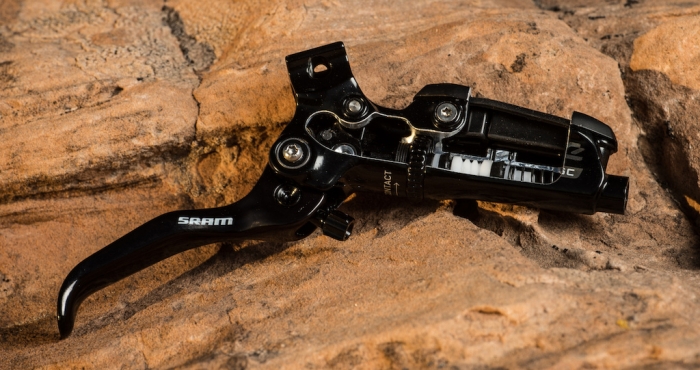
Дизайн TaperBore уступил место новому многорычажному механизму с кулачковым приводом и более традиционным дизайном мастер-цилиндра.
Объемы расширительного бачка и мастер-цилиндра увеличились по сравнению с тормозами Avid Elixir, это значит, что тормозной жидкости будет достаточно для компенсации износа колодок. Именно это не нравилось мне в предыдущем поколении Avid – то, как менялось ощущение на тормозной ручке, когда колодки стирались примерно на половину. Профиль расширительного бачка способствует удалению пузырьков воздуха из рабочего объема тормозной жидкости, а бутиловая мембрана заявлена как более гибкая и менее пористая.
Калипер и ротор
В отличие от абсолютно новой ручки, инженеры SRAM решили оставить проверенный временем 4-хпоршневой калипер. Калипер Guide идентичен калиперам тормозов Avid Trail, в нем установлены пара поршней диаметром 14 мм и пара 16 мм с органическими колодками в стоке. Отдельно доступны колодки металлик, и поскольку калиперы не изменились, вы можете ставить в Guide любые колодки от 4-хпоршневых Авидов.
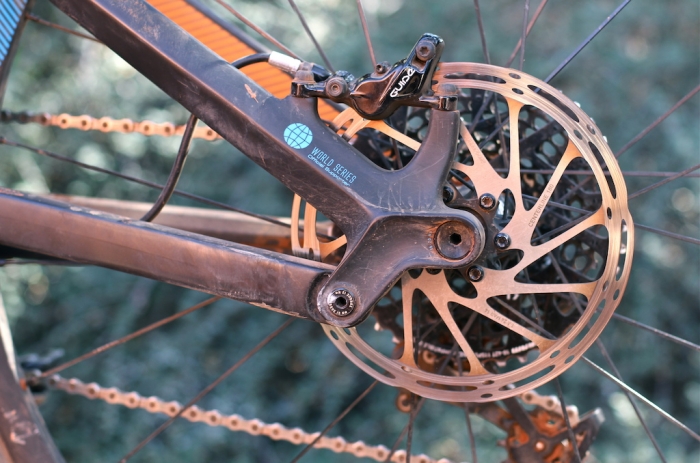
Четырехпоршневой калипер не новый, а вот ротор Centerline – новинка.
С новыми тормозами SRAM решили выпустить и новый ротор – Centerline, название отражает рисунок тормозной дорожки ротора с длинными продольными отверстиями посредине. SRAM заявляет, что такой дизайн способствует более быстрой очистке ротора и колодок от грязи. Также в новом роторе 12 спиц, в два раза больше, чем на HS1 роторе, что должно улучшить жесткость, а также охлаждение ротора. Доступны версии 140, 160, 180, и 200 мм, все со стандартным креплением под 6 болтов.
Установка и эргономика
Все тормоза SRAM Guide, которые я юзал во время тестов, были готовы к установке на байк «из коробки», и мне ни разу не пришлось их прокачивать, чего нельзя сказать о предыдущем поколении Avid. Все сводилось к установке ручки на руль и подбору удобного положения тормозного рычага с помощью крутилки в передней части ручки (напомню, в модели RS нет настройки холостого хода ручки). Хотя я не думаю, что крутил бы эту регулировку, если бы она была доступна в версии RS – холостой ход настроен оптимально (для меня). После долгих лет использования тормозов Avid, немного более короткая ручка тормозов Guide ощущается как родная, вообще лично я считаю, что эргономика тормозных рычагов SRAM одна из лучших на рынке.
Хотя у нас не было необходимости прокачивать тестовые тормоза, мы все же осуществили полную процедуру прокачки, чтобы посмотреть, действительно ли процедура стала более простой и эффективной по сравнению с TaperBore тормозами. Порядок действий не изменился, вам по-прежнему понадобиться два шприца, традиционные штуцеры Avid и тормозная жидкость. Прокачка занимает меньше времени, потому что хватает одной итерации, чтобы удалить весь воздух из системы и поменять DOT. Это большой прогресс по сравнению с предыдущим поколением Avid, прокачка которых требовала невероятного терпения.
Мощность
Я никогда не чувствовал, что у тормозов Avid не хватает мощности в условиях, для которых они предназначены, хотя я не отрицаю, что на рынке всегда были гораздо более мощные стоп-краны. Некоторым райдерам может и не хватало мощности, мне, 80 килограммовому райдеру с отличными навыками катания, никогда не хотелось чего то более мощного. Тормоза SRAM Guide обладают заметно большим запасом мощности, чем их предшественники. Может это и не «шимано-мощь», но ее вполне достаточно для того, чтобы я мог порекомендовать эти тормоза на байк для участия в Rampage. Все, кому не хватало мощности предыдущих тормозов Avid, должны быть счастливы с новыми Guide.
Мощность это здорово, но стабильность работы – совсем другое дело. Что толку, если тормоз может остановить поезд в первые несколько минут езды, если через 5 минут вы спалите колодки или вскипятите DOT? Такого не случалось с тормозами Guide, самые жесточайшие и длинные торможения никак не повлияли на их работу, разве что руки очень сильно уставали тормозить на длинных спусках. Я также попробовал разные наборы колодок, часто продолжая тереть их тогда, когда при обычном катании их пора бы поменять на новые, и я могу с уверенностью сказать, что работа тормоза абсолютна не изменялась при этом (разве что было заметно, когда колодки стирались до подложки). Конечно, вне тестов лучше избегать таких ситуаций и менять колодки вовремя.
Модуляция
Многие пользователи отвернулись от Avid из-за ненадежности предыдущего поколения тормозов при длительном использовании, но вопросов к модуляции и контролю тормозного усилия никогда не возникало. Тормоза управлялись буквально кончиком пальца, и это всегда было фишкой Avid: они были не такие мощные, как Shimano, но предоставляли невероятное чувство контроля тормозного усилия. Меня волновало, не увеличили ли инженеры SRAM мощность новых Guide в ущерб контролю. К счастью, этого не произошло, и новые тормоза дают все те же знакомые ощущения на кончиках пальцев, что и их предшественники Avid. Тот самый контроль, который я ценил в Avid, и по-прежнему легко можно почувствовать момент, когда нужно ослабить хватку, дабы избежать блокировки колес. Хотя в конце хода ручки ощущаются более жесткими, чем раньше, думаю, многим райдерам будет по душе такое изменение в работе нового тормоза.
Больше мощности не значит меньше модуляции, и новые SRAM Guide это доказали, они сохранили фирменный авидовский контроль.
SRAM Code RSC disc brake review
Lever feel, consistency, power and adjustment are all top-notch from SRAM’s most potent anchors.
SRAM Code RSC disc brake
Product Overview
Overall rating:
SRAM Code RSC disc brake
Product:
Manufacturer:
Price as reviewed:
The Code is SRAM’s most powerful disc brake, aimed at DH and enduro riding, traits that also make it ideal for controlling the extra weight of an e-bike. Over the years it has proven itself as one of the best MTB disc brakes on the market. It has four-pistons, larger pads and more oil volume compared to its trail-orientated stablemate, the G2.
Out of the box, the first thing I noticed about the new Code RSC disc brake is the lever/master cylinder are now super-sized. SRAM has increased the fluid volume by 30%, which should make the RSC more consistent under extreme conditions as well as more powerful. The cost of a rotor is not included in the price listed, but you now have the option of the new HS2 disc, which is slightly thicker and has different cooling.
SRAM Code RSC disc brake
There is a lot going on with the CODE RSC lever. First off, it comes with a Matchmaker X clamp, which allows you to bolt a SRAM shifter or dropper remote directly onto the lever, eliminating a clamp and the associated weight. I’m not a big fan of the Torx bolt, but I really like being able to free up some bar space.
On the face of the lever is the tool-free reach adjustment, which has a good range for different hand sizes and detents for the dial. The brake also features Contact Point adjustment that allows you to tune the firmness of the lever and reduce ‘deadband,’ which is the amount of lever movement before the brake engages.
Combined with the reach adjustment, it lets you keep a similar brake feel as the pads wear down. To reduce lever friction and prevent it getting sloppy over time, there’s a cartridge bearing in the main pivot. Remember to check the pivot bolt periodically as they can come loose.
At the other end, there’s a forged two-piece caliper, which features four slippery phenolic pistons and a stainless-steel heatshield in the brake slot. According to SRAM, this tiny addition helps break the thermal connection between the pad and the caliper body, reducing fluid temperature by about 20ºC. In other words, the Code should be more consistent on long descents as it won’t heat up as quickly, which causes brake fade and fluid expansion.
The brake pads are top loading and are now metal sintered as standard. In a lot of brakes I test the pads take several rides to bed-in, but the Code pads came up to full power almost instantly. However, in the wet you will need to do several hard stops to get some heat into them, because I found they can wear down to the backing plate in a single outing, although to be fair that’s a process you should do with all brake pads.
SRAM HS2 brake rotor
My sample Code RSC came with the new stainless-steel HS2 disc rotor, which has a thicker 2mm construction than the regular 1.85mm CentreLine rotor. To increase friction, it also has a redesigned brake track and there’s a special thermal grey paint on the spokes to boost heat-dissipation. SRAM says the HS2 rotor runs 40% cooler and is 7% more powerful, although I did the sums and it’s around 20% more expensive (and heavier too, if that’s important to you).
To bleed the Code you will need a SRAM kit. It uses DOT 5.1 fluid, which absorbs moisture, so you will need to bleed them more regularly than a brake that uses mineral oil. The process requires some preparation, but there are plenty of how-to videos online and it’s not too heinous a task once you’ve done it a few times.
Once fitted to our test bike, our initial impressions of the SRAM Code RSC disc brake were how noticeably firm it felt as you grabbed the lever. Brake feel with the CODE RSC is one of the best out there – it has incredibly light lever action but the power builds progressively, so you don’t have to pull too hard and there’s always something in reserve. The lever has a great shape and there’s plenty of grip. With the Matchmaker integration you really don’t have to compromise on where you position your levers or controls either.
As the Code comes standard on so many bikes, we’ve ridden multiple sets and never had an issue with inconsistency or failure. The only issue we’ve had is the pistons getting a bit sticky in the caliper with age, but this can be cured by working them in and out with a plastic tyre lever and a bit of brake fluid.
Verdict
If you do any sort of gravity riding like enduro, downhill or even aggressive trail riding, or you’re running a heavy e-bike, the Code is the best brake in the SRAM arsenal and the one to get. At over £300 a wheel I can’t give the RSC model top marks for value, but the feel and power are outstanding and there is a cheaper Code R model that forgoes the Contact Point adjuster and bearing lever pivot. But, if you’ve got the cash, those details make the RSC worth the premium, and it also looks super nice in black with those oil slick accents.
SRAM Code Rsc Disc Brake
Want To Know More About This Bike?
Availability? Specifications? Sizing?
Leave your contact information below and one of our Gear Advisors will be in touch.
ADDED TO YOUR CART
ADDED TO YOUR WISHLIST
Error
Accident Protection From 
Add a little peace of mind to your purchase with a protection plan from EXTEND. Full accident protection coverage available right away and even after your manufacturer’s warranty expires.
Features:
We’ll replace or repair your damaged product. Unintentional breaks, drops, or spill are all covered.
When regular use of your product over time results in mechanical or electrical failure.
No fees. No deductibles. No hidden costs when we repair your product.
Customer focused support
We’re always happy to help, and available 24/7
Protect Your Purchase From Drops, Breaks And Defects With Extend.
Accident Protection Offered from
Request a Price Match
Terms & Conditions
We strive to get you the gear you want at a competitive price. If you find an item we offer from a competitor at a lower price, let us know. We will do our best to instantly match their price. To qualify for the Price Match, your purchase must meet the following conditions:
Report Incorrect Product Information
SRAM Code RSC Brakes
Using the awesome new SwingLink cam system, SRAM’s Code RSC brakes give you more pad contact and control, with less lever throw. Stay in control of your speed, and powerful and sensitive brakes that are sufficiently tunable to your preferences. Even under extreme conditions, rough terrain, or excessive use, the RSC continues to perform well, no matter what. With an all new, forged dual-diameter, four-piston caliper, CODE RSC comes through with increased power, and without compromising control or feel. With a simplified design and an extra sleek finish, CODE RSC maintains the CODE family values of reliability, strength, and exceedingly convenient serviceability. Now featuring the improved braking performance of Bleeding Edge Technology that updates and simplifies the fluid pattern and bleed porting to make it easier to push through the caliper.
Features

Jenson USA ships worldwide, including APO/FPO addresses. For a quote, simply add the items you are interested in to your shopping cart and look for the «Shipping Options» box. You don’t have to login or create an account to see shipping charges.
Some manufacturers restrict where we can ship their products. If this item has shipping restrictions, they are listed below. If you’d like to buy an item that we cannot ship to your preferred address, we can accept your foreign credit card and ship to a USA address for you.
Sram Code R Задние тормоза
Объявленная цена: 8531.02руб
Приобретите этот товар и заработайте 109 CoINNs / 66.18 руб
Продано и отправлено:
Поделиться в WhatsApp
Добавить в список желаний
Доступны другие цвета


Смотрите другие товары, похожие на:
Цвет: Черный
Тип продукта: Наборы
Рекомендации по применению: Горный велоспорт
Тип тормоза: Дисковые тормоза
Описание товара Sram Code R Задние тормоза
SRAM Дисковой тормоз «Код R» гидравлический, 4 поршневых суппорта тормоза, алюминиевый тормозной рычаг, корпус тормозного рычага, корпус суппорта и поршень, регулировка ширины рычага, совместимость с MatchMaker X, тормозная жидкость DOT 5.1, металл, спеченные тормозные колодки. Ротор и адаптер не входят, матовый черный
Приглашаем ознакомиться с нашей Sram Code R Задние тормоза специальной сделкой. В bikeinn вы найдете не только лучшую цену для своего велосипед оборудования, но и лучшую экспертную информацию на велосипед товар, который собираетесь приобрести. Цены на товар актуальны и доступны необходимые фильтры, позволяющие сравнить аналогичный товар из топ категорий, как Тормоза.
NEW SRAM G2 Ultimate and RSC Brakes [Video]
SRAM G2 Ultimate and RSC Brakes
The evolution of the SRAM brake line continues with the introduction of the new G2 Ultimate and RSC brakes. Moving into the second generation of Guide, which is where the G2 moniker comes from, the G2 brake is completely redesigned, increasing power and lever feel. It’s no secret there were previous issues with older SRAM/Avid brakes, but those should have been long forgotten with the introduction of the Guide, Level, and Code brakes. A generation of riders were converted after SRAM proved the power and reliability were there to stay. Guide brakes have been the staple for the SRAM brake line for a few years now, going on bikes from light trail rigs to even DH bikes for a while. The Levels have been reserved for XC extremists and Code brakes eventually found their home on DH bikes and some big, aggressive trail riders’ bikes. G2 builds on the success of the Guides, which now in its second generation offers some amazing improvements.
The New G2 brake is being called the “mini Code”, and while the power has been increased by about 7%, these are now the lightest four-piston production brakes.
What’s New
Well, the entire G2 brake has been redesigned so really it’s all new, but some of the main improvements are to the caliper, which suffers from less flex, less pad pocket, and a better piston seal caliper interface. Also, there is a new brake hose, new lever bearings, and bushings as well as an all-new brake pad compound called “Power Organic”.
Caliper
The caliper has been fully redesigned, taking what was implemented in the new Code caliper and moving it into the G2 package. There is a smaller pad pocket area, as well as the mounting points for the caliper, have been increased, creating less flex. The square piston seals have not changed but rather the amount of movement has been improved, and now controlled piston movement through the seals allows for consistent piston roll back and pad advancement. The calipers also use Phenolic Pistons, which eliminates the need for the HeatShield that was previously used in Guide S4 calipers.
”Power Organic” Brake Pads
The addition to the brake pad line now includes the Power Organic brake pad. A new compound that provides more power than the original organic pad previously used, but still quieter than a metallic pad. This new pad will have a Lunar grey backing to help separate it visibly from other pads, and will also be available as an aftermarket upgrade to slap in your Guide brakes. There will still be the organic and metallic pad options, and pad shape has remained the same from Guide to G2.
Lever
The leverage rate and lever feel have not changed, as SRAM wanted to keep the same feeling that everyone has come to like with the Guide however, the pivot bushings and bearings have been updated. For the RSC, a new pivot dowel and bushings provide a stiffer connection that is felt through the lever, as well as some refined small parts that allow SRAM to lower the cost a bit on RSC brakes. For the Ultimate, there is new pivot bearings and a carbon blade that helps for a stiffer and snappier lever feel, helping reduce finger fatigue on the longest, steepest descents.
How Do They Perform?
We have been on the G2 RSC brakes for a few weeks now, and also had a solid multi-hour ride on the Ultimates as well. Coming from SRAM Code brakes, there wasn’t much getting used to how the power is delivered, but also I was slightly skeptical as the Code brakes deliver a punch of power and I’ve really come to love the Code brake. The G2 really is the new “mini Code” as SRAM calls it. Initially, we went out and rode some of the steepest trails we have close to our shop in SoCal. Midway down the trail I had a hard time realizing I wasn’t braking with Code brakes.
The power is very consistent and the lever feel is greatly improved. SRAM said this isn’t a brake revolution, rather an evolution, and they are exactly right. It’s a solid step forward in braking power, about 7% actually. While 7% might not sound like a lot, I’d bet you’d take huge issue if you experienced a 7% loss in power with your current brakes. In other words, that small percentage is worth rejoicing over.
My favorite aspect of the new G2 brake is the new lever feel. It really is a bit snappier and has a great positive feel with a solid stop when the pads are fully engaged. Going from the Code to the G2, I could happily ride the G2 on my current 150mm trail bike on the steepest terrain. There were no issues with brake fade, power loss, or just not enough power. The G2 brake is a great second generation and really is the new “mini-Code”.
Pricing and Weights
Final Thoughts
The G2 brake is an amazing step forward and redesign of the original Guide brake. With all new parts, increasing power by 7%, and a new brake pad compound, Sram really hit the target. With competitive pricing and being some of the lightest 4 piston brakes on the market, backed by one of the best brands in the industry, it’s hard to have anything bad to say. The G2 RSC and Ultimate brakes are a great option for your current trail or enduro bike.
Источники:
- http://trial-sport.ru/goods/1499361.html
- http://www.sram.com/en/sram/models/db-code-rsc-a1
- http://www.sram.com/en/sram/mountain/series/code
- http://trial-sport.ru/goods/2041087.html
- http://trial-sport.ru/goods/2041089.html
- http://trial-sport.ru/goods/1499359.html
- http://twentysix.ru/company/alienbike/blog/130599.html
- http://nsmb.com/articles/sram-code-rsc-brakes-long-term-review/
- http://zarulemvelosipeda.ru/2021/08/18/obzor-diskovyh-tormozov-sram-code-rsc-samye-moshhnye-tormoza-sram/
- http://www.bikemag.com/gear/components/brakes/first-impressions-sram-code-rsc-brakes/
- http://www.worldwidecyclery.com/blogs/worldwide-cyclery-blog/how-to-bleeding-sram-code-rsc-brakes
- http://www.worldwidecyclery.com/blogs/worldwide-cyclery-blog/sram-vs-shimano-brake-buyers-guide-the-ultimate-comparison-video
- http://www.mtb-mag.com/en/tested-sram-code-rsc-brakes/
- http://off.road.cc/content/review/brakes/sram-code-rsc-disc-brake-1322-review
- http://www.tradeinn.com/bikeinn/ru/sram-code-rsc-%D0%97%D0%B0%D0%B4%D0%BD%D0%B8%D0%B5-%D1%82%D0%BE%D1%80%D0%BC%D0%BE%D0%B7%D0%B0/136474087/p
- http://www.sram.com/fr/sram/models/db-code-rsc-a1
- http://www.sram.com/de/sram/models/db-code-rsc-a1
- http://enduro-mtb.com/en/sram-g2-vs-code-review/
- http://www.sram.com/en/sram/models/db-code-r-b1
- http://off.road.cc/content/buying/your-complete-guide-to-sram-mountain-bike-disc-brakes-level-t-tlm-ultimate-guide-r-rs
- http://thelostco.com/blogs/blog/brake-comparison-code-rsc-dhr-evo
- http://trial-sport.ru/goods/2041083.html
- http://www.pinkbike.com/forum/listcomments/?threadid=211980
- http://www.worldwidecyclery.com/blogs/worldwide-cyclery-blog/sram-code-rsc-disc-brake-rider-review
- http://www.worldwidecyclery.com/blogs/worldwide-cyclery-blog/sram-code-rsc-brake-review
- http://au.thelostco.com/blogs/blog/brake-comparison-code-rsc-dhr-evo
- http://lakkroll.ru/tormoza-sram-code-rsc/
- http://trial-sport.ru/goods/2041085.html
- http://www.bikemag.com/gear/components/brakes/versus/
- http://www.tradeinn.com/bikeinn/ru/sram-code-rsc-%D0%9F%D0%B5%D1%80%D0%B5%D0%B4%D0%BD%D0%B8%D0%B5-%D1%82%D0%BE%D1%80%D0%BC%D0%BE%D0%B7%D0%B0/136474086/p
- http://www.tradeinn.com/bikeinn/ru/sram-code-r-rsc-kit/137076025/p
- http://www.starbike.com/en/sram-code-rsc-disc-brake-black/
- http://off.whip.live/bike/bike-magazine-first-impressions-sram-code-rsc-brakes
- http://enduro-mtb.com/en/best-mtb-disc-brake-can-buy/
- http://www.bike-components.de/en/SRAM/Code-RSC-Disc-Brake-Set-p56579/
- http://zarulemvelosipeda.ru/2021/05/12/obzor-linejki-tormozov-dlya-gornyh-velosipedov-sram/
- http://fortheriders.com/blogs/news/sram-code-rsc-brake-review
- http://www.pinkbike.com/forum/listcomments/?threadid=211980&pagenum=2
- http://www.worldwidecyclery.com/blogs/worldwide-cyclery-blog/sram-code-rsc-disc-brake-rider-review-1
- http://lang-rus.bicycle-works.com/first-ride-sram-g2-rsc-brakes-872572
- http://biketestreviews.com/sram-mtb-disc-brakes/
- http://www.emtbforums.com/community/threads/sram-code-rsc-pads-clearance-adjustment-possible.10691/
- http://twentysix.ru/blog/stuff/114736.html
- http://www.mbr.co.uk/reviews/disc-brakes-products/sram-code-rsc
- http://www.jensonusa.com/SRAM-Code-RSC-Disc-Brake
- http://www.tradeinn.com/bikeinn/ru/sram-code-r-%D0%97%D0%B0%D0%B4%D0%BD%D0%B8%D0%B5-%D1%82%D0%BE%D1%80%D0%BC%D0%BE%D0%B7%D0%B0/136474089/p
- http://www.worldwidecyclery.com/blogs/worldwide-cyclery-blog/sram-g2-ultimate-and-rsc-brakes


